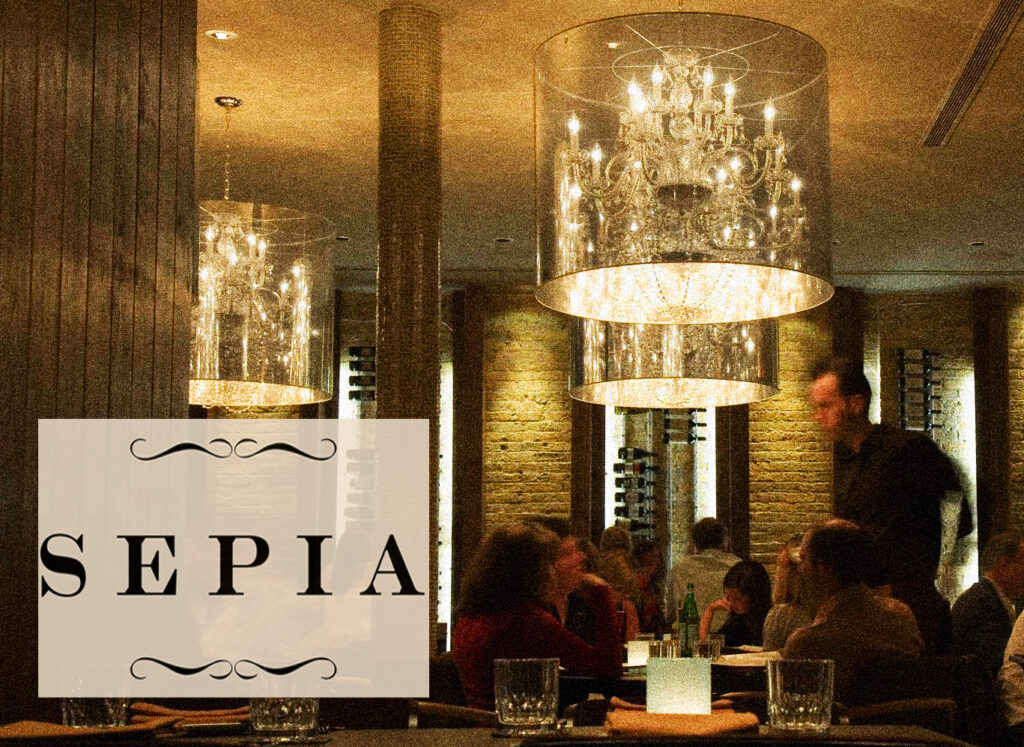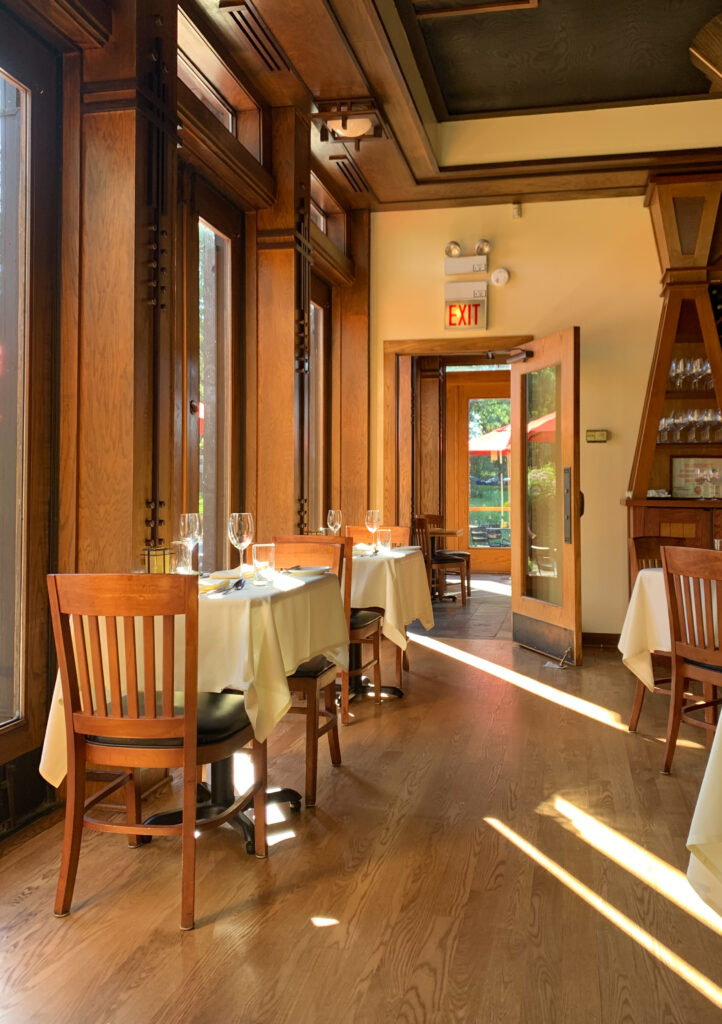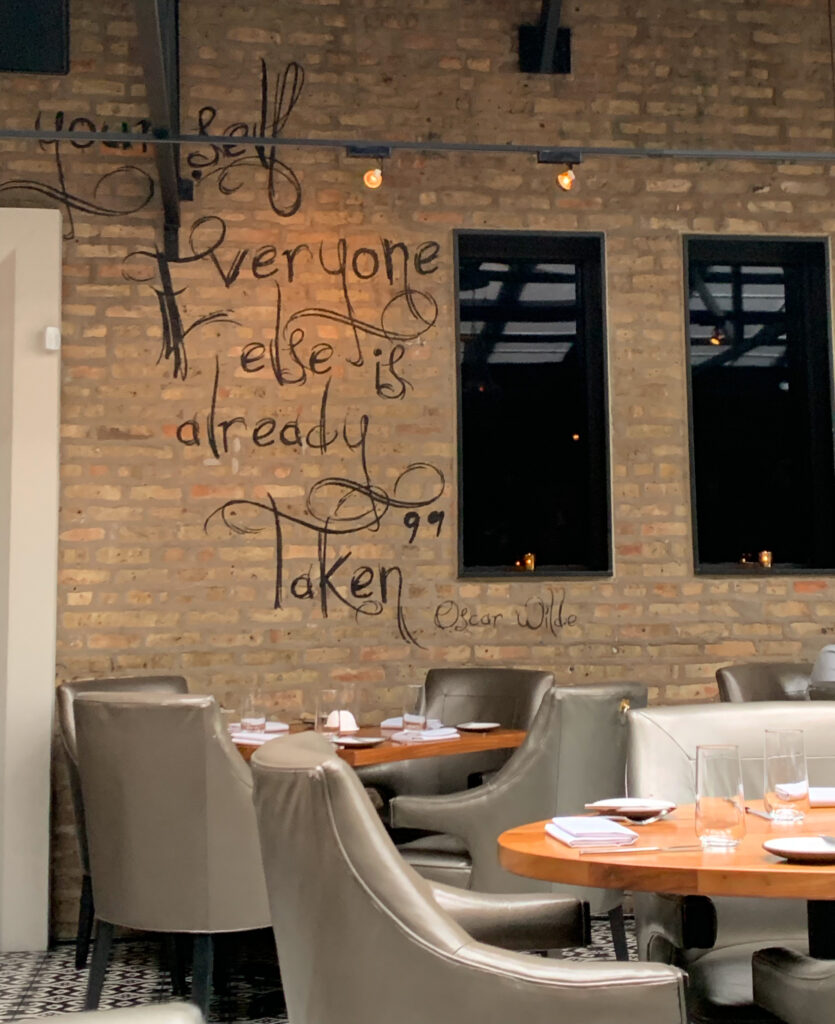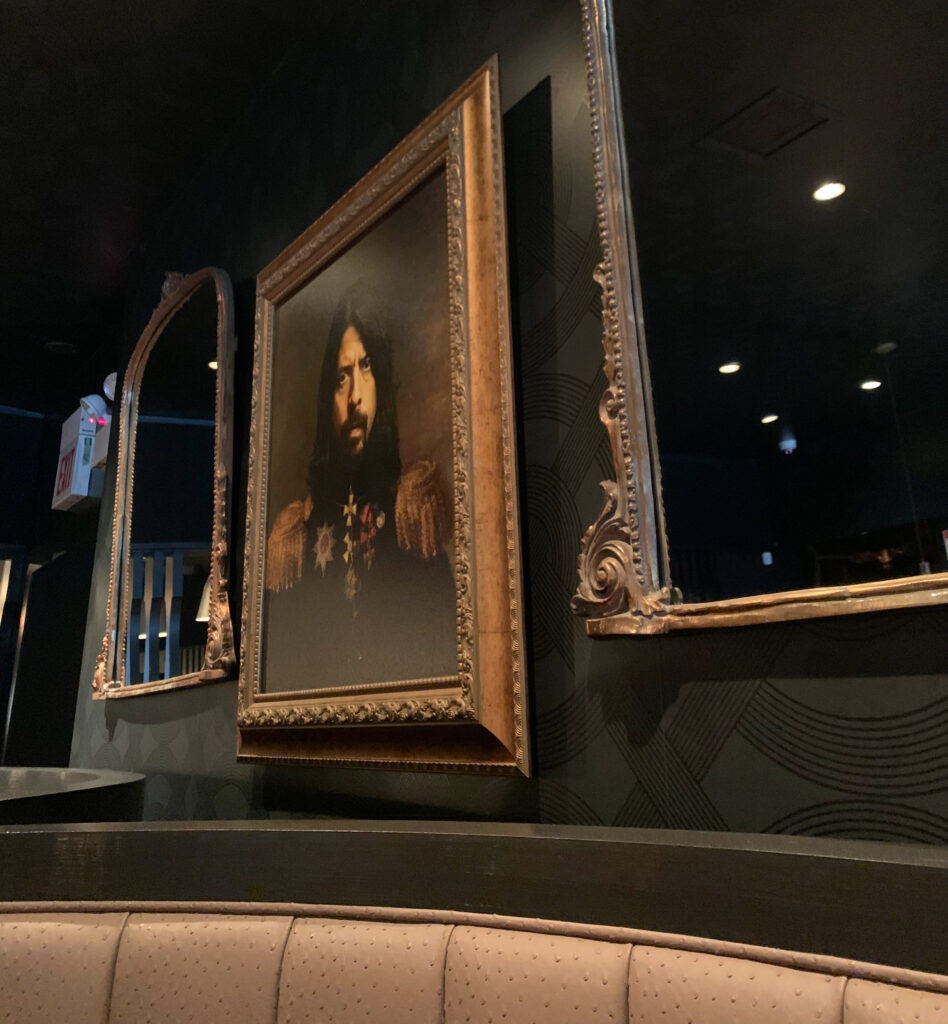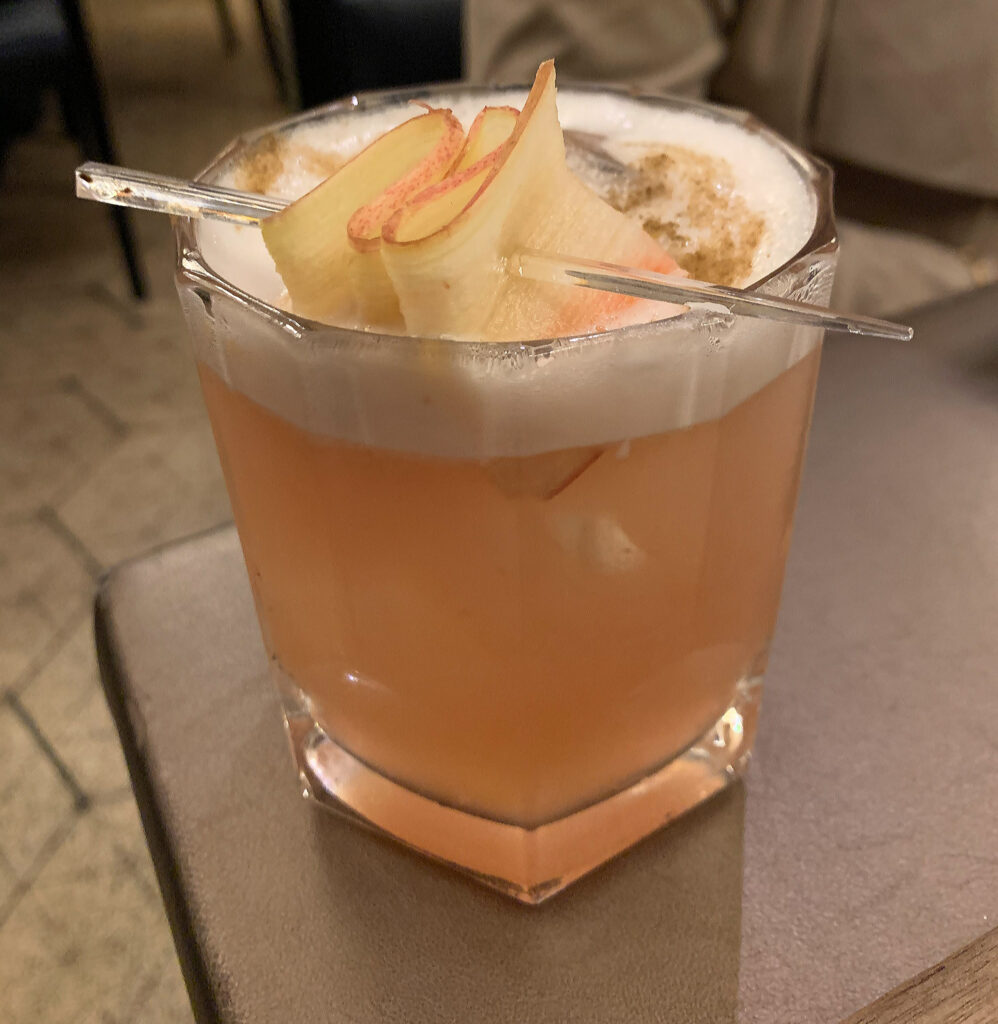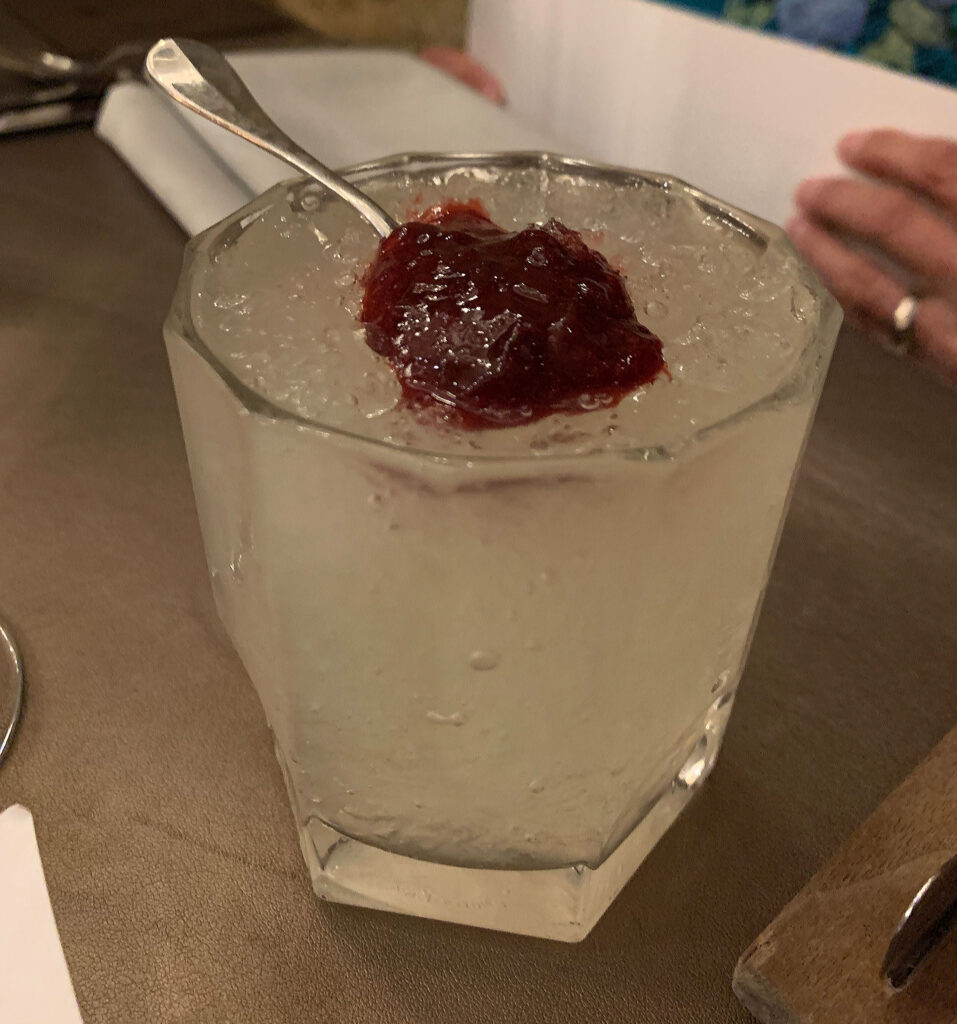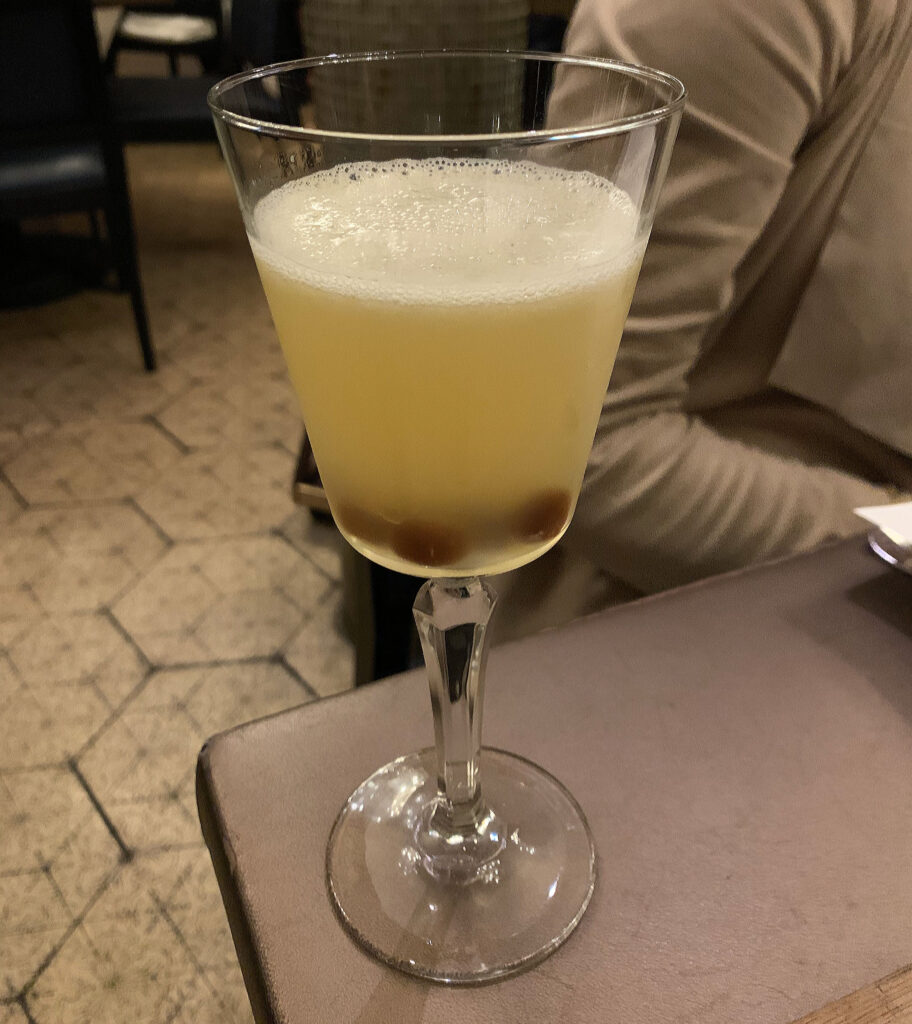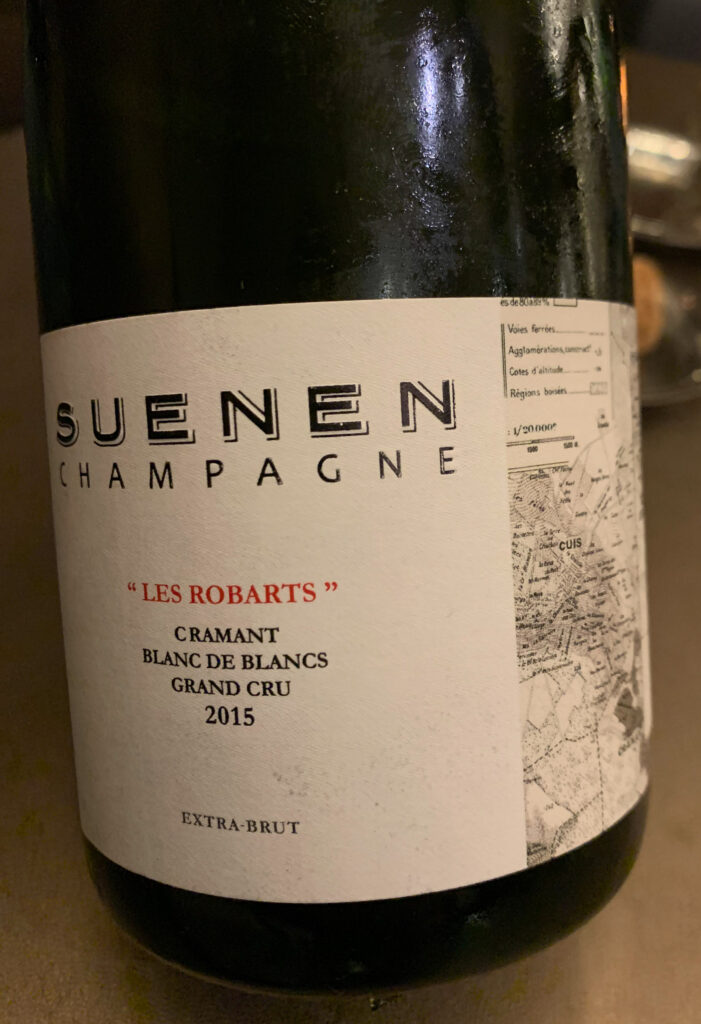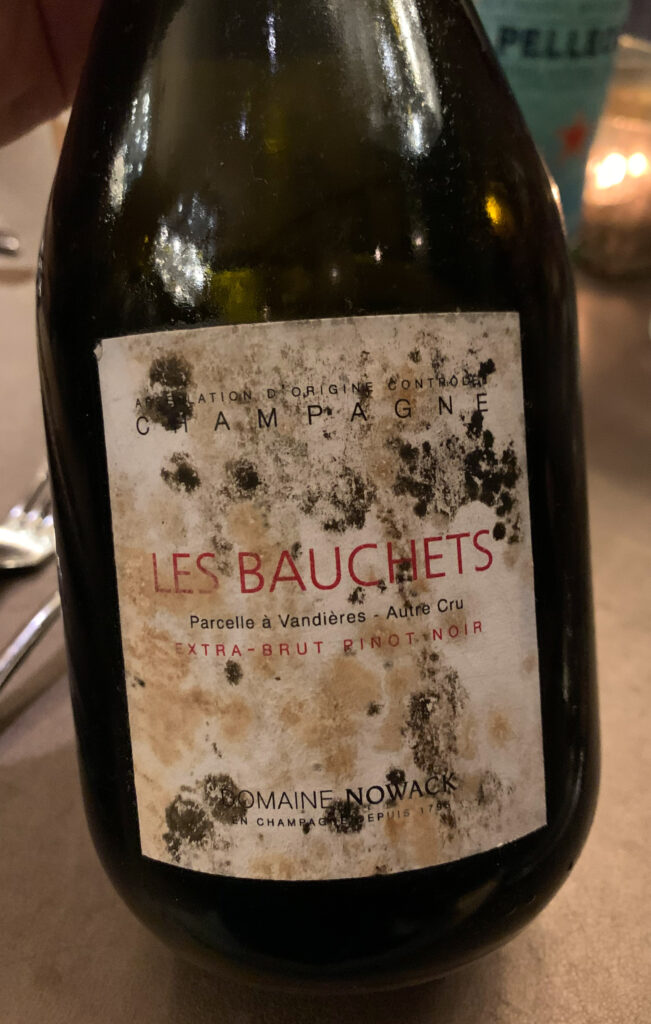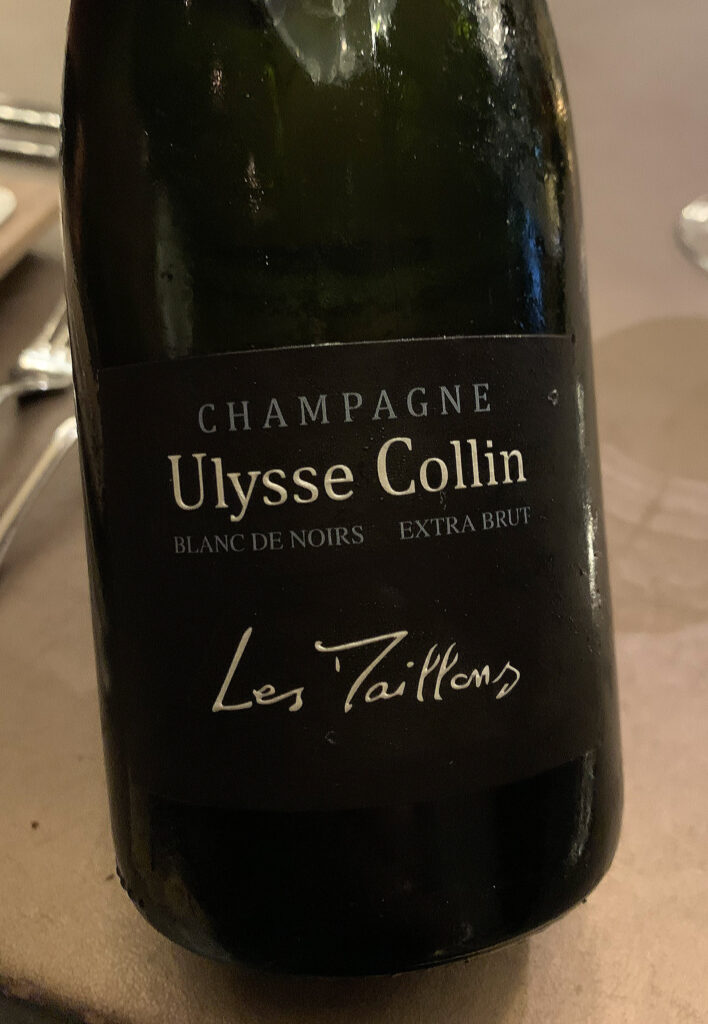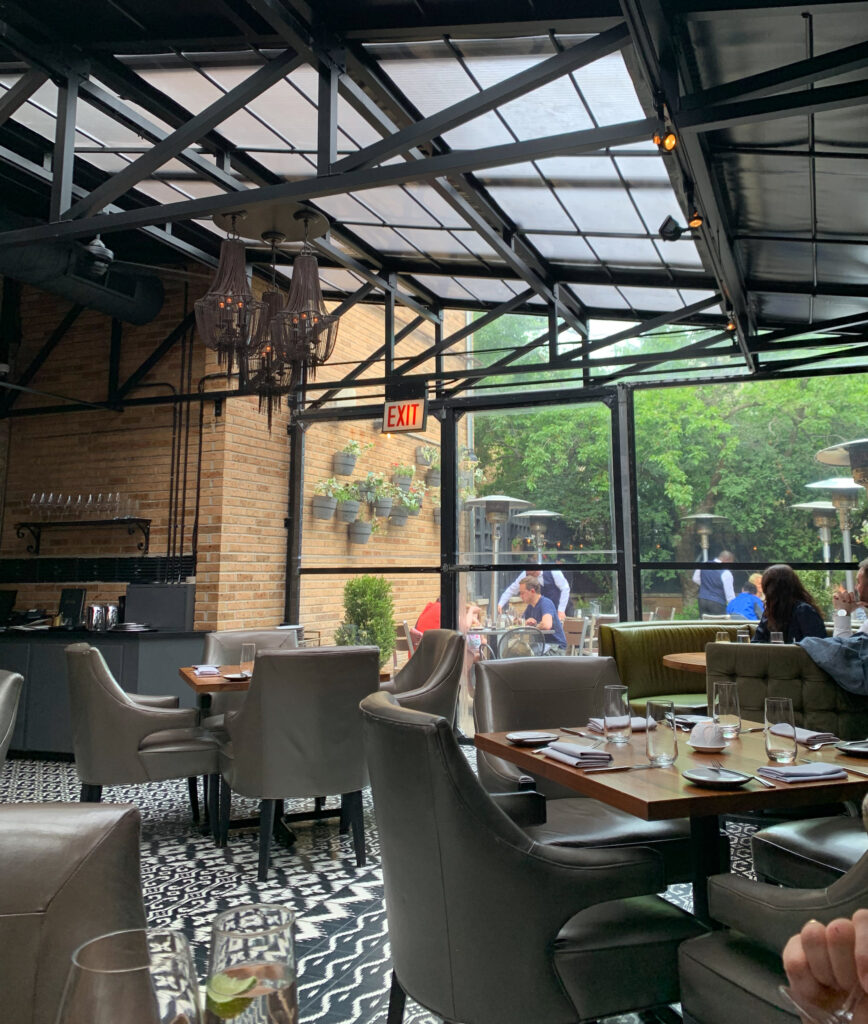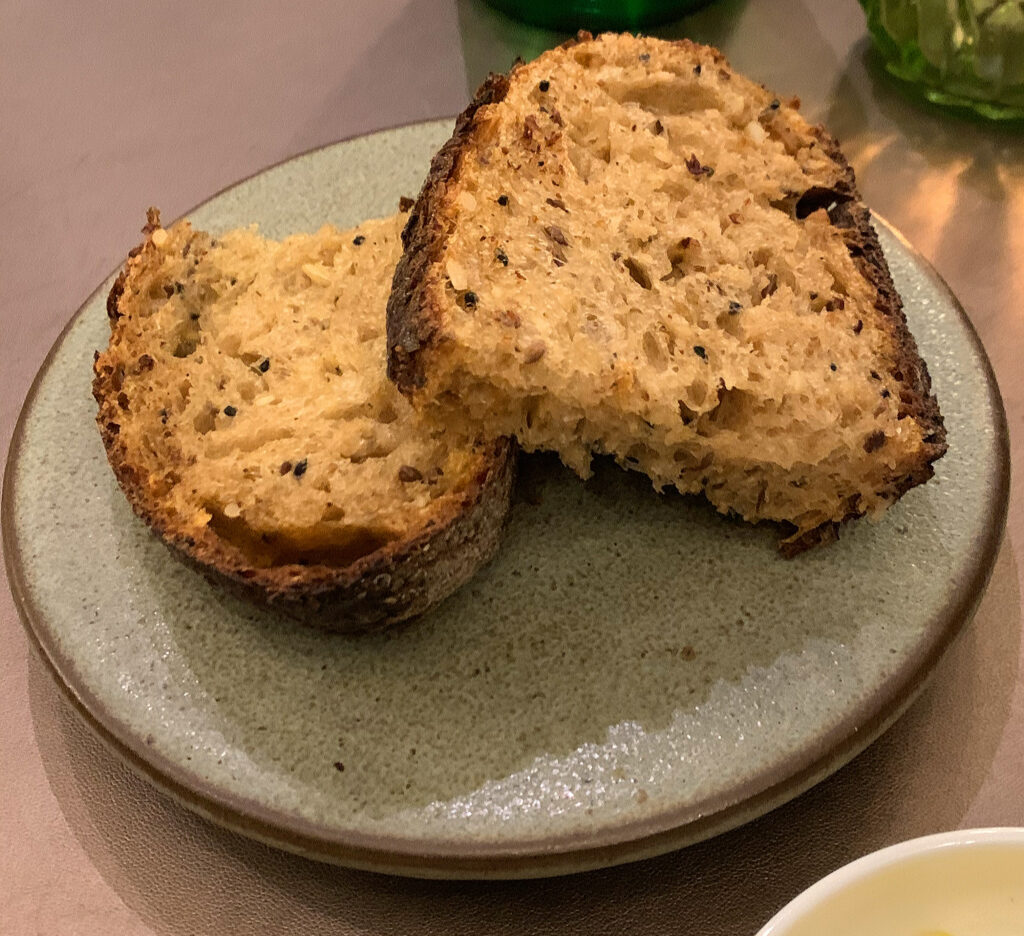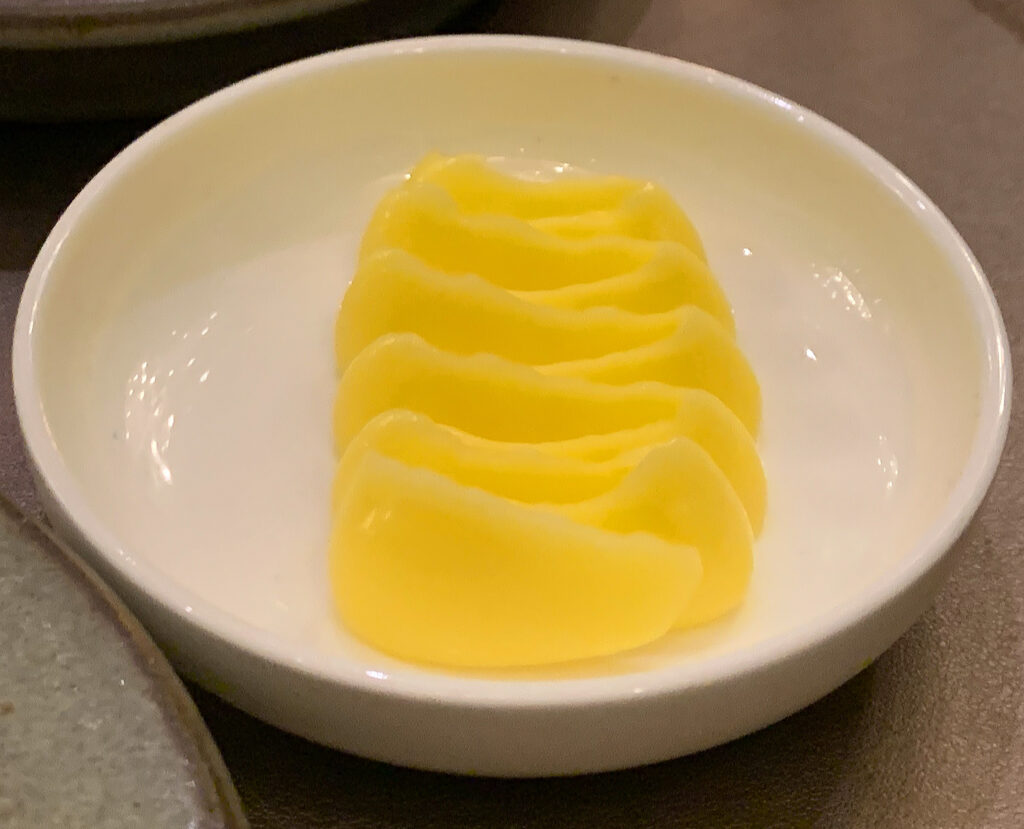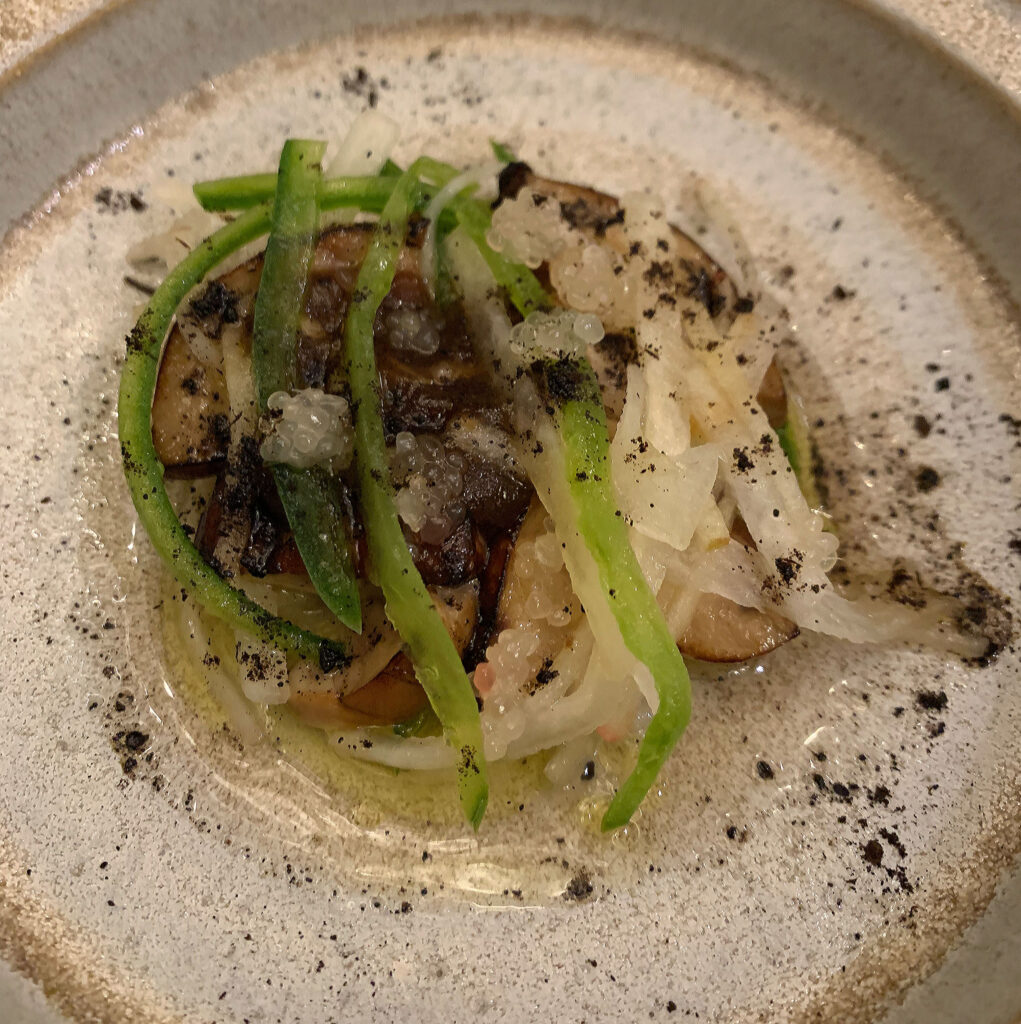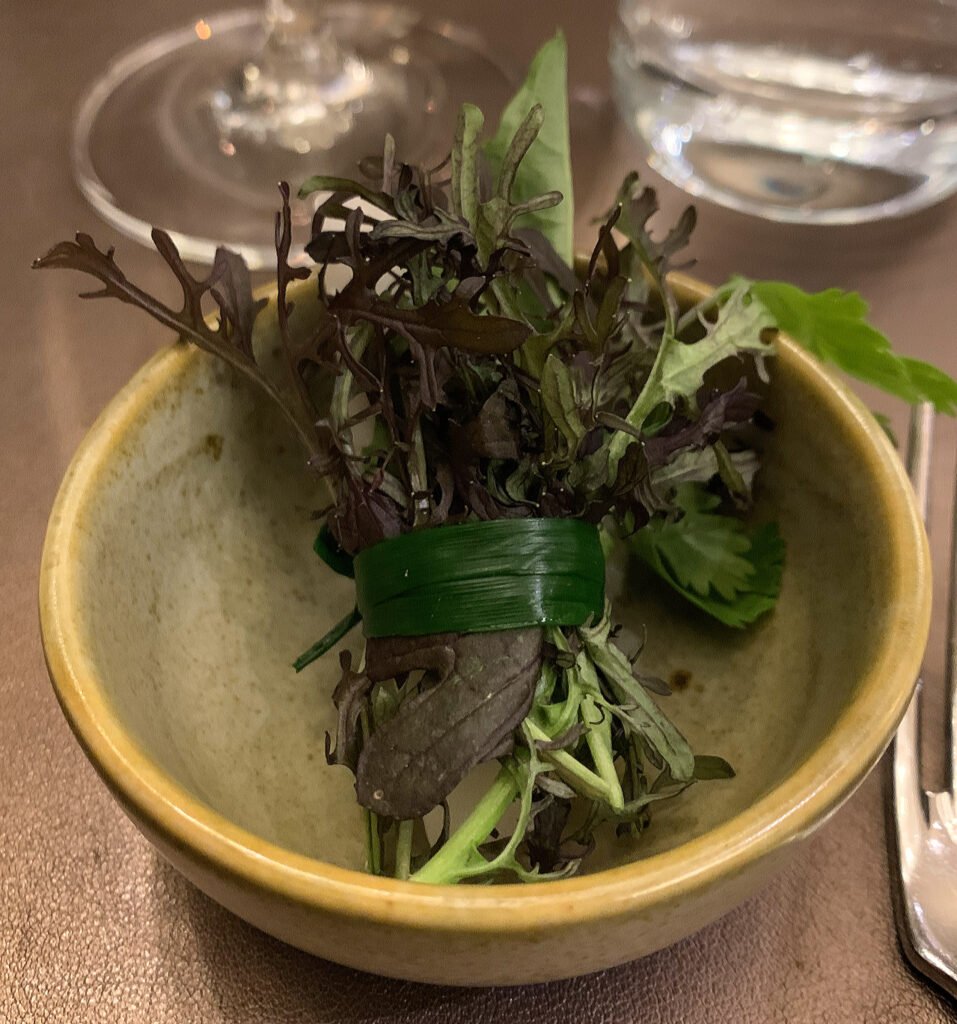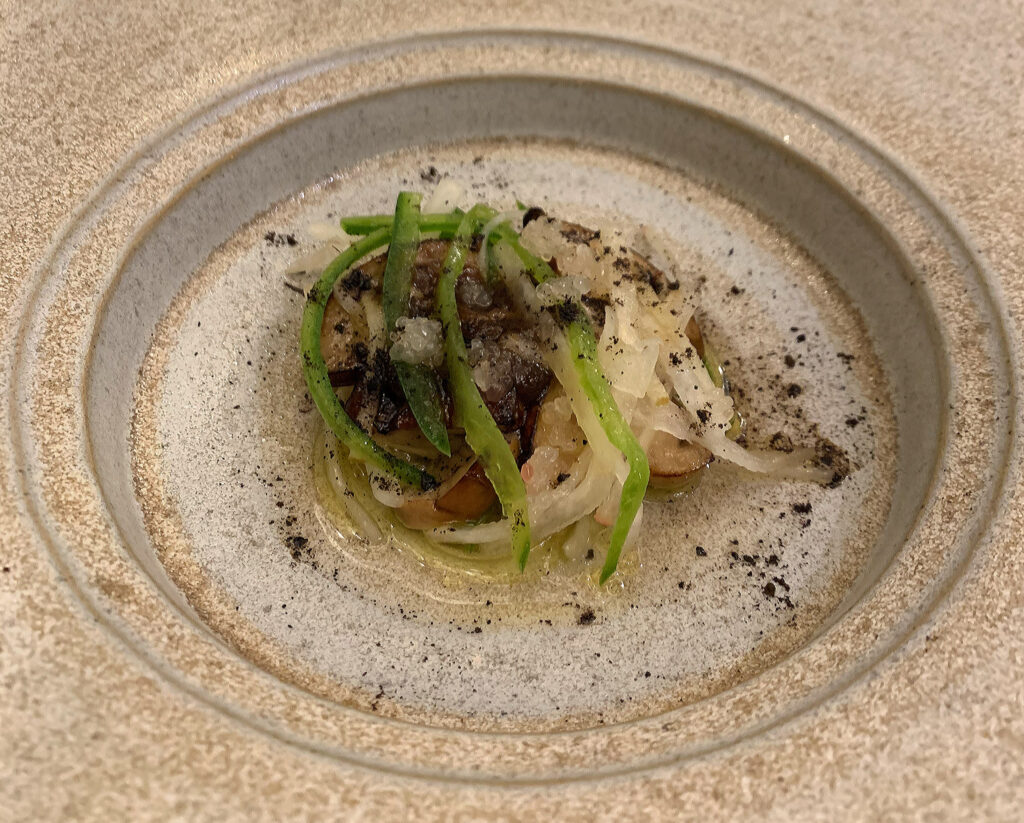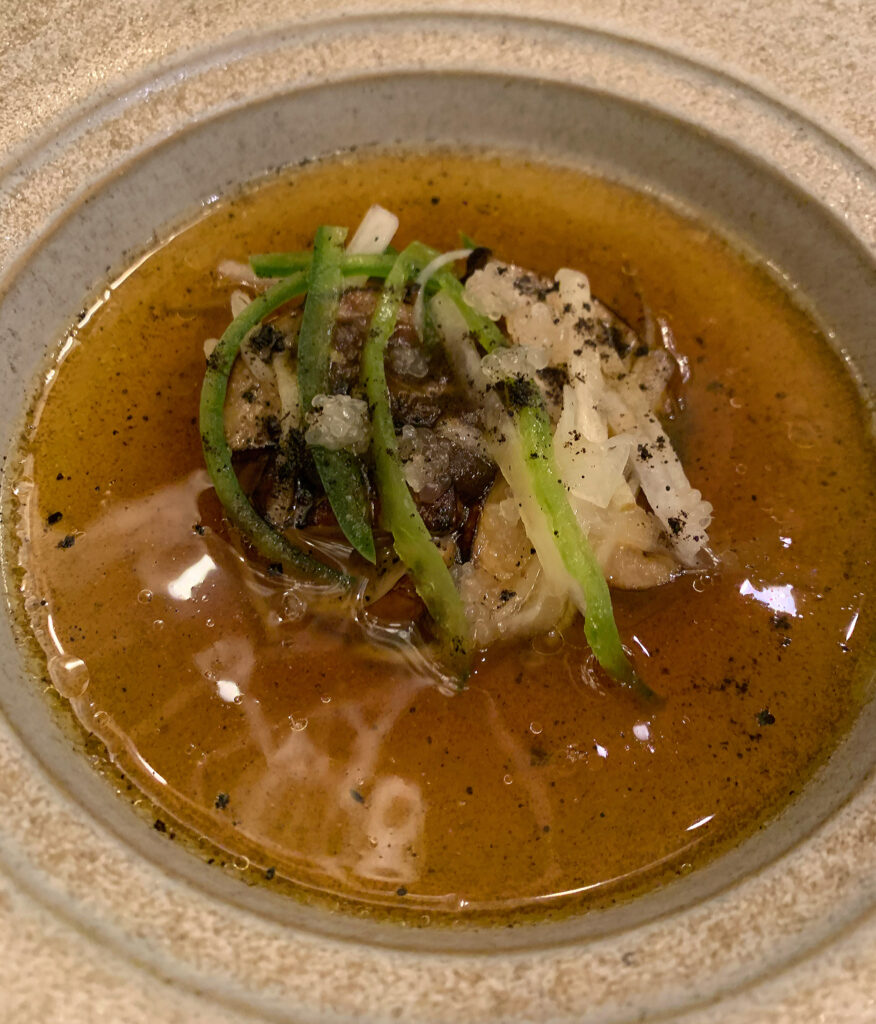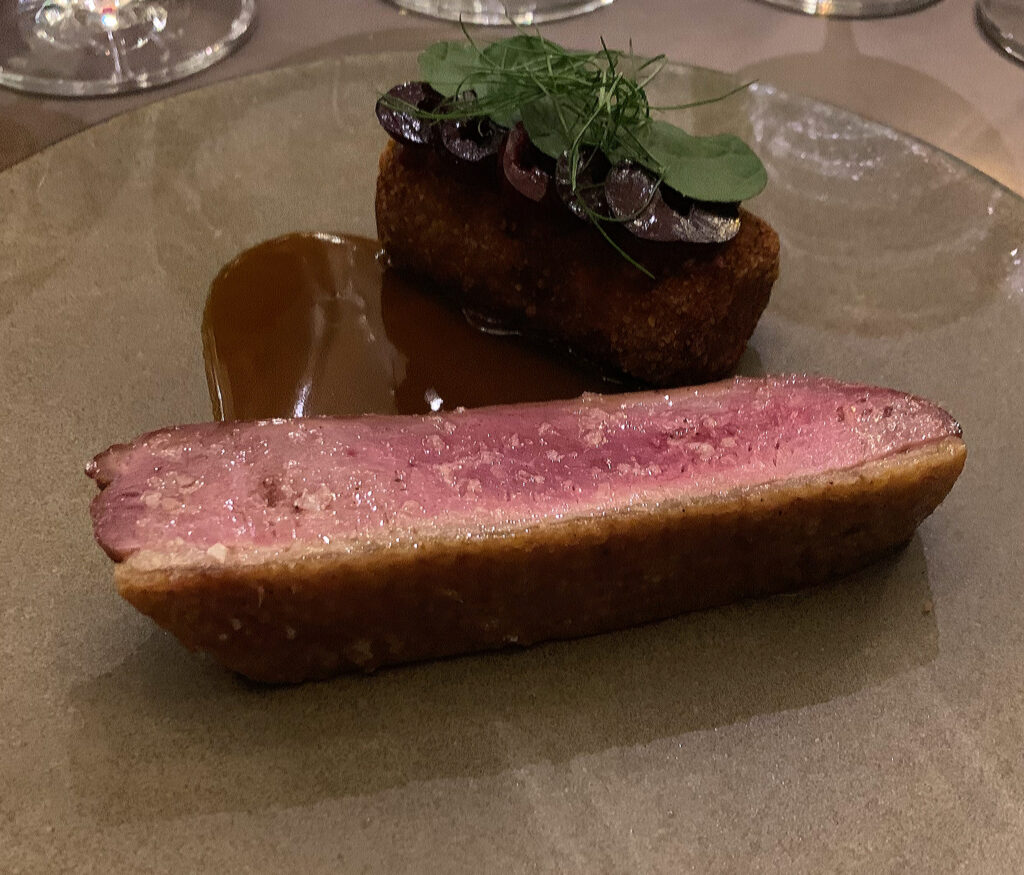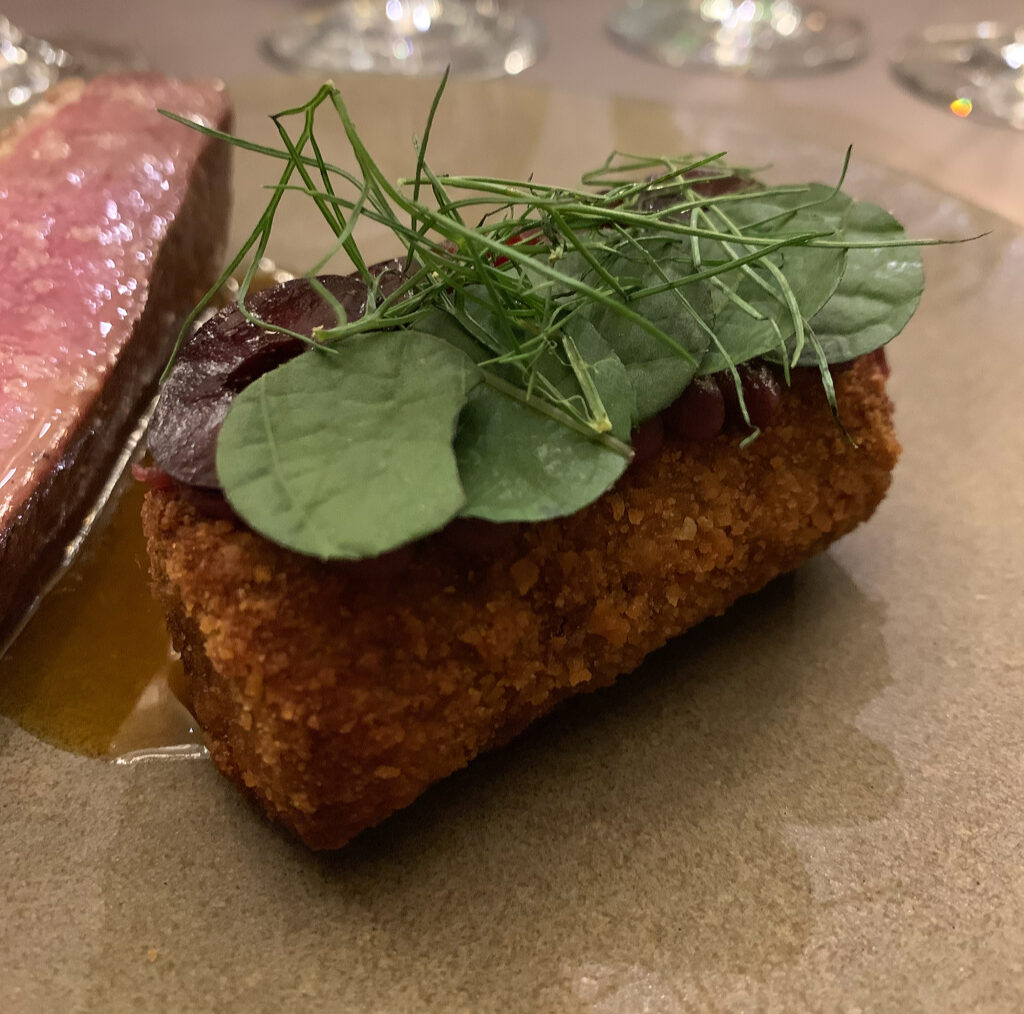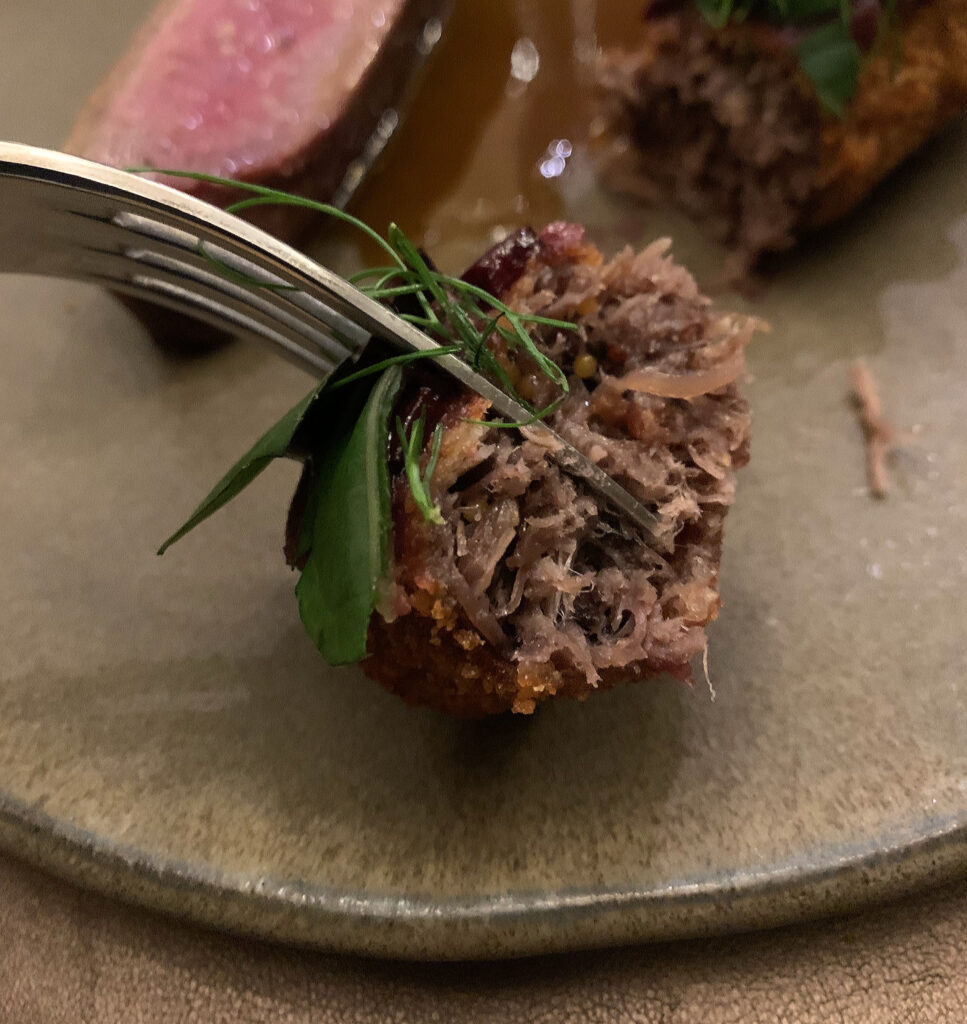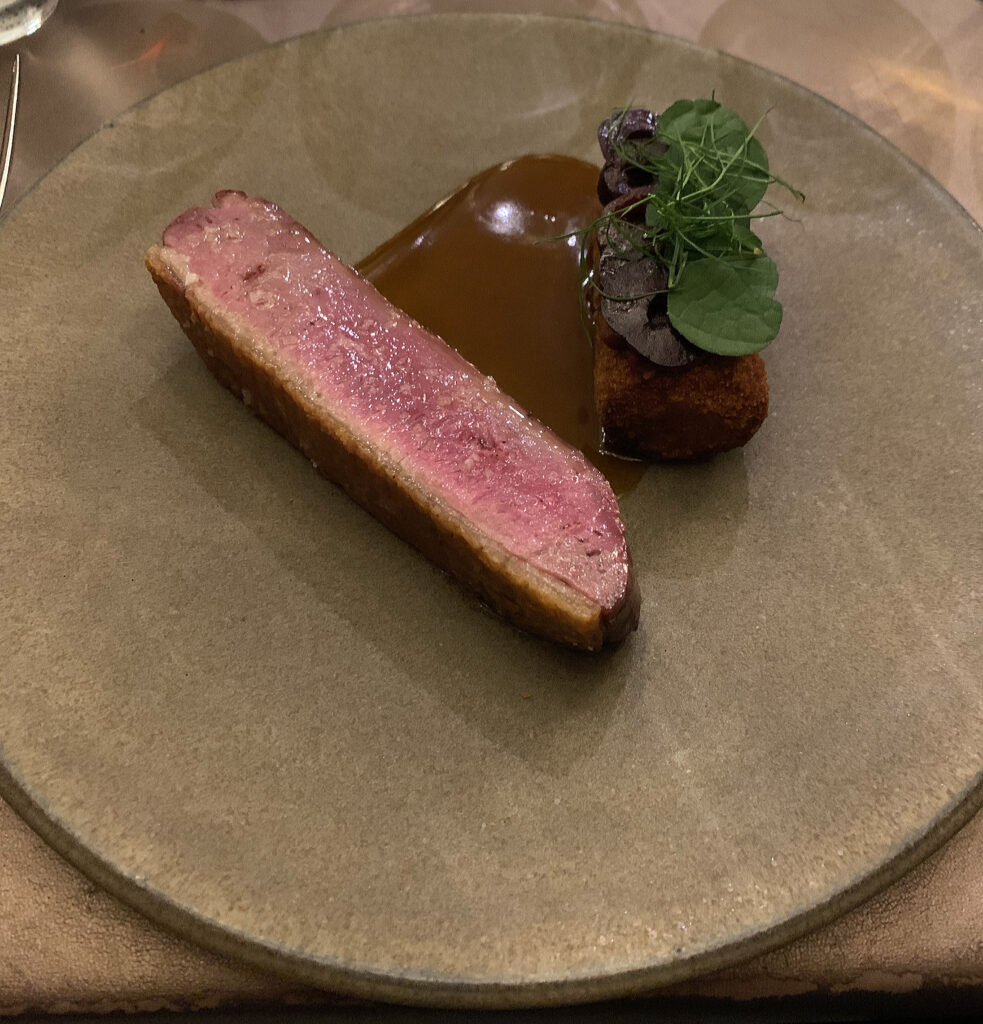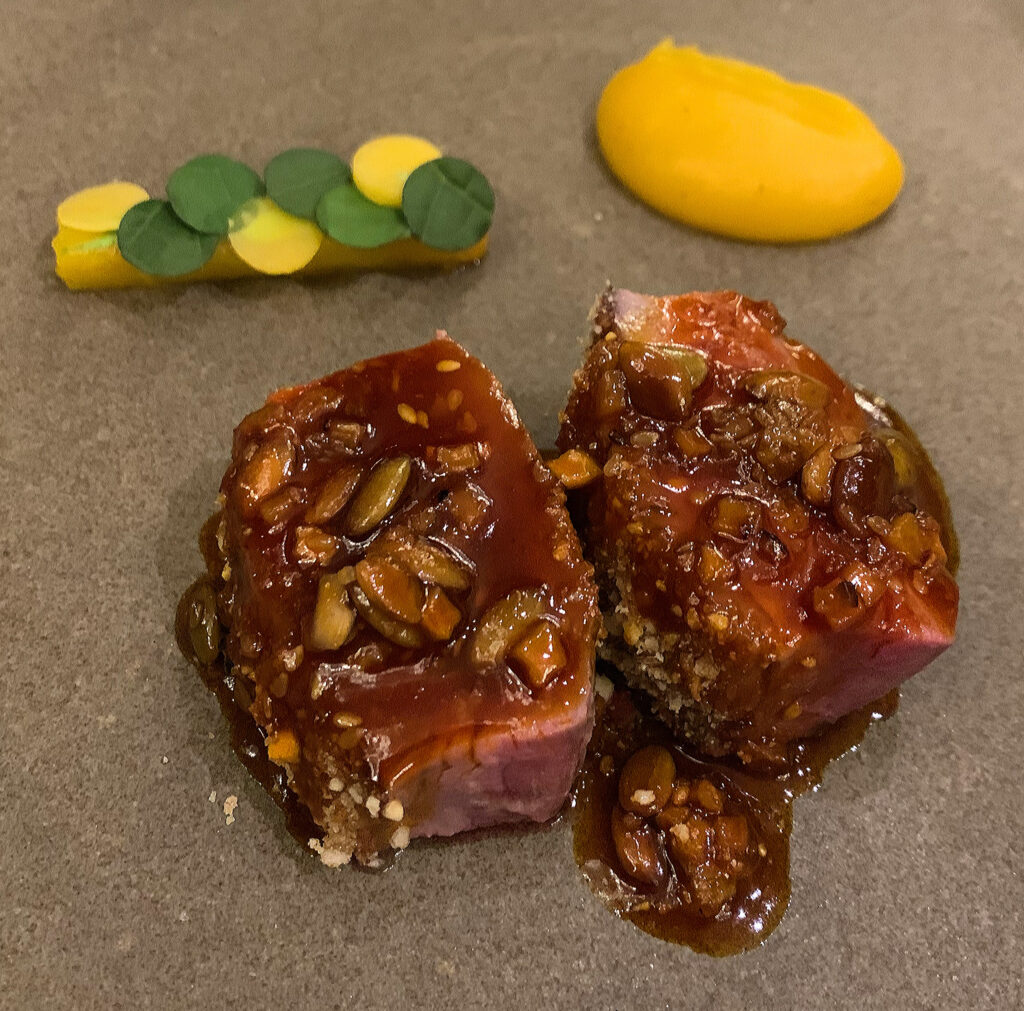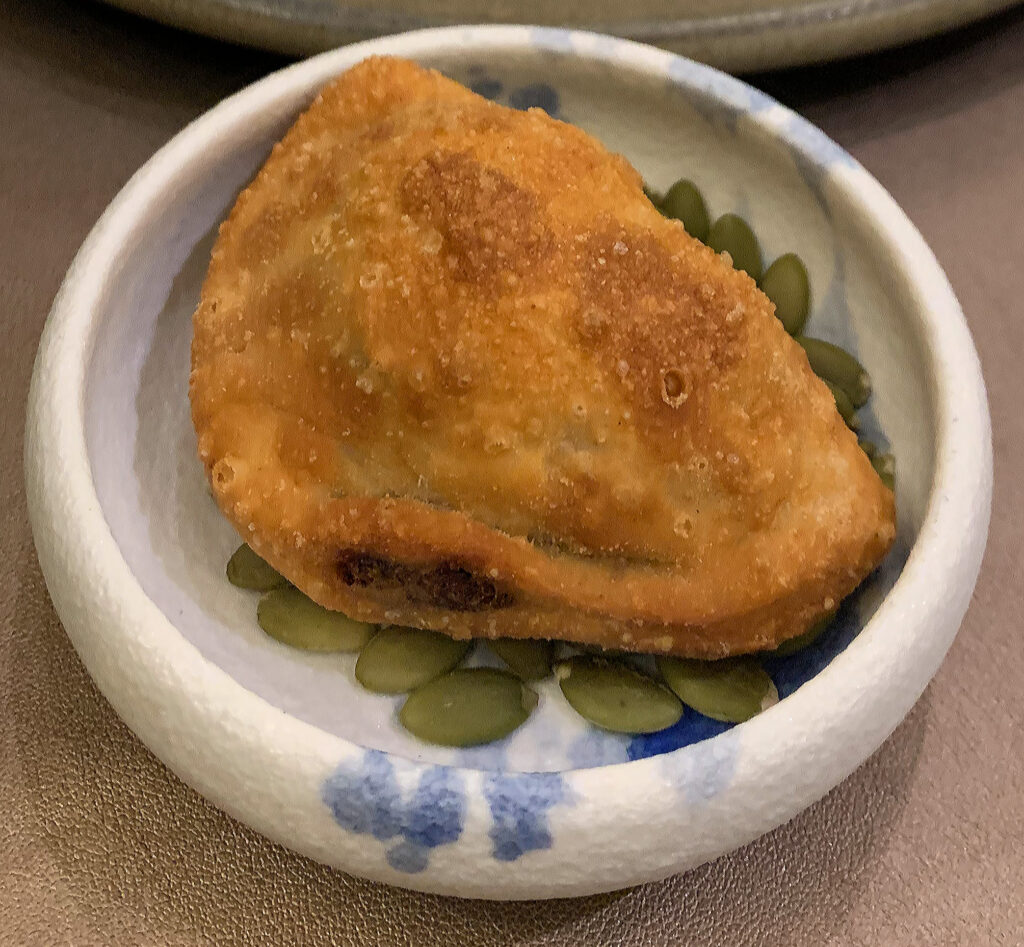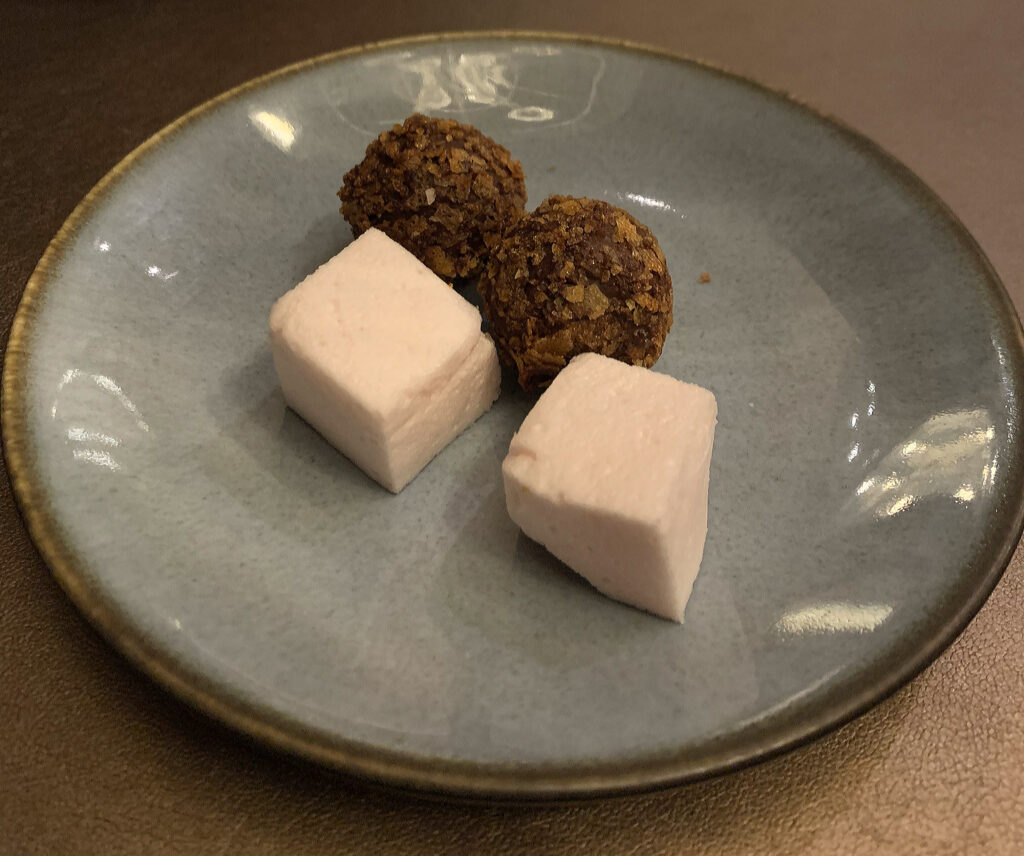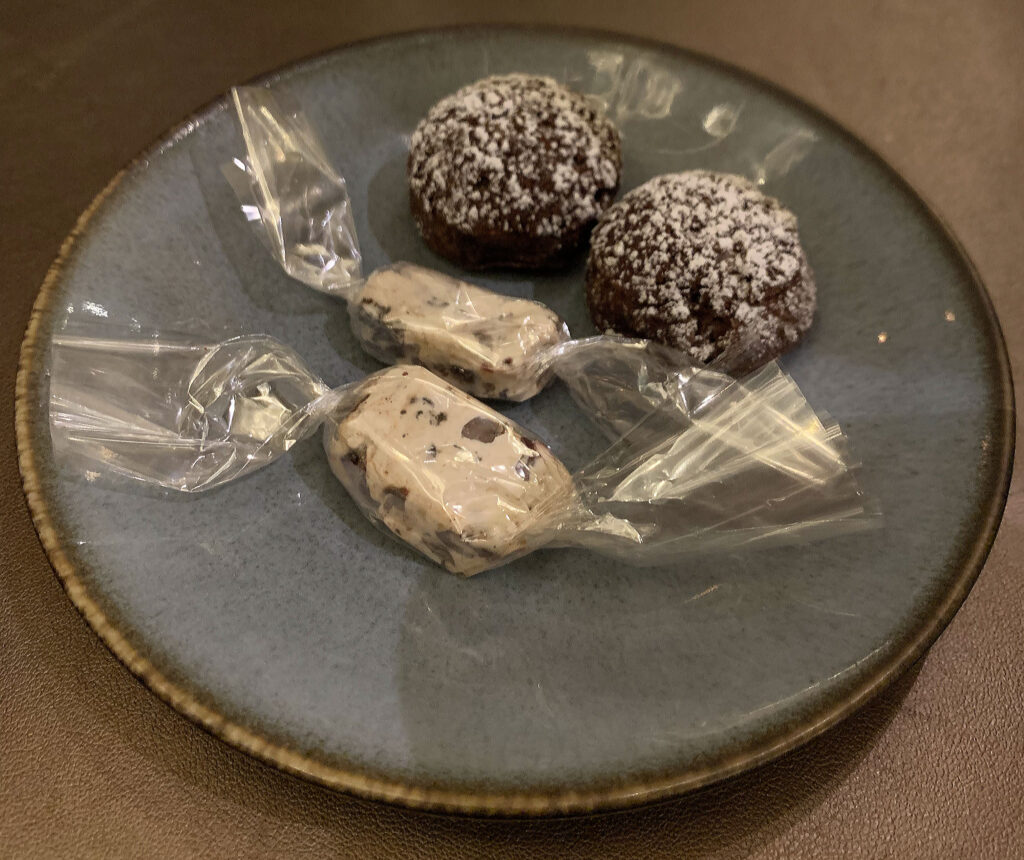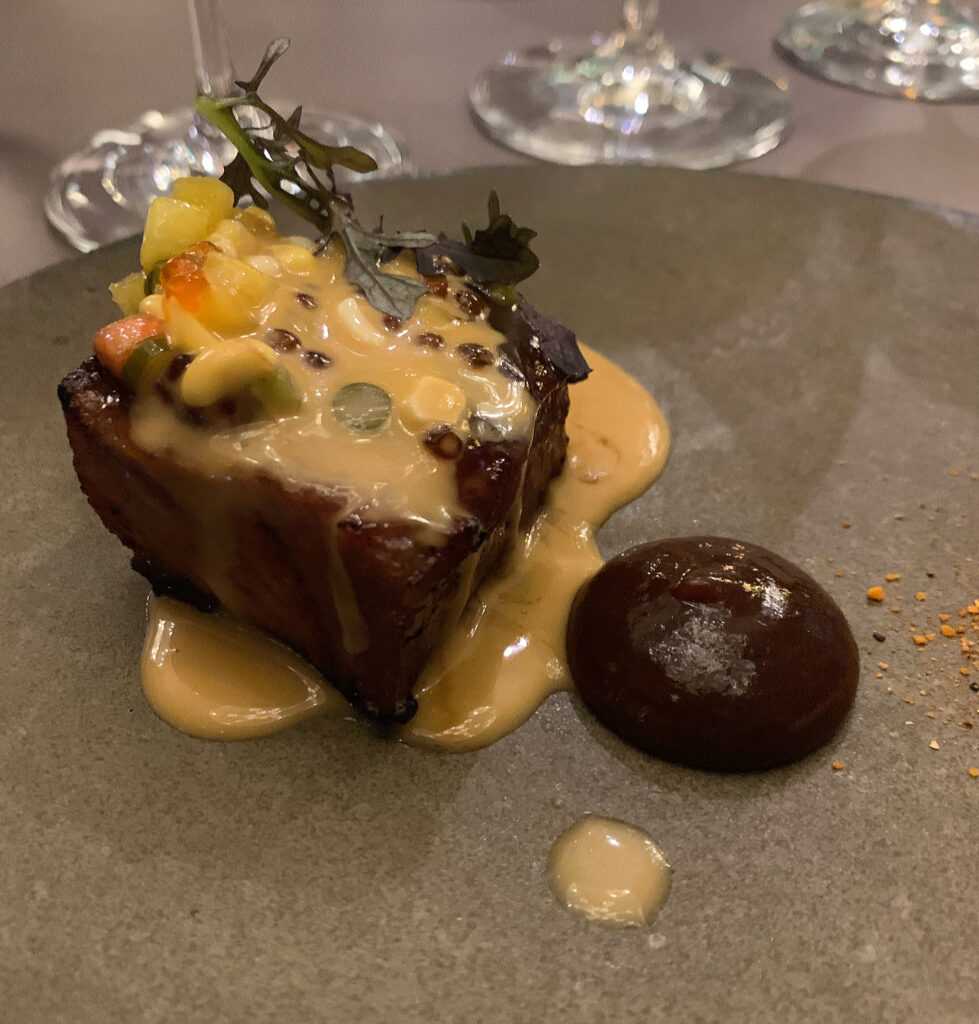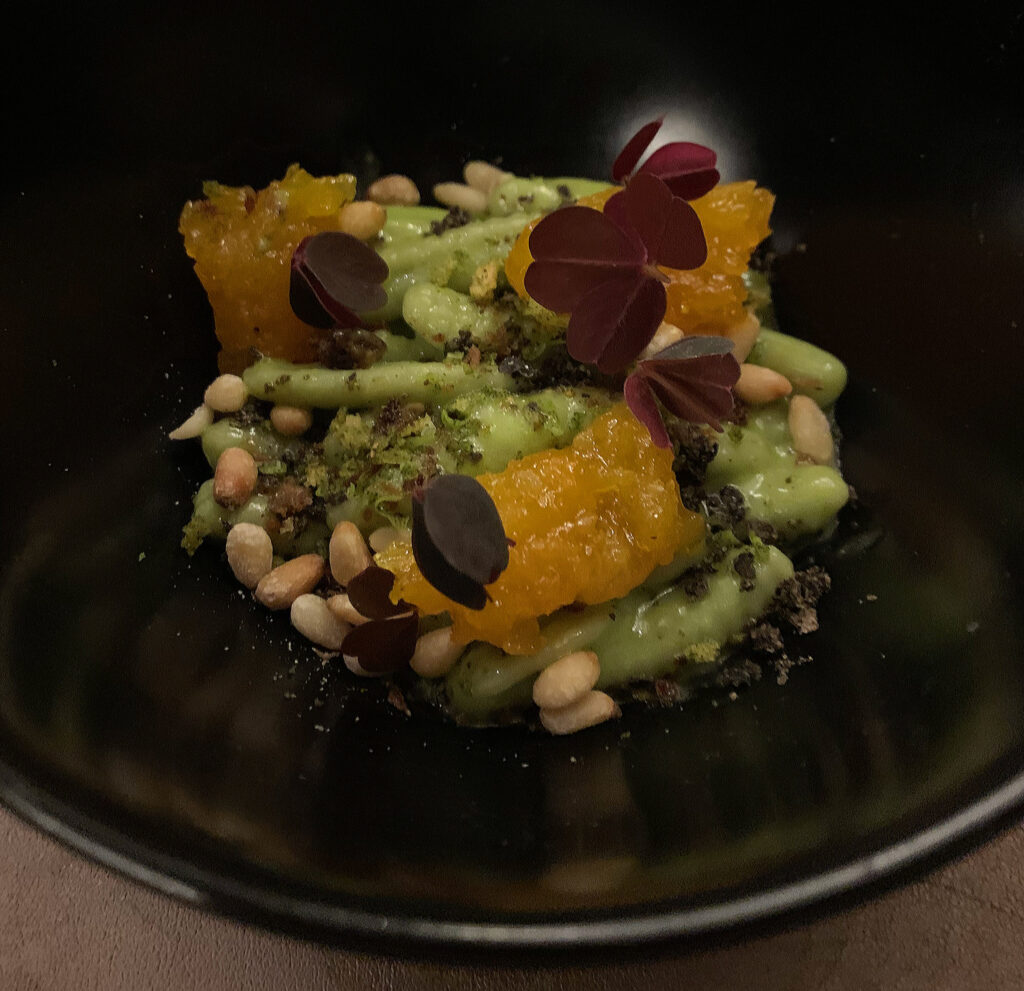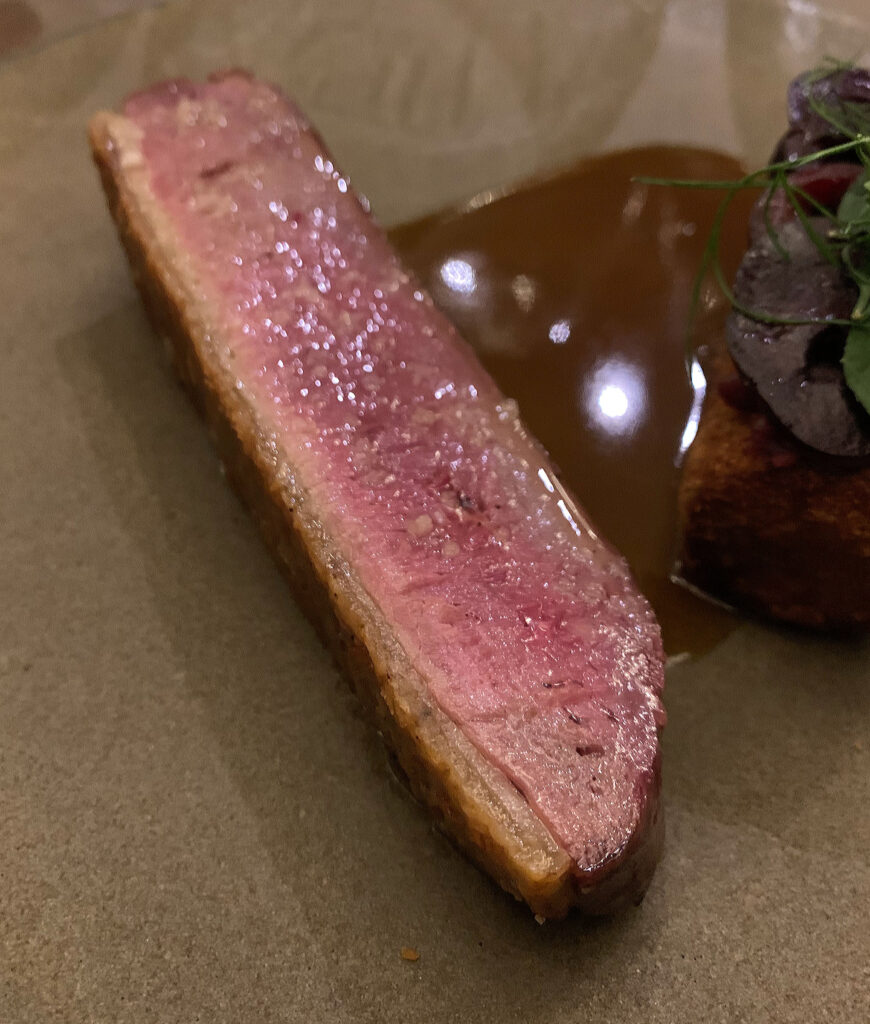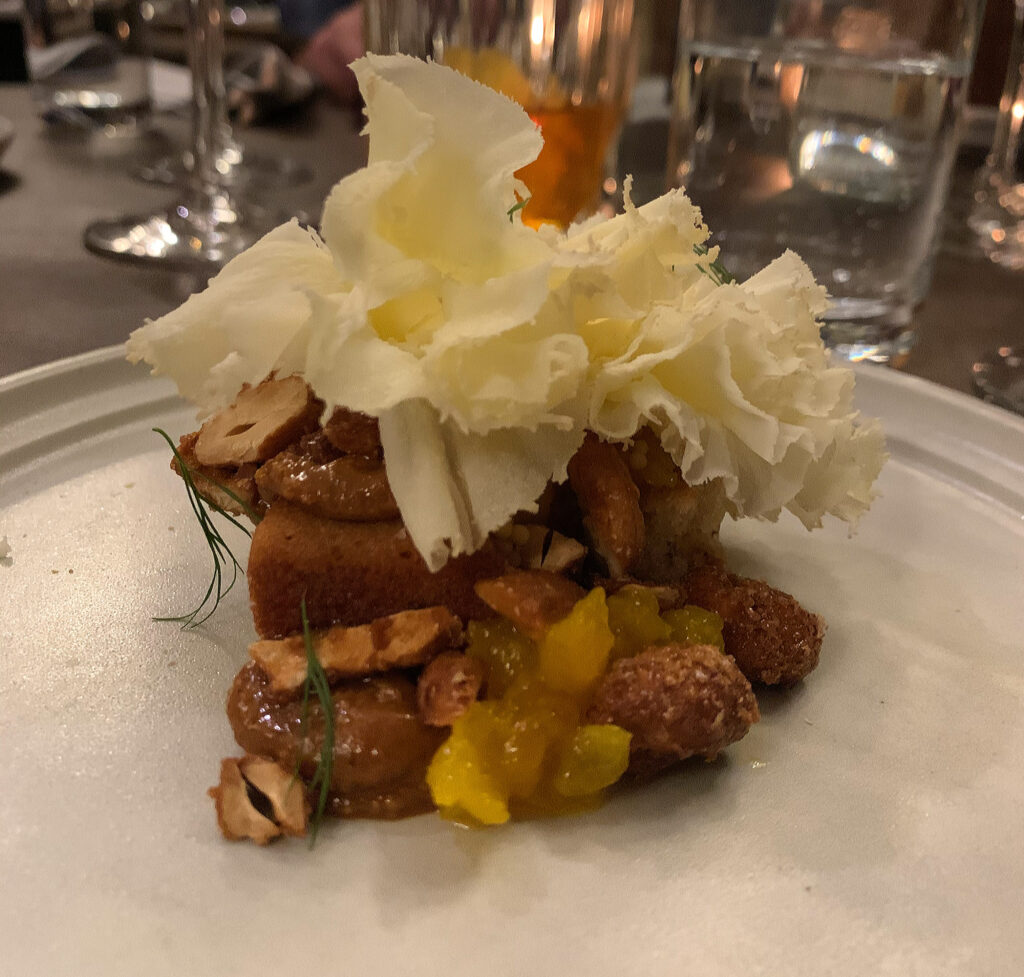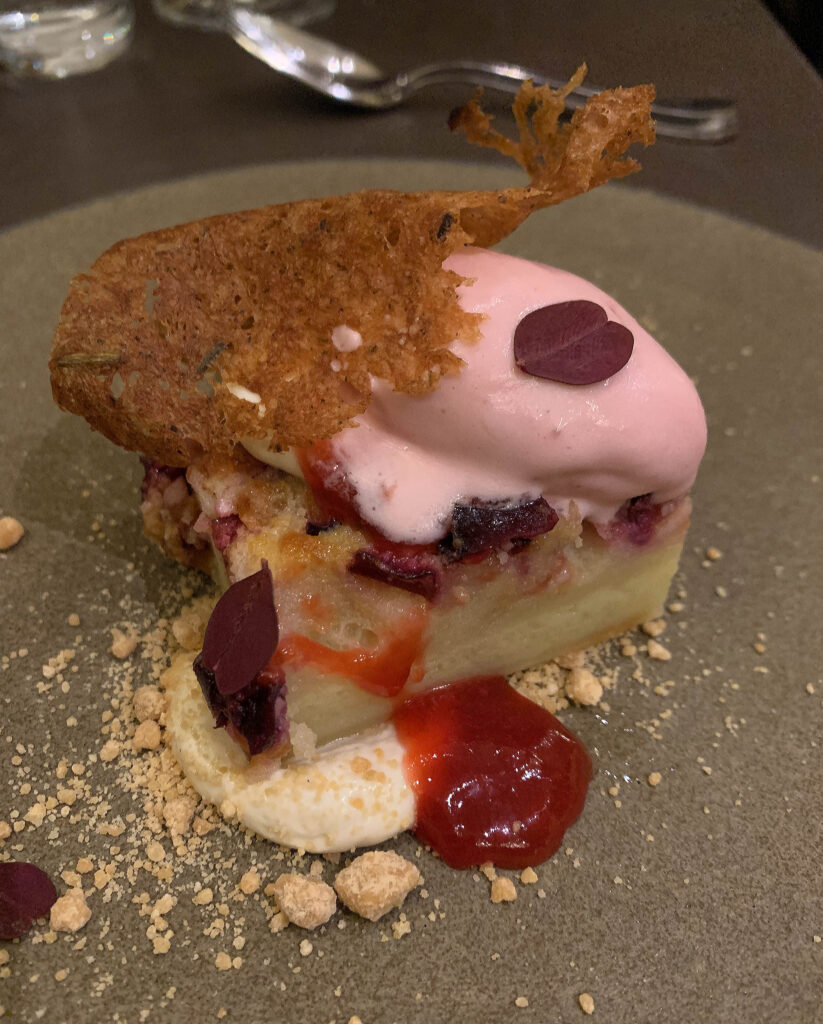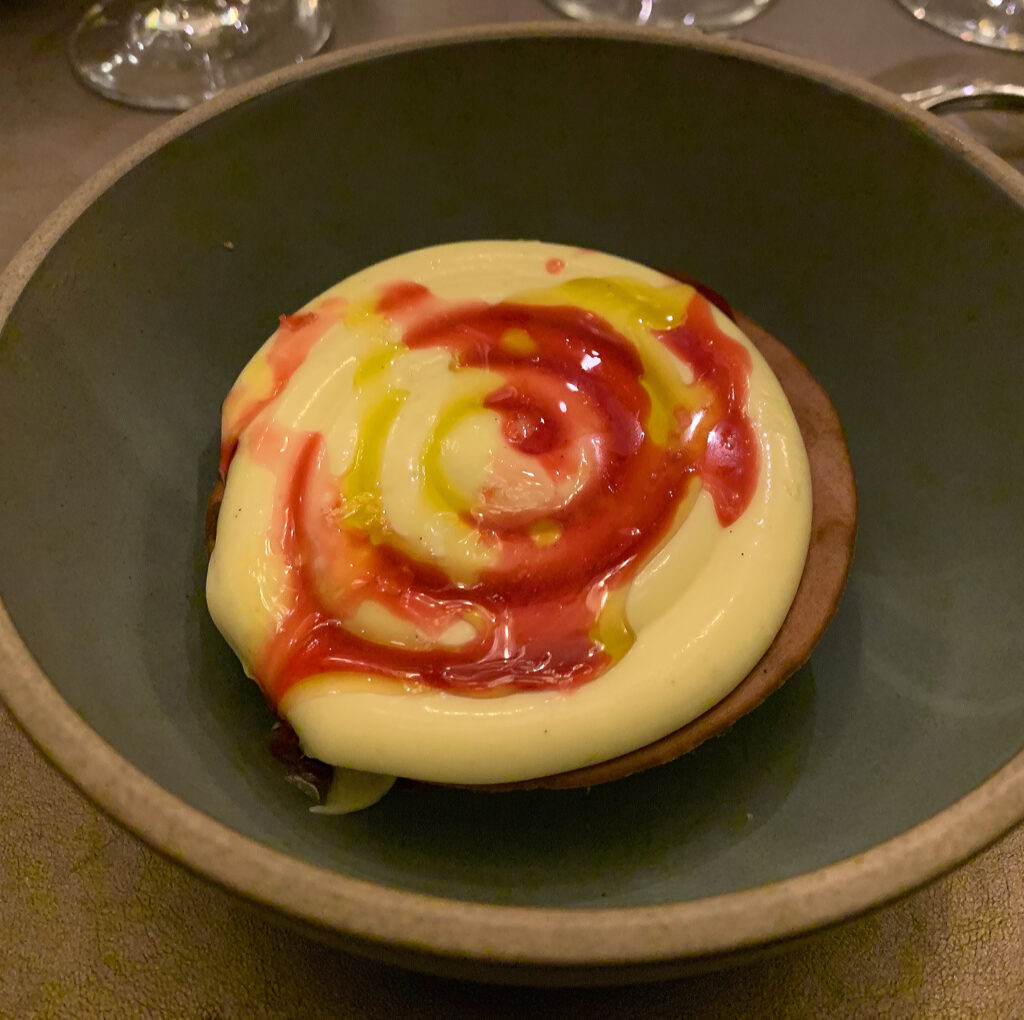After a brief interlude, in which you analyzed a Michelin-starred restaurant fighting for relevance during that awkward period of “middle age,” you now take aim at another concept that has comfortably reached maturity. Yes, after North Pond (opened in 1998) and Boka (opened in 2003), Sepia (opened in 2007) shines as another member of the old guard: one of those perennial Bibendum favorites (only four other restaurants have held stars in every single edition of the Chicago Guide) that forms the venue for many a consumer’s first tango with fine dining.
These old stalwarts are certainly worthy of respect, for you do not reach 15, 20, or 25 years of serving inventive (read: expensive) cuisine in this city without doing something right. And, in the case of Boka (with the wider BRG empire) and Sepia (with Proxi), success has even fueled expansion.
Of course, you know by now that the overarching financial health of a restaurant group does not necessarily ensure the lasting quality of its mothership. Ideally, other openings would help preserve and empower the creative processes that have built the brand’s reputation. However, just as easily, new properties sap the group’s resources and attention. Thus, the crown jewel adopts a defensive posture and becomes frozen in time. It plays it safe and plays the hits—over and over—to make the most of the popularity it has cultivated.
Sure, there is nothing wrong with giving the public what they want. But what of the wasted potential—the opportunity to continue pushing and growing your patrons’ appreciation of gastronomy? Why not, by wholeheartedly pursuing some singular vision and enriching the dining scene in your wake, affirm that Chicagoans deserve the best, most forward-thinking concepts in the country rather than what simply sells well today?
North Pond, you think has succeeded by staying true to an identity that was barely legible (let alone popular) when the restaurant launched. It has arguably even doubled down on that vision by bringing in a new chef who combines the same values with a quiver full of cutting-edge techniques. Boka, by your measure, has gone the opposite route: simplifying and streamlining its cuisine while ratcheting up the pricing on beverages. As BRG focuses on projects in other markets, its mothership acts merely as a promotional tool (allowing the company to invoke its “Michelin-starred” credentials) and a cash cow. It seems content to milk its existing audience for as long as possible while offering nothing to snare a new generation of diners.
Where does Sepia fall within this dichotomy? Well, having been nominated alongside four other restaurants for “Outstanding Hospitality” at the 2023 James Beard Awards (ultimately losing out to The Quarry in Monson, Maine), the concept would appear to be performing at its peak. That being said, the JBF—in the wake of some serious soul-searching (or was it capitulation?)—cannot be relied upon as a neutral arbiter of quality. And even Bibendum, to be fair, is not really inclined to ever take away stars unless something catastrophic happens.
Yes, having earned its status as an institution, Sepia is entitled to coast on that reputation. The restaurant has its longstanding fans—very much like Boka does—who regularly return to invoke the warm memories they have made for over a decade. And, no doubt, there must be a trickle of newcomers who, attracted by the value proposition, decide to take the plunge.
“What drives them?” you wonder, for Sepia does not routinely command the attention of the local food media or “foodie” influencer complex. It falls, like Boka, North Pond, and Temporis, within that impenetrable “contemporary American” genre and lacks the easy differentiation that being the namesake of a larger restaurant group, boasting an incomparable natural setting, or wielding Grace-inspired molecular techniques respectively provide. By offering “seasonal menus…rooted in tradition, melding rustic sensibility with contemporary flair,” the restaurant even seems to be proudly retrograde.
Today, Sepia stands as an ode to the past in a neighborhood that is now defined by burgeoning growth. Of course, Randolph Restaurant Row had already taken shape long before the place opened: with the street’s transformation into a hospitality destination being dated to the opening of Jerry Kleiner’s Vivo in 1991. Even Blackbird, once located less than a block away, took flight in 1997—a full decade before Sepia came into existence.
Blackbird’s closure in 2020 was a bitter pill to swallow: it being another one of those restaurants that had earned one or more Michelin stars in every edition of the Chicago Guide. The concept’s cuisine, under Ryan Pfeiffer, was decidedly modern but still playful with bold bursts of eclectic influence. It was, air quotes aside, contemporary American cooking of a national caliber. How did it bode for Sepia that its equally awarded neighbor—crafting more experimental dishes imbued with greater viral appeal—could not survive? The pandemic, no doubt, had a part to play. Blackbird’s sleek interior design was rather cramped while Sepia benefitted both from a larger space and a private events business. Yet, are changing tastes also to blame?
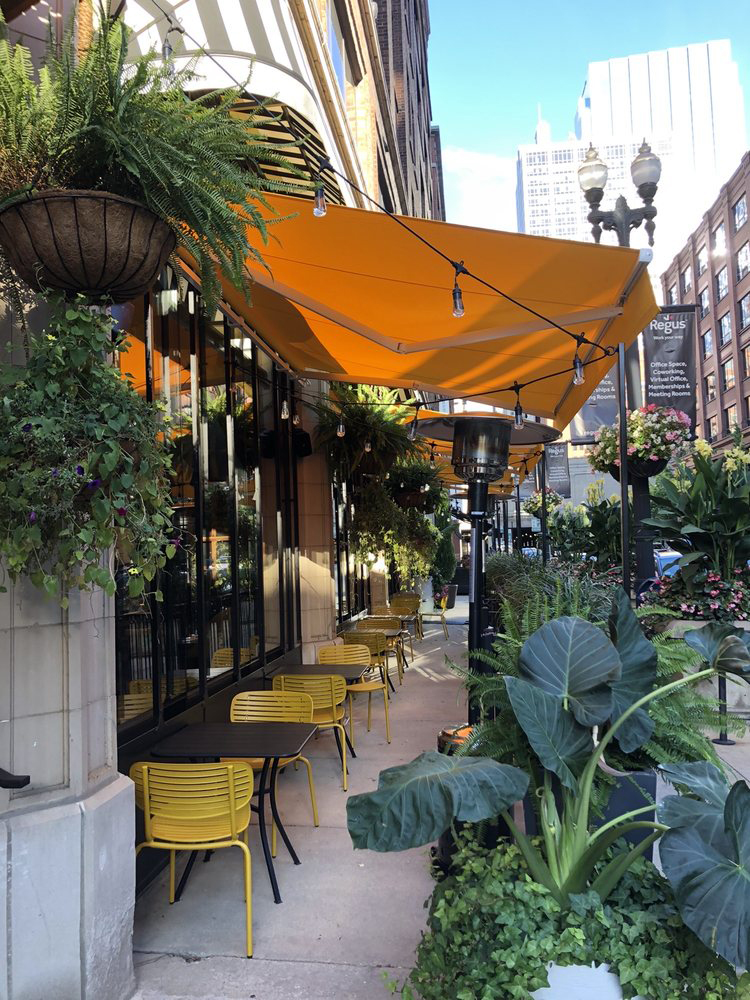
With each successive high-rise, Randolph Restaurant Row fulfills its promise as a dense, indefatigable entertainment district. However, Bellemore, too, was forced to close across the street from Sepia, with BRG substituting its “bold, bright, and beautiful” American cuisine for Alla Vita’s thoughtless menu of pizza and pasta. The latter concept joins Bar Siena, Fioretta, Formento’s, Gino & Marty’s, Gioia, Macello, Monteverde, Riccardo Osteria, and Rose Mary as one of many options within this broader genre that you can find in the surrounding area. Even Next, with its Tuscany menu, has gotten in on the act: their latest theme ranking among the weakest ever (and further cementing a precipitous decline that started, in truth, the second Dave Beran left).
Elsewhere, across West Loop, you find Japanese (Gaijin, Mako, Momotaro, Nobu, Omakase Yume), Mediterranean (Aba, avec, Cira), Mexican (La Josie, Leña Brava, Texan Taco Bar) and steakhouse (BLVD, El Che, Swift & Sons) concepts all well represented along with the odd Chinese, Indian, Peruvian, and Spanish joint.
American fare features at a litany of places: Au Cheval, Bandit, Beatrix, Eleven | Eleven, Fulton Market Kitchen, Girl & the Goat, The Oakville, The Publican, Trivoli Tavern, and Wishbone among others. Nonetheless, while some of these properties are a bit contemporary in their approach (reflecting a global influence) or embody particular inflections (Californian, Cajun), none really aspire to fine dining. Rather, they are broadly come-as-you-are places equipped to sate Randolph’s meandering consumers with shared small plates, burgers, fried chicken, and the occasional steak washed down with cocktails and beer. This is a bit of an oversimplification—and, to be clear, you enjoy a couple of these establishments—but they speak to a casual, unfussy approach to the country’s foodways compared to what Blackbird or even Bellemore were doing.
Now, to be fair, Randolph Restaurant Row and its surrounding avenues are home to a few “contemporary American” heavy hitters: Ever, Oriole, and Smyth. However, these concepts are more defined by particular techniques (molecular gastronomy, fermentation) and aesthetic properties (the cavernous Lawton Stanley design, the album covers spanning the ceiling of the kitchen) than any decidedly domestic bent. Instead, they combine ingredients from near and far with a wide range of influences (France and Japan often being represented) in a manner that speaks to their star chef’s personality. Ultimately, these establishments are singular “uber brands” that have built a kind of prestige that separates them from the rest of the market. Ever, Oriole, and Smyth are not thought of as three options among countless “contemporary American” restaurants but as pinnacle experiences that can only, at best, be compared to each other (and one or two other places in town).

Sepia might be best judged relative to Elske, Roister, and Valhalla: Michelin-starred, formerly Michelin-starred, and likely soon-to-be Michelin-starred concepts respectively that roughly fit the “contemporary American” mold. Elske, of course, shows a distinguishing Danish influence that just about places the restaurant in its own category. Roister, likewise, is known as the more casual, approachable wood-fired counterpart to the infamous Alinea and Next (even though it has begun offering a $115 tasting menu of its own). Only Valhalla, perhaps, remains a bit undefined in the mind of the consumer. Yet, its food hall location and $188 price tag are certainly enough to make an impression upon being discovered.
Yes, looking at the neighborhood that has developed around it over the course of 16 years, Sepia now almost seems defined by its plainness. Now serving a $95 four-course menu, the concept may even seem paltry in an era when meals are being offered for quintuple that price. For, a new generation of Americans—entering the world of fine dining for the first time—is naturally attracted to what they perceive to be “the best.” Michelin stars signify luxury after all, and, should you be unable or unwilling to secure a rarefied table, then a sense of novelty would be the next best thing.
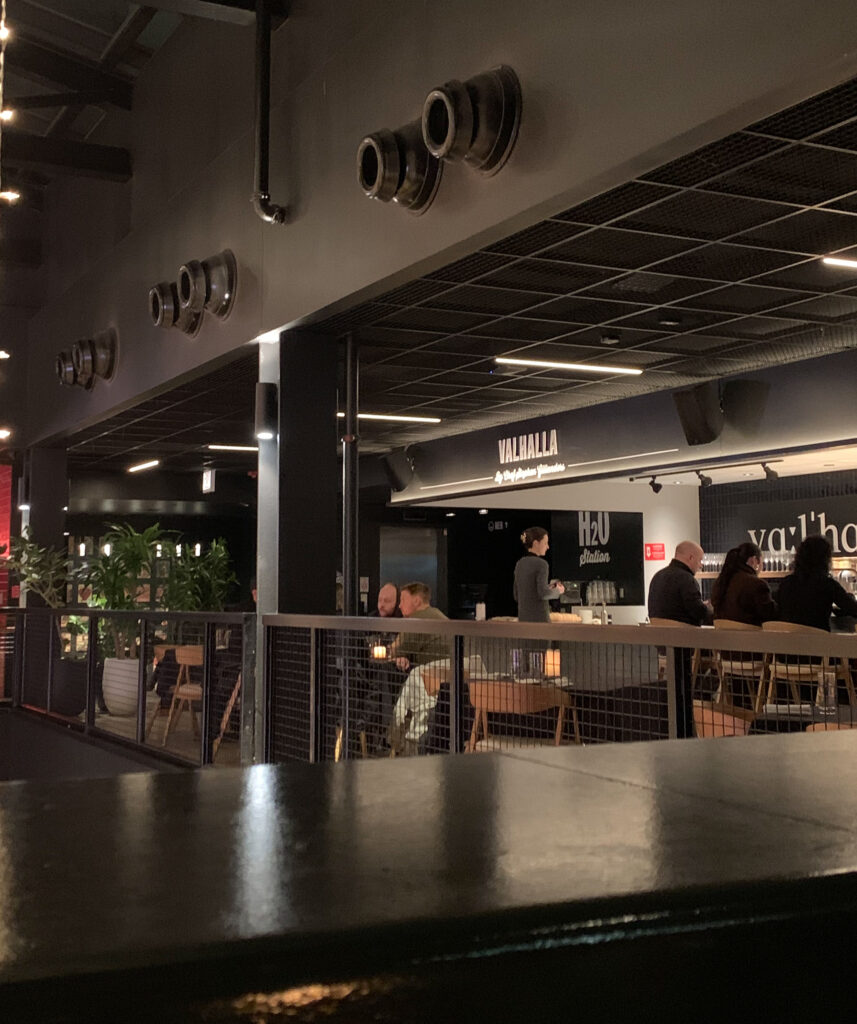
Why pay $95, the sort of sum that buys a nice time at a steakhouse, for American food “rooted in tradition, melding rustic sensibility with contemporary flair”? Why not pay $115 for Roister’s relation to the hallowed Alinea, $125 for Elske’s Danish delights, or $188 to sit in Valhalla’s “dynamic, high energy location”? Why not pay for a whole range of other Michelin-starred experiences in the Filipino, Mexican, Middle Eastern, or omakase genres?
Sepia—on the surface—only seems to shine as the safe choice for backwards palates, the value play for those who want a tiny taste of what exactly the Guide and its ratings are all about. “Outstanding Hospitality” aside, just what does the restaurant, in this era of increasing premiumization and self-definition, offer the discerning consumer? How high can “contemporary American” cuisine free of any obvious embellishment really fly?
These questions will inform your analysis of this next, great member of Chicago’s old guard. Yet, before digging in, it may be instructive to get a sense of how the concept has made its way to maturity.
The story of Sepia undoubtedly starts with Emmanuel Nony, who grew up “in Le Touquet, in the northern part of France near Boulogne and Calais” spending “a lot of time at the local farmers market” and “fishing tiny shrimps with…[his] brothers and sisters.” His parents “were true bon vivants” who inspired a “love of good food and entertaining” in their son, and he naturally found his way to culinary school upon coming of age.
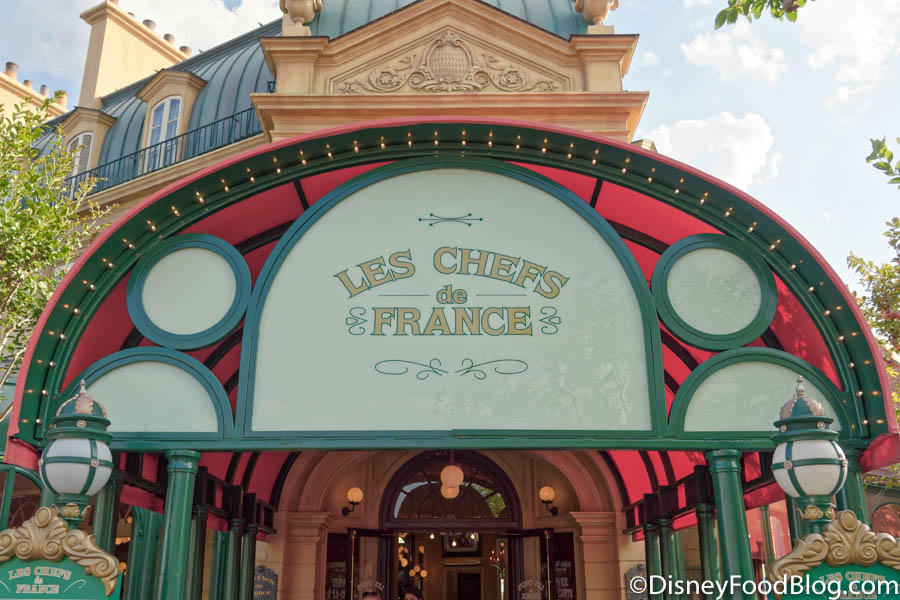
Nony, nonetheless, discovered he was destined to work in the front of house and transitioned “to the service side from the kitchen” for the rest of his career. In the 1980s, he moved to Orlando and took his first major job at EPCOT’s France Pavilion. There, Disney had opened Les Chefs de France—a “family-friendly brasserie” serving nouvelle cuisine—in collaboration with Paul Bocuse, Gaston Lenôtre, and Roger Vergé. Nony spent “several years moving up the ranks” at the restaurant under Mickey’s watchful eye before taking a position with Hyatt International.
Across 16 years working for the group, he managed food and beverage operations for hotels in New York, Hong Kong, Seoul, and Fukuoka. Nony also, notably, managed the program at the Park Hyatt Tokyo (of Lost in Translation fame). In 2000, he moved to Chicago to open the “newly rebuilt” Park Hyatt at 800 N Michigan Avenue. There, Nony would help NoMI, the hotel’s 120-seat restaurant on the seventh floor, earn three stars from the Chicago Tribune with a “straightforward, approachable” French-International menu from JBF “Rising Star Chef of the Year” nominee Sandro Gamba.
In June of 2005, Nony’s peripatetic journey with Hyatt would come to an end. He had “fallen in love with the Windy City” and “decided to put down roots here” by opening his own restaurant. About a year later, the former NoMI man had signed a lease for an old “1890 print shop in the West Loop” and installed himself in an apartment “just down the street.” In February of 2007, the new “contemporary American” restaurant revealed its name: Sepia. In July of that same year, the 90-seat concept would open promising a “contemporary-yet-traditional American dining experience likely to appeal to West Loop hipsters.”

Nony had tapped Kendal Duque, Gamba’s sous chef at NoMI, to lead the kitchen, whose cuisine was alternatively described as “part Chicago” and “[part] Italian.” However, much of Duque’s prior experience was—like his boss—decidedly French.
Born in Quito, Ecuador, the chef earned “a biochemistry degree from UPenn and a literature MFA from UC Berkeley” before planning to pursue a PhD at Harvard. Nonetheless, Duque had grown up in “a family with a strong food culture” (his grandmother being “considered one of the city’s best cooks”), and he found himself sucked into “Berkeley cooking culture.” That led to Peter Kump’s Cooking School (now known as ICE) in New York and two years working for Spanish chef Julian Serrano at Masa’s (in San Francisco) and Picasso (in Las Vegas).
In 1998, Duque moved to Chicago and worked for Jean Joho at Everest, where he wanted to get his “butt kicked” by the “tough” and “very old-style French” chef. A year later, the former biochemist would open Tru as sous chef under co-owners Rick Tramonto and Gale Gand. Leaving Chicago, Duque “spent a summer staging at Michelin-starred restaurants in Paris” before returning to New York. There, he worked for Rocco DiSpirito at Union Pacific—a “fine-dining temple” that earned three stars from The New York Times. Returning to Chicago, Duque took the job at NoMI and, subsequently, spent time as chef de cuisine of the Union League Club before reuniting with Nony for Sepia.
At the time of the concept’s opening, Duque sounded “happy to be breaking free of his French fine-dining background,” one he noted “really takes you to the extreme and rips you apart to your core.” His menu, in contrast, would feature “trendy/cozy creations” of “no more than four components” like “grilled quail with mustard greens” and “warm pig trotters vinaigrette” alongside “comfort food” desserts from pastry chef Kim Schwenke (who came to Chicago by way of North Carolina). Elsewhere, the style of the food would be described as speaking “mostly of the ingredients, but with a chef’s touch, a restaurateur’s hand.”
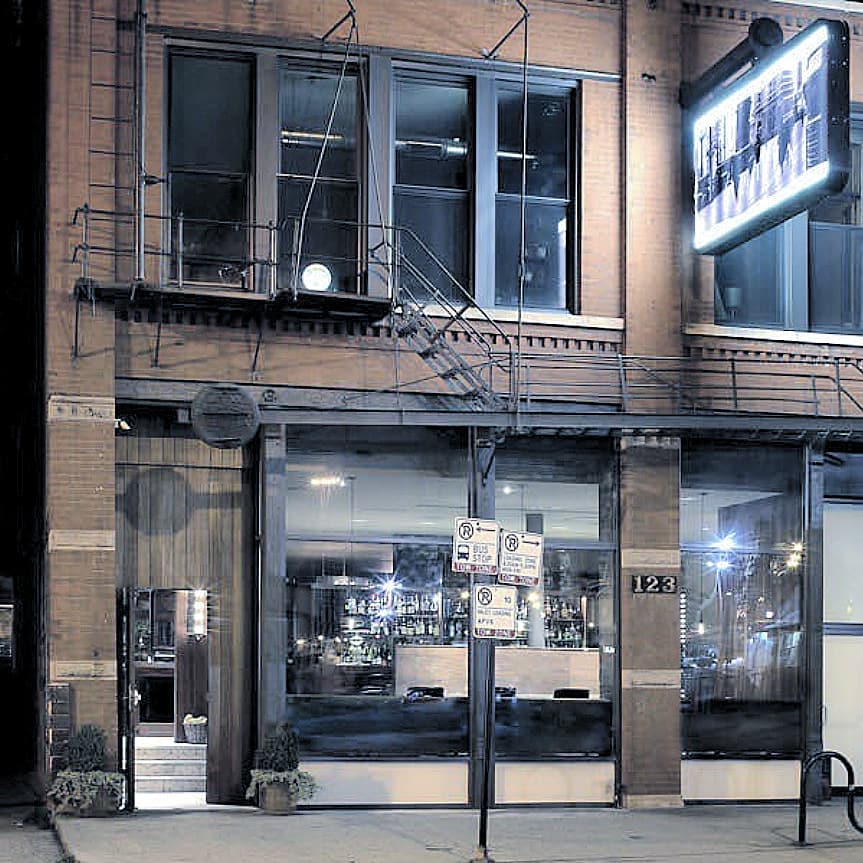
While it is hard to find examples of the “opening hype” that surrounded Sepia, early reviews seem convinced by Duque and Nony’s work. The Chicago Reader, writing in August of 2007 (after about a month of operation), praised the “visually interesting” renovation of the 1890 print shop “in shades of black and sepia with sage and burgundy accents.” The servers, likewise, seemed “savvy” and “happy to be there.” Fare like “moist rabbit paired with delicate ricotta dumplings in a Riesling reduction,” “ultratender charred octopus piled on a toasted baguette slice in tomato sauce,” “slow-baked veal breast on wide, lightly minted noodles,” and a “thick Berkshire pork chop complemented by crunchy pickled wild onions” drew praise. Flatbreads, “which head the menu,” and a “dry flourless chocolate cake” were disappointments, but an “eclectic, affordable wine list” helped make for “an enjoyable experience” overall.
Phil Vettel, writing for the Chicago Tribune in September of 2007, would award Sepia three stars (“excellent”) and proclaim that the restaurant “lives up to the hype with creative, oftentimes stunning contemporary cooking” and “attentive, professional service that borders on the nurturing.” By that point, the concept was already “hot”—not “lines-out-the-door hot or two-hours-at-the-bar hot,” but “you’d better call at least two weeks ahead for a weekend reservation.” The crowd, likewise, was a mix of “older, well-dressed…fans from Nony’s Park Hyatt days and Duque’s work at Union League Club” blended with “younger, often scandalously dressed” diners “enroute to Carnivale, Fulton Lounge or Ghost Bar.”
The critic was particularly enthralled by “a super-tall, model-thin woman” in “4-inch heels and vivid-yellow, Spandex micro-mini dress” one evening: “I give her credit for matching the restaurant’s color scheme; actually, I give her credit for a great many things, but this is a family newspaper.” However, he still found time to praise “eye-opening” flatbreads topped with combinations like “peaches, blue cheese and bacon” or “corn niblets and white anchovy.” The preparations of rabbit, octopus, and veal breast were all celebrated once more. So, too, were “lamb sirloin…placed over a ragout of Great Northern beans, roasted garlic and other bits of lamb [offal],” “skate wing…with a raisin-caper sauce,” “juicy free-range chicken…with pea shoots and surprisingly tasty wax beans,” and “duck breast…[with] sweet corn and swiss chard.” Only a “nearly spartan steak tartare” drew mild grumbles in a review that declared the “small, intimate and food-focused Sepia” lived up to standard set by its neighbors “Blackbird, Avec and Meiji—the culinary cognoscenti of the Randolph Street restaurant corridor.”
Laura Bianchi, writing for Crain’s Chicago Business in November of 2007, would take a slightly more negative tack. She praised Sepia’s “refined, friendly hospitality,” “rustic and elegant” décor, and “seasonal menus…prepared with organic, local or sustainable ingredients” but found “the food is still a work in progress.” In particular, the pork rillettes lacked flavor, the “duck-fat potatoes served alongside [the steak tartare] were pale and tasted ordinary,” and “trendy braised short ribs” were “too basic.” A “chocolate pear tart,” likewise, was “rubbery and harsh tasting” while “chocolate crêpes…were dry.” Still, the review praised dishes like “chilled tomato soup…with avocado and blue crab,” the rabbit, the octopus, a “grilled elk chop…[with] deeply browned potato and carrot cubes,” and a “flawless” apple dumping filled with “tender fruit, raisins and walnuts beside cinnamon ice cream and caramel sauce.” If anything, the chef just took “simplicity too far in a couple of cases.”
Still, this minor criticism aside, Sepia could claim a rather successful opening. The restaurant “paid out its first dividend to the investors within the first year” despite the 2007-2008 financial crisis, and Duque himself collected a couple awards: being recognized as Chicago magazine’s 2008 “Best New Chef” and named a semifinalist for the James Beard Foundation’s “Best Chef: Great Lakes” title that same year. Sepia, likewise, would be named a “Best New Restaurant” in 2008 by both Chicago and Time Out while Robert Louey Design would win the JBF’s 2008 “Outstanding Restaurant Graphics” award with its work for the concept.
Some representative dishes from this era, available thanks to internet archiving, are as follows:
- “Jonah Crab, Potato and Almond Pesto Flat Bread”
- “Lamb Shoulder, Caramelized Onion and Olive Flat Bread”
- “Sweet Corn Gazpacho with Bell Pepper Cream and Cornbread Crouton”
- “Watermelon and Shaved Fennel Salad with Goat Milk Yogurt Dressing”
- “Sea Scallops with Pork Belly, Knob Onions and Sugar Snap Peas”
- “Red Kuri Squash with Ham, Arugula, Walnuts and Parmigiano Reggiano”
- “Veal Sweetbreads with Celery Root Remoulade and Black Truffle Vinaigrette”
- “Whole Wheat Pasta with Smoked Duck Breast in Carbonara Style”
- “Amish Chicken with Acorn Squash and Serrano Ham”
- “Porcelet Rib Chop and Leg with Lentils and Brussels Sprouts”
- “Walleye Pike with Black Trumpets, Salsify and Cashew Vinaigrette”
- “Cod with Spaghetti Squash, Wild Board Sausage and Paprika Sauce”
- “Braised Veal Short Ribs with Mint Noodles and Truffle Butter”
- “Sweet Potato Spice Cake Bread Pudding and Caramel Thyme Ice Cream”
- “Malted Milk Chocolate Mousse on Peanut Butter Crunch with Maple Peanut Sauce and Pretzel Bark”
- “Pistachio Ice Cream and Pistachio Financier with Dark Chocolate Sauce”
These were complemented by nearly a dozen cocktails (like the “Strawberry Old Fashioned,” “Sepia Mule,” and “Honeycomb Margarita”) from head bartender Josh Pearson alongside a range of wines (identified by “the predominant grape in each bottle, a thoughtful touch for those less-familiar with European” bottles) from sommelier (and future Master Sommelier) Scott Tyree.
2008 would also see opening pastry chef Kim Schwenke depart. She was replaced by Cindy Schuman, who had spent more than six years at “Kevin Shikami’s inventive, Asian-inflected restaurant” Kevin in River North making desserts like “chamomile rice pudding” and “milk chocolate mousse.”
2009, nonetheless, would bring with it an even more dramatic change. After 18 months leading the kitchen, Duque himself would leave Sepia. No further reasoning was given at the time—though, suggesting an amicable split, the chef put on an elaborate “Last Dinner” at the restaurant for his final service toward the end of March. Duque would eventually open The Chicago Firehouse in 2010 and City Tavern in 2012 (both with Mainstay Hospitality) before moving to American Junkie in 2013, Brass Monkey in 2014, and ultimately finding his way to Austin, where he is still opening concepts to this day, in 2018.
Back at Sepia, Nony recruited Andrew Zimmerman—then the chef de cuisine of NoMI—to lead his kitchen. Surely, his shared Park Hyatt experience was an important selling point (Zimmerman, like Duque, had worked under Sandro Gamba). However, he hardly represented a trite like-for-like replacement.
Growing up in Buffalo during the 1980s, Zimmerman harbored a “life-long dream” to become a rock star. An English major in college (having dropped his original choice of music), he nonetheless became a professional guitarist in his twenties—“I could play at a club and beg my friends to come”—while supporting himself “by working in restaurants in New York City.” (“I really worked in kitchens so I could make enough money to buy guitar strings or get a new amp.”) Though he once played for 10,000 people at the 1989 World College Pop Festival in Japan, Zimmerman “was ultimately more successful in cooking than making music” and, moreover, realized “that the kitchen was his true calling.”
As a kid, he was already described as “a precocious budding gourmand with a hankering for peculiar ingredients” who grilled his parents about their “business dinners at classic Manhattan gastronomic palaces.” As a teen, “sick of eating bland food” geared toward the taste of a younger brother “who was an extraordinarily difficult eater,” he cooked his first dish: shrimp étouffée adapted from the crawfish étouffée recipe in Chef Paul Prudhomme’s Louisiana Kitchen.
Thus, the rocker left the “fried fish and mediocre prime rib joints” he was working at behind and dedicated himself fully to the craft of cuisine. That entailed working “as sous chef for three years under Renato Sommella,” whom he cites as “one of his strongest culinary mentors” and the one that taught him to “trust…[his] instincts.” At 2Cenza in Red Bank, New Jersey (a restaurant “with room for only two cooks behind the hot line”), Zimmerman “got to stand next to this guy from Italy who was cooking his food, the food that he grew up with, that he really cared a lot about, and it was as good as being at the source in Italy.” There, Sommella guided him “through classic preparation of risottos, pastas” and “less classic non-Italian food items like foie gras and brioche.”
Leaving 2Senza, Zimmerman enrolled at The French Culinary Institute in New York City and graduated first in his class in 2000. From there, he took “a not particularly clever sous chef job” for a couple years opening a restaurant in his hometown. (“It probably would have been better if I had taken a line cook job for somebody super-serious and toughed it out a couple more years.”) Being drawn to Chicago’s “abundance of world-class restaurants” (as well as the fact that it is “his wife Lindsey’s hometown”), he accepted a position in the banquet department at the Park Hyatt in 2003. Somewhere along the way, he also staged for Patrick O’Connell at The Inn at Little Washington and for Grant Achatz at Trio.

By 2004, Zimmerman met Terry Alexander (of One Off Hospitality) and was invited to take over from Susannah Walker as chef of MOD. There, he served “creative contemporary American cuisine” in a “colorful and fun” setting. When Alexander reconcepted MOD into modern tapas restaurant Del Toro in December of 2005, Zimmerman was retained as chef. The latter went on “a four-day eating tour in Barcelona, dining out four or five times a day” in preparation so that he’d “have some taste memory of what I was shooting for.” And, in March of 2006, the Chicago Tribune would award Del Toro two stars (“very good”) in a review that “enjoyed just about every dish” but only grumbled that many “are perilously close to being oversalted.”

Del Toro would close in March of 2007, with the same critic declaring its “consistently interesting menu and arresting décor…will be missed.” The restaurant, for what it’s worth, remained “packed” to the very end. The closing “wasn’t about fickle customers,” but rather “a problem with a past partner.” Alexander would praise Zimmerman’s “insatiable quest for knowledge–knowledge of the origin of the dish, history of a vegetable, background of a leading chef” as distinguishing him from “a large majority” of the other chefs he’d worked with. Still, as Del Toro made way for The Violet Hour, the latter would need to find something new.
Or, as it happens, something old. Zimmerman returned to the Park Hyatt and became chef de cuisine of NoMI under chef Christophe David. In 2008, he was first introduced to Nony and, a year later, found himself perfectly positioned to take Duque’s spot at Sepia in March of 2009.
Stepping into the new role, Zimmerman would note that “the basic sentiment” of the concept “is still the same.” Sepia would still be “an American restaurant that uses a lot of local farm ingredients” with “an inflection of the Mediterranean.” He would simply interpret that idea differently, with Duque’s approach being “a little more rustic” and his successor’s “a little more refined in technique and approach.”
Looking back a few years later, Zimmerman would term the food Sepia opened with as “a lot simpler,” in line with “being a very very casual neighborhood restaurant.” He also “felt like some of the standards for the restaurant didn’t quite meet the restaurant that…[he’d] read about.” The goal wasn’t to make the restaurant “stuffy, or aim for Michelin stars” but to develop food and service that was “as sharp as the place looks.” It would take “almost the first full year” for the chef to make “a significant enough change” and really assert his style of cuisine.
By May of 2009, some of Zimmerman’s additions to the restaurant’s menu could start to be noted (alongside new desserts from Schuman, who remained as pastry chef):
- “Chestnut Soup with Braised Oxtail”
- “Seared Sea Scallops with Cabbage, Gnocchi and Whole Grain Mustard Sauce”
- “Whole Wheat Pasta Carbonara, Pecans, Pumpkin and Guanciale”
- “Sturgeon with Lentils and Root Vegetables”
- “Free-Range Veal Chop with Watercress and Celery Root Remoulade”
- “Skate Wing with Briased Collard Greens and Grape-Pine Nut Sauce”
- “Braised Beef Short Ribs with Taro Root Puree, Carrots and Turnips”
- “Freeform Pecan Honey Phyllo Tart with Honey Orange Ice Cream and Brandied Orange”
- “Cornmeal Cookie with Sweet Goat Cheese Cream, Blueberry Compote and Coconut Sorbet”
- “Citrus Cake and Ginger Custard with Carrot Sorbet and Apricot Crème Anglaise”
- “Pan Brownie with Chai Ice Cream, Almond Toffee and Griottines with Chocolate Caramel Sauce”
And, in June of that same year, the Chicago Reader would render its verdict, declaring that “Sepia couldn’t have found a better replacement for Kendal Duque than Andrew Zimmerman.” More particularly, the publication praised an “appetizer of a gently poached and crisply fried duck egg, the essence of spring on a bed of sauteed asparagus, ramps, and morels,” a “charcuterie combo” of “rich country-style duck paté, fine-textured rabbit rillettes, and a house-made pistachio-studded mortadella,” and a “Gunthorp Farms pork porterhouse” with “bourbon, a salad of greens and cherries on top, and smooth cheese grits underneath.” Schuman’s desserts, likewise, were termed “first-rate.”
Phil Vettel, writing for the Chicago Tribune in December of 2009, would echo the same sentiments. Once more awarding Sepia three stars (“excellent”), the critic termed Zimmerman “an ideal replacement” for Duque whose “modern look is tempered by deep traditional roots and frequent homages to rusticity.” More specifically, he praised a “wonderful piece of walleye…served with pieces of guanciale and wilted Brussels sprouts,” a “sensational” pot-au-feu of “poached chicken breasts wrapped in forcemeat and Swiss chard in a shallow pool of rich broth,” and a “comfort-food classic” of short ribs “braised in Belgian ale…[and] placed alongside spaetzle flavored with spice-bread seasonings.” Schuman’s work was again complimented as “stellar” while the beverage program was termed “exciting” both for its “well-crafted cocktails” and “globe-trotting wine list.” Service also remained “effortlessly professional” (even if the managers ultimately “sussed out” the critic’s identity).
With Zimmerman firmly at the helm, 2010 would prove to be a banner year for Sepia. In February, two members of the restaurant’s team would take home honors at the Jean Banchet Awards: Schuman for “Best Celebrity Pastry Chef” and Tyree for “Best Sommelier.” That same month, Crain’s Chicago Business would name Sepia one of five “Best Restaurants for Business”—not the most prestigious title, but one that affirmed the concept’s enduring quality under the new chef. Likewise, in March, Michael Nagrant—writing for Newcity—would name Sepia one of “Chicago’s essential restaurants of 2010” while highlighting “Zimmerman’s charcuterie” and “one of the best cocktail programs in the city.”
In June, Arthur Hon, who had been at the restaurant since opening, took the mantle from Tyree and became Sepia’s wine director. Over the course of seven years (in this particular role), Hon’s work would secure five semifinalist spots for the JBF’s “Outstanding Wine Program” award and one nomination. Sepia would be named one of “America’s 100 Best Wine Restaurants” by Wine Enthusiast four times, and the wine director himself would be named “Best Sommelier” by the Jean Banchet Awards (in 2014), “Best New Sommelier” by Wine & Spirits (in 2015), and “Sommelier of the Year” by Food & Wine (in 2017).
While a lack of archival sources makes it hard to fully appreciate Hon’s work, one surviving wine list from 2015 features producers like Bérèche, Cédric Bouchard, Dr. Bürklin-Wolf, Cavallotto, Chartogne-Taillet, Bruno Clair, Ulysse Collin, Corison, Dagueneau, Vincent Dancer, A. et P. de Villaine, Schlossgut Diel, Dönnhoff, Egly-Ouriet, Gravner, Guiberteau, Jamet, Weingut Keller, Krug, Labet (Jura), Domaine des Comtes Lafon, Maison Leroy, Matthiasson, Marguet, Méo-Camuzet, Château Palmer, Ponsot, Domaine de la Pousse d’Or, Joh. Jos. Prüm, Ökonomierat Rebholz, Ridge, Roagna, Salon, Willi Schaefer, Tempier, Terlan, Tissot, and Vietti.
In short, Hon presided over an embarrassment of riches that—especially considering the low markups—has only very rarely been equaled by other contemporary Chicago wine lists.
July of 2010 would mark the passage of Sepia’s third birthday, and it would also come with the announcement that Ron Howard “decided to film several scenes for an upcoming movie” at the restaurant “after eating there and falling in love with its vintage design and cuisine.”
It would also offer an opportunity to check in on the state of Zimmerman’s menu after more than a year leading the kitchen, with the following dishes being featured:
- “Watercress Soup, Frog’s Legs Beignet, Crème Fraiche”
- “Sea Scallops, Celery Root Purée, Tangerine, Herb Salad, Black Pudding”
- “Bone Marrow ‘Crème Caramel,’ Mushroom Jam, Brioche”
- “Confit Baby Octopus, Fresh Chickpea Hummus, Black Olive Honey”
- “Shooting Star Greens, Feta, Sunchoke, Pickled Ramp Vinaigrette”
- “English Pea and Marscapone [sic] Ravioli, Pea Shoots, Thyme Butter”
- “Confit Duck Leg, Spinach and White Beans, Duck Heart, Rhubarb Gastrique”
- “Arctic Char, Sauerkraut, Rye Gnocchi, Pickled Mustard Seed”
- “Stinging Nettle Dumplings, Mushroom-Black Garlic Puree, Bulgur Wheat”
- “Flat Iron Steak, Sunchoke, Maitake, Coffee, Béarnaise”
- “Halibut, Artichokes, Littleneck Clams, Ramp Green Cavatelli”
- “Bacon Wrapped Trout, Red Bliss Potato, Watercress, Rosemary Vinaigrette”
Later, in September, Crain’s Chicago Business would come out with a more detailed appraisal of Zimmerman’s work, declaring the chef is “hitting all his marks” and maintaining “Sepia’s sensibility of contemporary but rustic, seasonal American fare while bringing his own exacting preparation to almost every element on the plate.” Though the review, once more focusing on business lunching, found that “noise can still be an issue,” it found that “knowledgeable yet unfussy service” and “proud hospitality that practically radiates from owner Emmanuel Nony” carried the day.
In November, all the momentum of 2010 would culminate in the announcement that Sepia was one of 18 restaurants to earn a star in the inaugural Michelin Guide Chicago (and one of 23 to earn stars in total). In a full-page feature, Bibendum would term the concept’s vibe “raw, urban, and sexy in a very current, rustic-industrial sort of way.” The entry would go on to praise Zimmerman’s “wide use of local and seasonal products, spinning them into such simple, elegant fare” that “manages to appeal to all types: young, old, artsy, corporate, dates, and groups of friends.” More specifically, “delicious flatbreads,” “golden sea scallops served over soft pillows of gnocchi,” and “a juicy, perfectly grilled Berkshire pork chop wrapped in crispy bacon” were all highlighted.
Seven years later, Zimmerman would reveal that he was “on the way to the dentist” when he received the tire company’s call. The team “had some Champagne at the restaurant” but, ultimately, realized they “had to get right back to work to meet—and hopefully exceed—the new expectations that…guests would have.” Sepia took the star “as a challenge and an opportunity to raise the bar at the restaurant in some small ways,” like adding “a nightly tasting menu” and reassessing “the sequence of service and the service standards.” Nonetheless, the chef admitted they “haven’t pursued an additional star” because the changes necessary to achieve it “would change the fundamental character of the restaurant in a way that might alienate…[its] core following.” Instead, they “are happy to work at being a really great one star restaurant.”
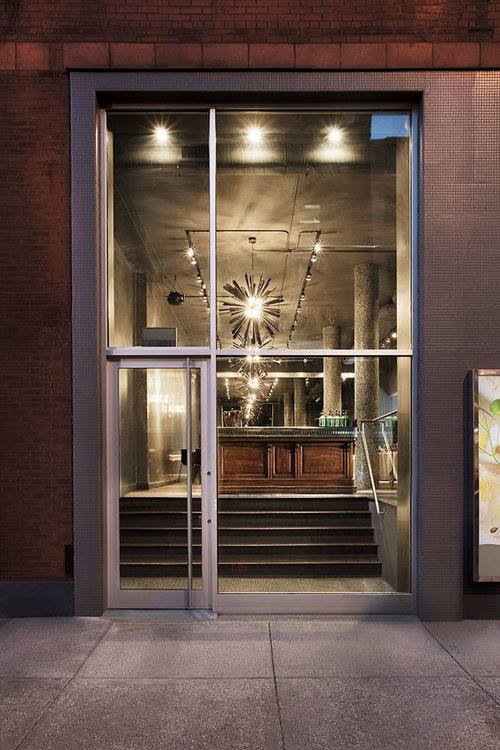
To that end, Nony and Zimmerman would open Private Events by Sepia across the alley from their flagship in 2011: a “2,200 square-foot space” accommodating “50 to 70 people for sit-down dinners and upwards of 175 for cocktail receptions.” The concept would allow the team, who could not “handles parties larger than 20 in the dining room,” to better manage the “hundreds of requests for large groups” they had received since opening. Nony noted that they had “stepped up in general with the food and service and…business has been consistent and strong” in the aftermath of the Michelin star. So, “why start a second restaurant when you have so many people who want to come to Sepia and you can’t accommodate them?”
A ”brand new concept” was indeed “on the docket,” but Nony and Zimmerman were “in no hurry.” Instead, they also unveiled an “expanded 16-seat sidewalk patio” that year.

2012 would see Zimmerman named a finalist (alongside Michael Carlson, Stephanie Izard, Anne Kearney, and Bruce Sherman) for the “Best Chef: Great Lakes” honor at the James Beard Awards. (He would also, subsequently, be named a finalist in 2013, 2014, 2015, and 2016 though never winning.) Nonetheless, the chef would fare better on Iron Chef America in “Battle: Cream Cheese” against Marc Forgione. Zimmerman and sous chefs Adam Zosack and Sam Henderson bested their competition by two points with a menu that included “cream cheese lobster rangoon served…with handmade sauce packets” and “salt cod brandade-filled pierogies topped with Australian winter black truffles.”
2013 would kick off with Zimmerman losing out on the “Chef of the Year” honor at the Jean Banchet Awards (also having been nominated in 2011 and 2012), but Sepia itself would secure the “Best Restaurant” title. In April, Josh Pearson (himself a Jean Banchet “Best Mixologist” winner in 2012) announced he would be leaving the concept, later being replaced that May by Griffin Elliott (of Boka and Scofflaw). July would also see Zimmerman and his team journey to Nony’s old stomping grounds—the Park Hyatt Tokyo—for a five-day residency at its New York Grill. There, the chef combined some of his classic preparations with fresh Japanese ingredients and a selection of Californian wines.
2014 started off with Crain’s Chicago Business once more celebrating Sepia’s good work, with Laura Bianchi (who offered the most critical of the concept’s opening reviews) terming the restaurant a “treasured spot” and “still a winner” after seven years. More particularly, she praised a “mortadella flatbread” (with house-made sausage, pesto, and Grana Padano), “chitarra pasta” (with pecorino cream sauce), “wagyu meatloaf” (with beef cheek pastrami, barbecue sauce, pickled carrots, and a housemade potato bun), and “buttermilk-and-cornmeal crusted trout” (with candied bacon and black-eyed peas).
2015 would see Time Out get in on the act, with Amy Cavanaugh awarding Sepia four out of five stars while praising “crisp-skinned trout,” “chicken with sausage bread pudding,” and “creamy foie gras capped with sour cherry gelee” alongside “well-balanced drinks” and a wine list that is “among the city’s best.”

This year would also yield one of the more amusing glimpses into Zimmerman’s personality via a “Ten Things I Hate” interview with Food Republic. In it, the chef would reveal he “hate[s] oysters,” “hate[s]…being asked to define…[his] cooking in two words or less” (“we’re not an Italian restaurant or French and what is ‘American’ exactly?”), and “hate[s] when guests confuse…[him] with Andrew Zimmern.” On that latter point (a case of mistaken identity that persists to this day), Zimmerman describes how guests wanting to “meet the chef” end up staring blankly at him “a look that says ‘you’re not who we wanted to meet.’” Graciously, he jokes that “sometimes I’ll just stand there at their table chewing on a bull’s testicle or crunching on fried grubs, but you can tell it just isn’t the same.”
Internet archiving, though somewhat irregular in its capturing of Sepia’s website, offers a rather complete look at 2015’s menus. The following are representative dishes from across the year:
- “Fluke Crudo, Green Apple, Avocado, Chilled Jicama Consommé”
- “Potato Gnocchi, Pork and Oxtail Sugo, Grana Padano, Rosemary”
- “Sweet Potato Tortoloni, Matsutake Mushrooms, Dashi, Spruce”
- “Buckwheat Agnolotti, Chevre, Kale, Watercress, Marcona Almonds”
- “Pasta alla Chitarra, Lobster, Saffron, Capers, San Marzano Tomato”
- “Soft Shell Crab, Dandelion Greens, Cucumbers, Smoked Date Molasses”
- “Arancini, Carnaroli Rice, Truffle, Salsify, Celery Root, Black Trumpets”
- “Duck Breast, Pumpkin, Fig Molasses, Fennel, Sunflower Seeds”
- “Strip Steak, Beef Shank Pave, Sunchoke, Cheddar, Coffee, Burnt Cinnamon Jus”
- “Berkshire Pork Collar, Apple, Saguinaccio, Parsnip, Black Vinegar”
- “Cod, Shrimp, Orange, Black Radish, Pumpkin Seed Broth”
- “Halibut, English Peas, Jowl Bacon, Razor Clams, Herb Jus”
2016 would be defined by the first rumblings regarding Nony and Zimmerman’s second restaurant: Proxi. For the sake of brevity, you will not dwell too much on this concept (especially now, with Jennifer Kim’s introduction as chef de cuisine, that it could merit its own closer look). However, its announcement would offer some further insight into Sepia as it approached its 10th birthday.
Proxi, with its embrace of Indian, Japanese, Malaysian, Mexican, Spanish, Thai, Vietnamese, cuisines, would be about “big direct flavors” and a “direct cooking style” relative to the more “harmonious and subtle” food at Sepia. Zimmerman, additionally, would get to cook over live fire at the new property (“something we can’t do at Sepia”) and explore facets of his “culinary personality” he hadn’t expressed before while “expand[ing] the audience” of his food. Elsewhere, Proxi would be described as “a lot more like eating at home” and more “boisterous” than its Michelin-starred neighbor.
Back at Sepia, the year would see Griffin Elliott depart as head bartender—being replaced by Keith Meicher (a fellow “Scofflaw vet”). This would be followed in 2017 by the departures of Shuman, being replaced as pastry chef by Sarah Mispagel (formerly of Nightwood), and Hon, being replaced as wine director by Jennifer Wagoner (formerly of StripSteak by Michael Mina in Miami Beach).
Despite such a series of consequential changes, Sepia would—in 2018—earn three stars (“excellent”) for the third time from the Chicago Tribune. Making three visits to the restaurant (something that has disgracefully fallen out of practice at the paper), Vettel would praise dishes like “scallops…over a creamy blend of peaches, pancetta and porcini…with cremini mushrooms,” “crab-ricotta-filled agnolotti with English and snap peas,” “brioche-crusted halibut with morels, white asparagus and spring onions,” and “roasted rabbit slices” with “nuggets of garlicky rabbit sausage in their centers…black garlic gnocchi…[and] a thickened sauce of rabbit jus, white port and cognac…mounted with foie gras instead of butter.” Zimmerman, in turn, would heap praise on chef de cuisine Adam Zoscsak when asked how he was able to manage “such a high level” of cooking both at Sepia and Proxi. (Mispagel, it should be mentioned, also received praise for her “strawberry crostata,” “deconstructed Meyer lemon torte,” and a “a tempered chocolate mousse dome, surrounded by sarsaparilla ice cream, cherries, smoked vanilla cream, chocolate meringue and cocoa nibs.”) That year, Sepia would also be named a semifinalist for the “Outstanding Service” honor at the James Beard Awards.
2019 was a quiet year by all accounts—with Sepia perhaps only notably being named the 38th best restaurant in the city on Vettel’s “semi-regular” Phil’s 50 list. The dawn of 2020 saw Mispagel leave as pastry chef, being replaced by Lauren Terrill (formerly of Swift & Sons). Zoscsak would also leave as chef de cuisine, with Kyle Cottle (who worked alongside Ryan Pfeiffer at Blackbird for five years) taking his place.
But the year would undeniably be colored by the pandemic and its associated lockdowns. Zimmerman took some time to formulate a plan, recognizing that “Michelin-star food doesn’t go in a box very well” and that it would be a challenge to channel his team’s energy “into making food that’s going to travel well and that’s still built around the same core values of quality, attention to detail, and deliciousness that we would put on a plate.”
In May, the chef would launch Sepia’s to-go operation, with all food being offered “cold with reheating instructions…so dishes don’t linger ‘in the temperature danger zone’ and make someone sick.” He would also only offer pickup in order to “avoid third-party delivery companies that aren’t necessarily invested in the integrity of the dish en-route” and that charge fees described as “criminal.”
Zimmerman ultimately approached this difficult period as an “opportunity to do dishes that otherwise wouldn’t really make sense in the restaurant’s usual form.” Offerings included “Whipped French Onion Dip” (with potato chips and caviar), “Salmon Coulibiac,” “Lasagna Bolognese,” “Poulet Roti Grand-Mère” (with Parker House rolls), “Roast Rack of Berkshire Pork,” “Honey-Glazed Duck Breast,” a “Smash Burger” (with onion rings), “Belgian Ale Braised Beef Short Ribs” (that classic recipe from 2009), and “Grilled Rack of Lamb” alongside desserts like “Tiramisu,” Champagne Cake,” and “Chocolate Fondant Cake.”
It would be a long road to a full reopening in 2021, and that year would see still more changes: Wagoner would depart as wine director, being replaced by Alex Ring (formerly of Oriole, Spiaggia, and Lazy Bear) and Terrill would depart as pastry chef, being replaced by Erin Kobler (formerly of Swift & Sons and Bellemore).
Nonetheless, this very team—Nony, Zimmerman, Meicher, Cottle, Ring, and Kobler—would remain in place through Sepia’s 15th anniversary (in 2022) and its JBF “Outstanding Hospitality” nomination earlier this year.
That, at last, brings you to the present day; however, it may be worth dwelling on a handful of representative dishes from 2021-2022 just to get a sense of what the kitchen has been up to after the pandemic:
- “Golden Kaluga Caviar, Smoked Halibut, Grilled Spinach, Shiro Dashi Butter”
- “Foie Gras Tart, Rose Gelée, Peach Jam, Aged Balsamic”
- “Sweet Corn Velouté, Parisienne Gnocchi, Pickled Blueberry”
- “Hiramasa Crudo, Baby Tomato, Almond, Tikka Masala Consommé”
- “King Crab Chawanmushi, Sauce Nantua, Hon Shimeji Mushroom”
- “Foie Gras Chawanmushi, Sauce Périgord, Porcini Mushroom”
- “Roasted Crab Rice, Old Bay Crispies, Sungold Tomato”
- “Sourdough Cavatelli, Parmesan, Pine Nut, Summer Squash”
- “Miso Roasted Scallop, Carolina BBQ Butter, Snap Pea”
- “Tempura Eggplant, Peach, Coconut, Jerk Spice”
- “Venison Shabu-Shabu, Chestnut, Barley, Huckleberry, Matsutake Mushroom”
- “Country Fried Truffled Chicken, Sweet Potato, Sauce Albufera”
- “Berkshire Pork Confit, Cherry Barbeque, Peanut, Five Spice”
- “Grilled Beef Striploin, Sweet Corn, Bone Marrow Chimichurri, White Cheddar Churro”
- “Hay Grilled Striploin, Smoked Bone Marrow Hollandaise, Broccoli, Tempura Crispies”
- “Steelhead Trout en Croute, Buttermilk, Cucumber, Dill”
- “Roasted Duck Breast, Cherry Duck Jam Donut, Turnip, Root Beer Jus”
- “Rohan Duck Breast, Honeycrisp Apple-Hoisin, Charred Cabbage, Sesame Buckwheat Corndog”
- “Ricotta Agnolotti, Morel Mushroom, English Pea, Parmesan”
- “Wood Roasted Ratatouille Lasagna, Parmesan, Preserved Tomato Sauce, Olive”
- “Alpine Cheese & Brown Butter Biscuit, Pleasant Ridge Reserve, Honey, Pickled Onion Jam, Radish”
- “Miso Butterscotch Pudding, Puffed Grain Krispy Treat, Candy Cap Mushroom Ice Cream”
- “Jivara Chocolate Cannoli, Peanut Butter & Roasted Coco [sic] Nib Ice Cream, Tamarind”
- “Dark Chocolate Brownie, Caramelized Banana, Peanut, Toasted Marshmallow”
- “Goat Cotton Cheesecake, Chamomile Strawberry Sorbet, Cajeta”
- “Crispy Sage French Toast, Honeycrisp Apple, Sweet Potato Ice Cream, Popcorn”
Stylistically, it is easy to see the common thread that connects this work to that of Zimmerman in the 2010 and 2015 menus previous listed. You find that same Italian influence (via the restaurant’s perennial pastas, a crudo, and a playful take on cannoli) along with glimpses of French technique (velouté, trout en croute, ratatouille, various sauces). Woven within these preparations are various familiar seasonal Midwestern ingredients: apple, corn, mushroom, sweet potato. Proteins like pork, steak, and duck also remain prominent, forming friendly anchors of satiation for customers who might otherwise feel averse to fine dining’s daintiness.
While Japanese elements like dashi and miso did indeed feature on the chef’s earlier menus, Sepia has trended toward featuring more and more of these techniques: shiro dashi butter, chawanmushi, miso roasted scallop, tempura eggplant, venison shabu-shabu, tempura crispies, miso butterscotch pudding, cotton cheesecake. This development not only speaks to an increasing mastery of the cuisine in the wake of Proxi’s opening (Zimmerman, to be fair, shared a chawanmushi recipe as early as 2016), but to the widening of the “contemporary American” umbrella over time. Changing tastes have also, in the same manner, seen Chinese (five spice, hoisin), Indian (tikka masala), Jamaican (jerk), and Mexican (cajeta, churro) influences come to the fore.
This broadening of Sepia’s culinary horizons might seem to threaten its relationship with Proxi on the surface. Just what is the difference between the two concepts—other than quotidian concerns of pricing and scale—if the former property embraces the same worldly bent? Yet, Sepia retains an undercurrent of Americana: nostalgic flourishes like Old Bay crispies, Carolina barbecue butter, country fried chicken, a cherry duck jam donut, root beer jus, a sesame buckwheat corndog, a biscuit, a “Krispy Treat,” toasted marshmallow, and French toast. Zimmerman’s cuisine has displayed this dimension before—you note the “Frog’s Legs Beignet” from his 2010 menu (though one can argue this is not strictly “American”)—but it seems especially prominent now.
In other words, as Sepia’s range of influences has expanded, the restaurant has also plunged deeper into the comforting, somewhat irreverent side of the national cuisine. Each side of this equation works to ground the other, with the resulting menu being definable neither as markedly “global” nor as some kind of “fine dining junk food” concept. Instead, Zimmerman, Cottle, and Kobler’s work embraces all the tensions and contradictions trying to define “contemporary American” today entails.
Thus, while Boka has remained surprisingly static in its culinary vision—and North Pond, under César Murillo, has combined Bruce Sherman’s philosophy with a bit more of that molecular gastronomy bent—Sepia has reflexively grown over time to embody a rather eclectic perspective. It will be worth exploring just how coherent and enjoyable the results of this singular approach are in practice.
You have visited Sepia now and then over the past decade but, for the purposes of this article, will focus on a series of three meals conducted from September through October of this year. This period has allowed you to get a sense of the menu’s dynamism while dining on different days of the week in different sized parties, likewise, has offered a chance to note differences in the restaurant’s pacing and consistency.
With all that said, let us begin.
That familiar corner of Randolph and Jefferson, located in the narrow neighborhood partition known as “West Loop Gate,” has already caught your eye a few times over the years. First, it was with the demise of Bellemore: fatally mismanaged by Boka Restaurant Group before being unceremoniously replaced by a safe, crowd-pleasing Italian concept. Later, Alla Vita (as the resulting restaurant would nonsensically be titled) would feature as part of a trilogy of reviews—confirming that Boehm, Katz, and their favorite Michelin-starred henchman Lee Wolen no longer lead Chicago’s dining scene but, rather, are content to milk consumers with lowest-common-denominator fare.
More recently, as part of a separate series examining Chicago’s up-and-coming omakase genre, you took a look a bit further down the street at CH Distillery. There, despite lingering bitterness regarding Malört’s manufactured “popularity,” you found Jinsei Motto: an uplifting story of two chefs who turned a pandemic pivot into a full-fledged business offering a flavorful, personable expression of sushi (that, perhaps, is only missing a bit more technical mastery).

Along the way, construction was completed at 609 Randolph—the 15-story boutique office building located (adjacent to avec) on the opposite corner—and leases were signed. Alla Vita and Jinsei Motto now both benefit from surging lunch crowds, and pizza, pasta, or the occasional makizushi must seem heaven-sent to those working on the block.
This was once the land of the business lunch after all, with West Loop Gate offering those working in the Loop itself an array of options just over the river but short of the highway (and the couple extra blocks of walking it entails). Of course, office occupancy rates have taken time to rebound in the wake of the pandemic, and the neighborhood must compete with all that lies to the north: venerable steakhouses and LEYE concepts as far as the eye can see. However, those following Wacker to its western limit will find a Beatnik, a Beatrix, and Bar Mar. Trekking a bit further, you reach Gibsons Italia and, a couple blocks after that, the aforementioned Alla Vita, avec, and Jinsei Motto.
Nonetheless, West Loop, today, can now call itself home to a burgeoning tech industry while, at the same time, having welcomed more longstanding companies looking to downsize and modernize their headquarters. The neighborhood is no longer a frontier of fine dining for the rest of the city but exists as its own ecosystem in which residential and office towers spring up in concert. Who really wants to walk east, over the highway, in search of just a few more lunch options amid a sea of eateries in Fulton Market and throughout the prime stretch of Randolph Restaurant Row?
Yes, Sepia sees itself competing with myriad concepts to the west, each more primely positioned to snare customers working in the same, densely populated area. Meanwhile, the pool of patrons located to the east—where the restaurant retains some natural advantage—remains more shallow than before. And those who remain, too, can choose from pizza, steak, and sushi (to say nothing of delivery) before the thought of taking in a refined “contemporary American” meal even comes to mind.
Perhaps that is why Sepia, after more than a decade topping “best business lunches” lists, has bowed out of offering any afternoon service since reopening in the wake of the pandemic. Proxi, for what it’s worth, has not resumed offering lunch or brunch either. Maybe this will all change as conditions do, but you cannot blame Nony and Zimmerman for moving slowly and not overextending themselves.
Instead, Proxi and Sepia compete solely in the evening: Bib Gourmand and Michelin-starred properties (respectively) whose high status justifies further travel. These restaurants no longer debase themselves—via sandwiches and salads—to lure in those faceless, fickle swarms of office workers. They stand, proudly, as spots worthy of a real dinner. At the very least, they invite you inside to enjoy a dignified happy hour (and maybe find yourself lingering a while longer after that).
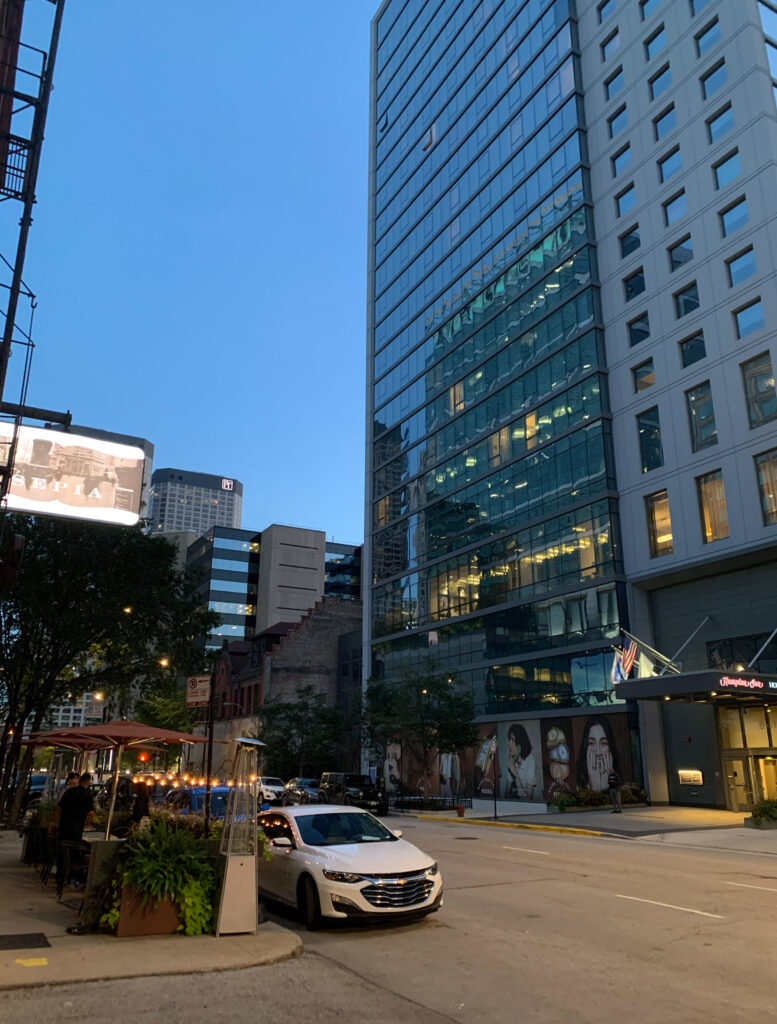
Yet, as you walk along Randolph and make the turn onto Jefferson, you find yourself suddenly feeling isolated. All of the Restaurant Row’s pulsating energy, which slowly builds from the other side of the river before bursting to life past the highway, is dissipated by a one-way street that is home to an antique store, an understated Hilton hotel, and a 102-year-old print shop. The parade of post-work imbibers—lured into the all-day establishments on the other side of the intersection or seeking their pleasure further afield—does not trickle this way. Even those entering Proxi do so from the building’s north-facing side.
Searching for Sepia, thus, entails separating yourself from the stream of merry consumers ready to celebrate the end of another shift. The restaurant’s signage, award-winning (along with other graphics) at the time of opening, looks now as though it could belong to any other storefront: an offshoot of the printer or a rival to the antiquarian perhaps. Unlike so many of Randolph’s other outlets further west—streets like Green, Peoria, and Morgan that lead you straight to additional bars and eateries—this block of Jefferson feels every bit a dead end: a return to the city’s cold, commercial side rather than a hospitable escape.
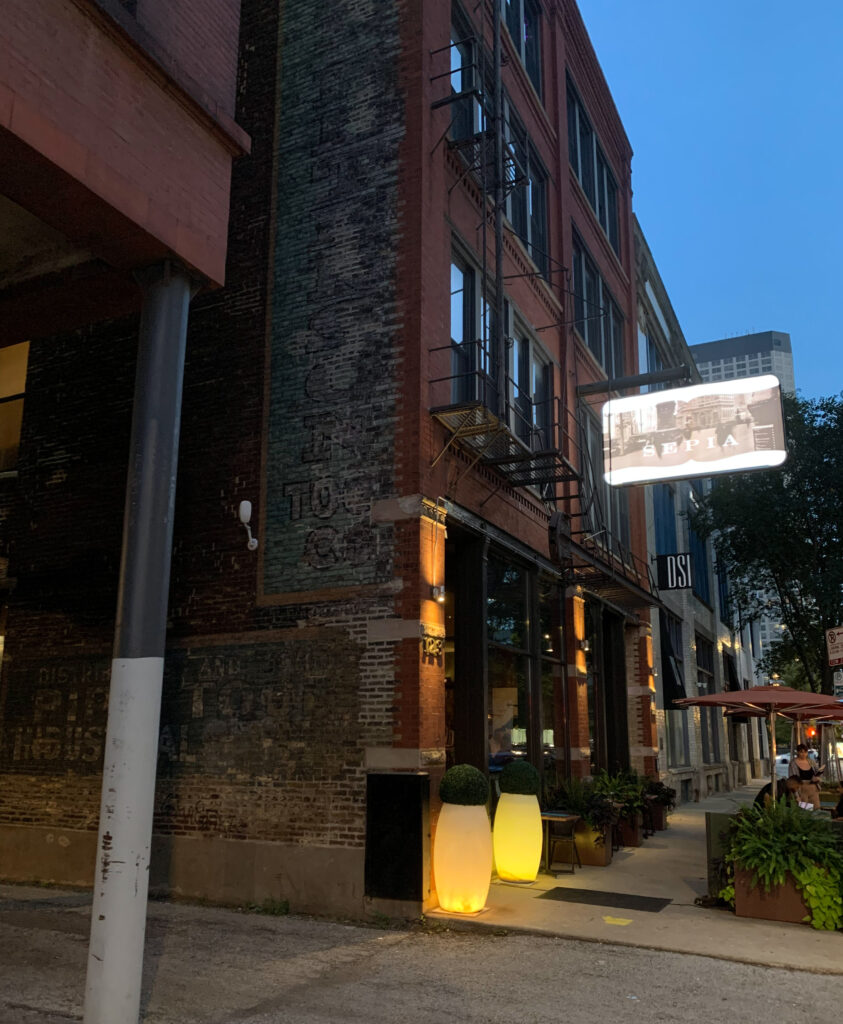
Knowing, nonetheless, where you are going—searching, expectantly, for that Michelin star at the end of the tunnel—you trace your way to the middle of the block and the familiar brick building at 123 N Jefferson.
Sepia’s façade, when you gaze upon it, cuts a subdued figure. Sets of dark metallic window frames rise four stories high, being matched by a slender fire escape that stretches over the ground floor and climbis up along the left side of the structure onto the roof. The front door is rendered in dark paneled wood, with additional surrounding planks serving to frame the entrance in line with the towering glass to its side.

Those bricks, when you inspect them more closely, boast a rich reddish tone. They are broken up by small segments of stone—some distinguished with pinwheel engravings—and culminate in a neat, squared cornice with a range of rectangular indentations. If you turn the corner into the alley that separates Sepia from Proxi, you may note the browner, more faded brick that is still emblazoned with the remnants of a previous tenant: Clifford Peterson Tool Company. Even the numbers signifying the street address, though they’ve changed places over the years, look original to the building.
The overall effect matches many of the other structures throughout the neighborhood: sturdy old warehouses awaiting redevelopment in the manner of more floors, more glass and steel. Yet, if the restaurant looks a bit worn, it never seems dingy. It displays the pleasant patina of age—of timelessness—that is reflected in Sepia’s signage, an image of “Old Chicago” which glows in the concept’s namesake tone at night.
The building, framed by carefully manicured planters (perhaps the one giveaway as to just how curated this façade actually is), speaks to the kind of aesthetic Hogsalt has grown so adept at fabricating. However, here (as at North Pond) the history is real. It amounts to a self-assured, permanent quality that connects the cuisine’s “contemporary American” ethos to something already—deeply–known.
Stepping through Sepia’s entrance, you find a vestibule done up in more brick, more wood, and bathed in warm lighting. Climbing a few steps, you make your way to another door—this time with a window at the center—that deposits you directly in front of the host stand. The counter is weighty and rendered in wood. Immediately behind it sits a cabinet—also in wood—containing glass jars and decanters that call an old-timey apothecary to mind. Though the staff checks customers in and shuffles them along at an admirable pace, the temporary scrum allows you a look around.
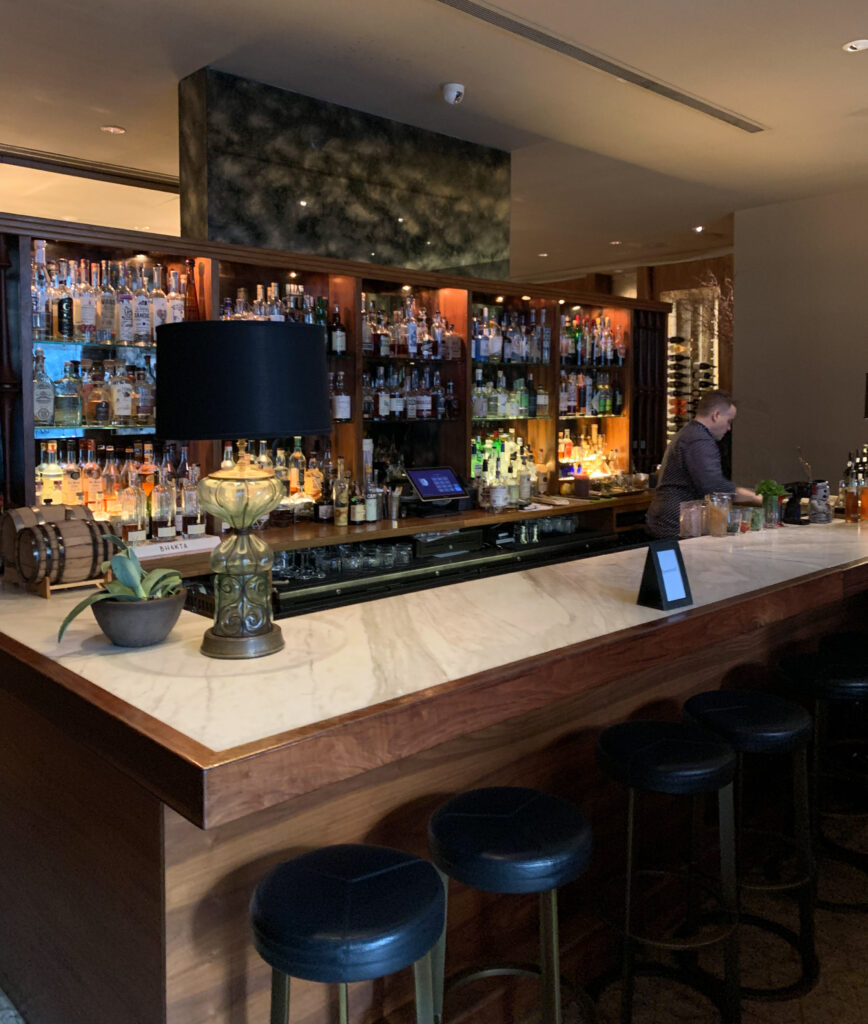
To your right, you find a sweeping U-shaped bar composed of a white marbled countertop with a wooden trim. Seven stools lie before it—bookended by hourglass-shaped crystal lamps—while three tiers of bottles are set within more cabinetry located behind. Opposite the bar, separated by a slender column and a pony wall, you come to the restaurant’s lounge. The space is defined by velvety gray banquettes, white marbled café tables, wood paneled walls, hanging lamps (fitted with Edison bulbs of course), and those windows looking back out onto Jefferson. One deliciously thematic element is an antique folding camera, which sits in the corner closest to the entrance and is matched by vintage black-and-white photos hanging on the lounge’s north and south walls.
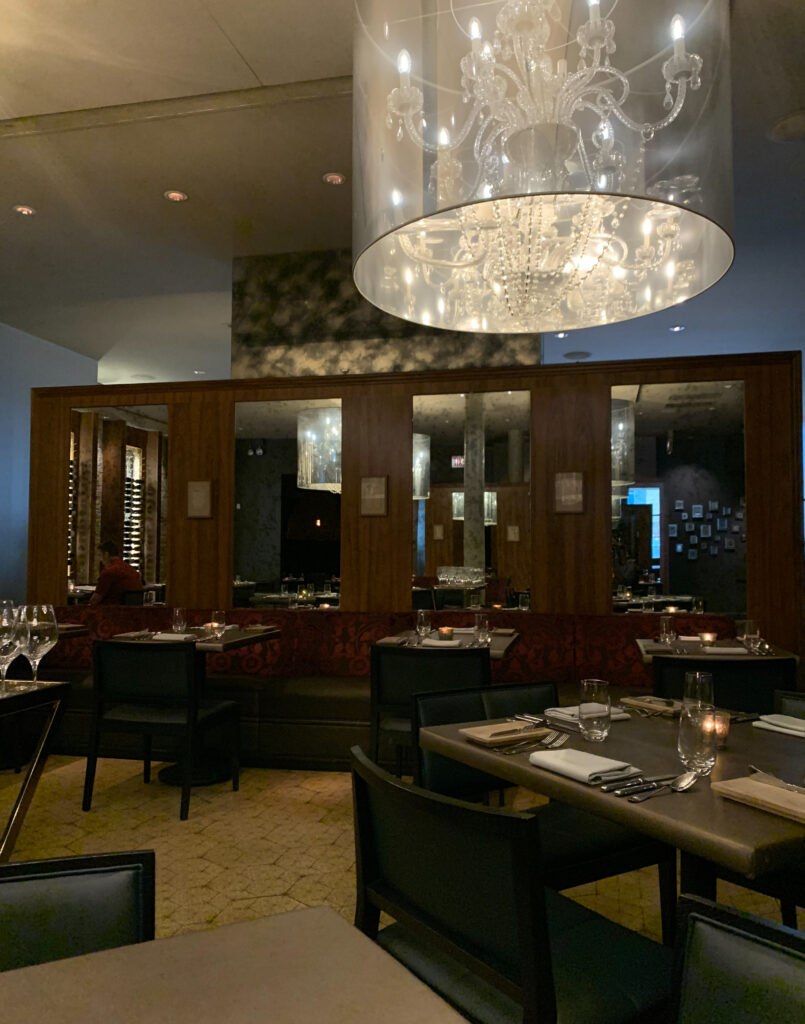
Returning to the host stand, you are met with a cheery greeting, your name is checked off, and a member of the team—menus in tow—leads the party beyond the bar. The hostess makes idle small talk, a touch that should never be taken for granted, as she traces a path into the dining room. The space, as you approach it, revolves around a slender central column. Four crystal chandeliers, sheathed by cylinders of glass, are positioned equidistantly at 45º angles from this point. The floor is lined with four-top tables while wood-clad walls (forming the other side of the bar and running along the opposite end of the room) contain two-top banquettes. Those walls are also set with distressed mirrors, which serve to expand your perception of the space.
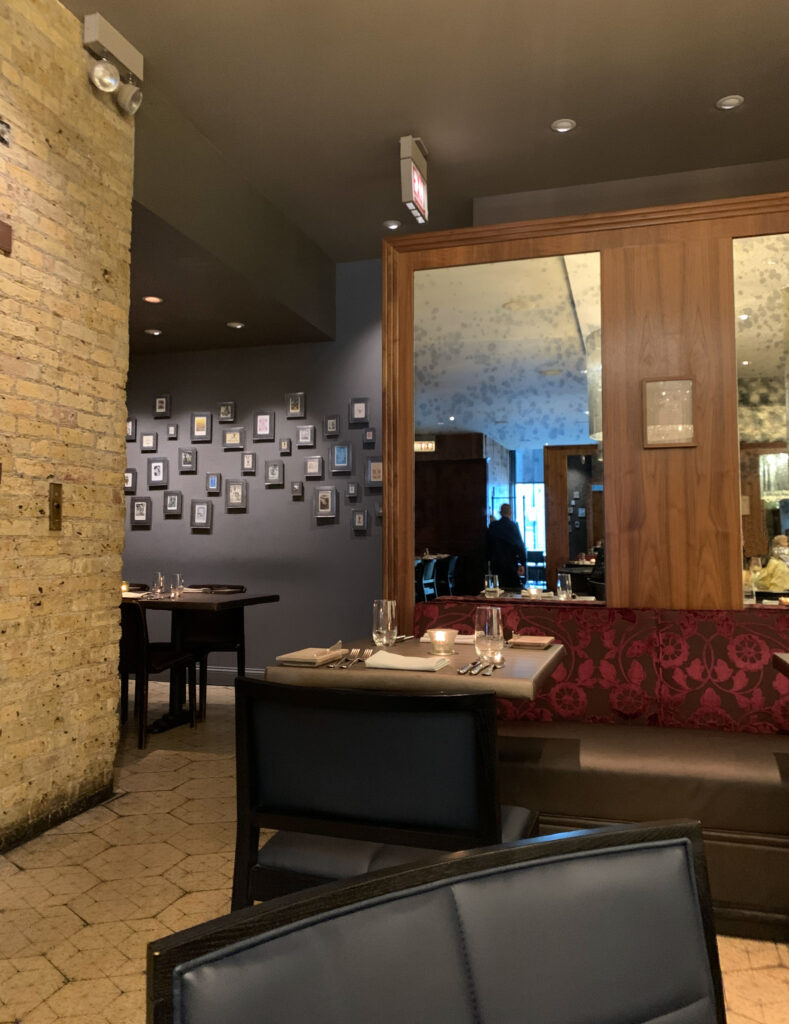
Other notable details, running along the dining room’s outer walls, include floor-to-ceiling wine racks (wood set onto brick), a set of hulking metal doors (an old warehouse elevator?), and hanging planters. Vintage photographs (as seen in the lounge) hang in certain corners while hexagonal tiling and thick, brown curtains run throughout the entire restaurant. Only a couple semi-private rooms, with seating for up to eight in dramatic, cavernous quarters, hide just barely out of sight toward the rear and the kitchen/bathrooms.
Ultimately, especially when you consider how spaciously the tables are arranged, Sepia’s dining room is more about function than grandeur. You think this is echoed throughout the entire restaurant, which is really only enriched by elements like the folding camera and certain ornate pieces of glassware, and it certainly harmonizes with the building’s worn but dignified façade. The overall effect is that the restaurant, despite its Michelin star, feels conventional and recognizable. It feels like a place that could exist back in your hometown. It feels classic.
Depending on the expectations a given guest brings to the table, they may be a bit skeptical of this aesthetic. Despite a shared sense of history, Sepia cannot trade so much on its surrounding environment like North Pond. Instead, it exists in a neighborhood where Kehoe Designs can concoct an “Instagrammable moment” using nothing more than some trellises and cheap hanging fabric. Consumers drawn to fine dining today care almost as much about how they look (and how they are recorded) enjoying the experience as they do the ultimate quality of the service or food. And Sepia, unless you happen to be a large party dining in one of its semi-private spaces, does not offer that kind of signature snapshot.
Just the same, the restaurant is comfortable in its skin. You think of Boka—with its hodgepodge of tacky celebrity portraits and anthropomorphic animals—as a place that, at maturity, is trying too hard to seem hip. But patrons, no doubt, enjoying posing in front of these details. Novelty and a sense of irreverence certainly form an antidote to fine dining’s stereotypical snobbery. Yet Sepia, you have already seen, weaves that attitude into the actual cuisine while Boka continues serving a poor facsimile of what Eleven Madison Park was doing a decade ago.
At best, Nony has curated a space that now seems a bit plain. You hesitate to use the word “dated,” for many a new concept would love to draw on the history of the old brick and metal accents. And maybe, instead of irreverence, there is something comfortable about sitting in a dining room that feels familiar. At the very least, it offers a blank canvas for you to define your own evening and to allow the other aspects of the experience to really take hold, which may be a good or a bad thing depending on their actual quality.
Upon reaching the table, you take your seat and, after indicating your preference of water to the oncoming busser, turn your attention to the menus before you. Sidestepping the leatherbound wine tome for now, you find an assortment of libations on the side opposite the food.
Head bartender Keith Meicher’s work comprises 10 different cocktails at present, each priced between $14 and $18 (a range that generally accords with the neighborhood and with other concepts at this level). Admirably, he also avoids the temptation of offering “premium” or “reserve” drinks that, while sometimes interesting, represent a form of premiumization that pressures consumers to spend more money so as not to feel they are imbibing something “lesser.” (Of course, it’s never hard to substitute one liquor for another from the top shelf should you so desire.)
Of the current selection, you have sampled four cocktails. The “Pulaski at Night” (Pisco, Bruto Americano, rhubarb, lime, ginger, Chinese five spice, egg white) is pleasantly bracing and herbaceous but just a little medicinal to your palate. The “New Romantic” (Tito’s Vodka, lemon, plum-cinnamon jam) is a pristine play on a “Gin & Jam” that goes down dangerously easy. The “Single Barrel Old Fashioned” (Koval Single Barrel Bourbon, Angostura, demerara, saffron ice) is perfectly balanced with a kiss of wood, a bit of sweetness, a hint of tang, and absolutely no heat on the finish. Lastly (and best of all), the “Savoir Faire” (Thai basil-infused rum, smoked pineapple, chrysanthemum, boba) is beautifully executed with a layered, resonant sweetness and a well-judged undercurrent of florality. Overall, three of the four cocktails really impress, and you think Meicher is doing great work.
Along with a short list of five “Seasonal Beers” (predominantly sourced from Chicago along with one from Maine and one from Cleveland), you also find the “Wines by the Glass” on the opposite side of the food menu. This is wine director Alex Ring’s province, and the selection merits being considered in its totality:
Champagne + Sparkling
- NV Borgoluce “Lampo”Prosecco di Treviso ($14)
- NV Raventós i Blanc “de Nit” Rosado Cataluyna ($17)
- 2021 Carboniste “Gomes Vineyard” Albariño ($19)
- 2016 Ferrari “Perlé” Trento ($20)
- NV J. Lassalle “Cuvée Préférence”Champagne 1er Cru ($31)
White
- 2020 Adega de Demo “Bitoku”Ribeiro ($16)
- 2022 Weingut Keller “Weissburgunder & Chardonnay” Rheinhessen ($21)
- 2020 Comte Henry d’Assay Sauvignon Blanc Touraine ($18)
- 2010 C.H. Berres “Urziger Würzgarten” Riesling Kabinett Mosel ($20)
- 2016 Didier Dagueneau “Jardins de Babylone” Sec Juraçon ($24)
- 2020 Dominique Cornin “Les Serreuxdières” Mâcon-Chaintré ($19)
Rosé & Orange
- 2022 Couly-Dutheil “René Couly” Chinon Rosé ($16)
- 2021 Enderle & Moll “Weiss & Grau” Baden ($15)
Red
- 2019 Noa “Noah of Areni” Vayots Dzor ($18)
- 2021 Marcel Lapierre Morgon ($24)
- 2021 Deovlet Pinot Noir Santa Barbara County ($22)
- 2017 Aperture Cellars Red Blend Alexander Valley ($28)
- 2016 La Rioja Alta “Viña Aradnza” Rioja Reserva ($25)
Starting with the sparkling, you find a range of value-driven options under $20 like a Prosecco, a Spanish rosé, an a domestic Albariño. Of these, the latter two are produced using the méthode traditionnelle (with secondary fermentation occurring in bottle), a process that replicates Champagne. However, with the jump up to $20, you can get the “Perlé,” a vintage-dated sparkler that is also made in the traditional method but has the added benefit of utilizing 100% organic Chardonnay grapes. Thus, this option (while still a representing a good value) comes even closer to a blanc de blancs bubbly from France. However, those who will not settle for anything but the real thing, will find that $31 secures them a great representation of the appellation: a Pinot Meunier-dominant, non-vintage blend made from premier cru vineyards that offers both approachability and depth.
With the whites, you see a pronounced Old World focus; however, the selection ticks two major boxes: Sauvignon Blanc (from the Loire) and a fuller-bodied Chardonnay (from the Mâcon region of Burgundy). These are mainstream choices that are sure to please guests who favor popular examples of the varieties from Sancerre, New Zealand, or California. Beyond that, you find a round and refreshing Ribeiro (representing the value pick), a bright blend of Pinot Blanc and Chardonnay (from the esteemed producer Keller), and an off-dry Riesling with an impressive 13 years of age (how many restaurants can offer that by the glass?). The Dagueneau Juraçon is a bit of an oddball in the top-priced spot, yet it offers the kind of richness and concentration (along with a famous name) those spending more might want.
The rosé and orange category is short but sweet—and, frankly, you are excited to see it featured in general. Coming from a notable Loire producer, the Couly-Dutheil is fresh, fruity, and drinkable. The “Weiss & Grau,” by comparison, is clean and silky with a pleasant tannic bite. It’s a perfect introduction to the orange category from a cult biodynamic estate.
Lastly, with the reds, you once more find a crowd-pleasing spread. First, in the value position, Ring pours a surprising Armenian wine with concentrated cherry notes and a robust texture that, nonetheless, fulfill what guests expect from a baseline option. Moving toward the more premium selections, lovers of Old World wines will find—in the Morgon and Rioja—two classic, characterful pours (from top producers) to choose from. Those who favor domestic, likewise, find themselves rewarded with a rich Pinot Noir and an even richer Malbec/Merlot blend. While something Italian might be worth considering, Ring covers all his bases with aplomb.
Overall, you must praise this by-the-glass list for the way it balances geekiness and broad appeal. The chosen wines, moreover, are not the same ones you see being poured everywhere else in the city (where some distributors have all but cornered the market in certain categories). Rather, this selection facilitates education (grape varieties being listed in parentheses is a nice touch) and conversation (with the servers or sommelier) for newcomers and oenophiles alike. It encourages a sense of never-ending discovery that gets at the core of what makes fermented grape juice such a fulfilling hobby while, simultaneously, offering a taste of true icons. Yes, you must admit there are at least two choices under each heading that, even as someone that typically opts for bottles, you would not hesitate to order—a high compliment.
All that being said, it is Sepia’s bottle list that shines the brightest. The following are representative selections from throughout the year:
Half Bottles
- MV Champagne Brice “Heritage” ($77)
- 2020 Seehoff “Kirschspiel” Riesling Trocken Rheinhessen ($58)
- 2018 Merry Edwards Sauvignon Blanc Russian River Valley ($60)
- 2020 Weiser-Künstler “Enkircher Ellergrub”Riesling Auslese Mosel ($79)
- 2020 Jean-Philippe Fichet Meursault ($129)
- 2019 Ridge “Lytton Springs” Sonoma County ($62)
- 1996 Château Musar Beqaa Valley ($148)
Magnums
- MV Pierre Paillard “Les Parcelles”Champagne Grand Cru ($239)
- MV Veuve Fourny et Fils “Grande Réserve”Champagne 1er Cru ($265)
- 2016 Robert Weil Riesling Kabinett Rheingau ($125)
- 2015 Duplessis “Vaillons”Chablis 1er Cru ($245)
- 2015 Gut Oggau “Josephine” Burgenland ($270)
- 2007 Oddero “Brunate”Barolo ($445)
- 2011 Clos des Papes Châteauneuf-du-Pape ($495)
- 2011 Ridge “Monte Bello”Santa Cruz Mountains ($945)
Sparkling
- MV Casa de Piedra “Espuma de Piedra”Blanc de Blancs Valle de Guadalupe ($72)
- 2018 Peter Lauer Riesling Sekt Saar ($76)
- MV Schloss Gobelsburg “Brut Reserve” Kamptal ($98)
- MV Marguet “Shaman” Champagne Grand Cru ($129)
- MV Bérèche “Réserve” Champagne ($139)
- MV Pehu Simonet “Face Nord” Champagne Grand Cru ($139)
- MV Nowack “Les Bauchets” Blanc de Noirs Champagne ($144)
- MV Pierre Péters “Cuvée de Réserve”Blanc de Blancs Champagne Grand Cru ($159)
- MV Georges Laval “Garennes”Champagne ($164)
- 2018 Thomas Perseval “Tradition”Champagne 1er Cru ($164)
- 2016 Marie-Courtin “Eloquence” Blanc de Blancs Champagne ($168)
- MV Egly-Ouriet “Les Premices”Champagne ($195)
- MV Georges Laval “Cumières”Champagne 1er Cru ($224)
- MV Henri Billiot “Cuvée Laetitia”Champagne Grand Cru ($235)
- 2017 Ulysse Collin “Les Maillons”Blanc de Noirs Champagne ($239)
- NV Egly-Ouriet “Les Vignes de Bisseuil” Champagne ($255)
- 2018 Roses de Jeanne “Haute-Lemblée”Blanc de Blancs Champagne ($276)
- NV Benoit Dehu “Cuvee de l’Orme”Champagne ($285)
- NV Jérôme Prévost / La Closerie “Les Beguines”Champagne ($288)
- 2015 Suenen “Les Robarts”Blanc de Blancs Champagne Grand Cru ($325)
- MV Jacques Selosse “Initial” Grand Cru Blanc de Blancs Champagne ($485)
- 1990 Veuve Clicquot “Cave Privée”Rosé Champagne ($496)
- 2004 Louis Roederer “Cristal”Champagne($600)
White
- 2021 Weiser Künstler Feinherb Riesling Mosel ($59)
- 2020 Maison des Ardoisières “Silice”Savoie ($66)
- 2021 Hofgut Falkenstein “Niedermenniger Herrenberg”Riesling Kabinett Trocken Mosel ($74)
- 2017 Venica “Ronco delle Cime”Friulano Collio ($74)
- 2020 Weingut Keller Riesling Trocken Rheinhessen ($75)
- 2013 Forstmeister Geltz Zilliken “Saarburger Rausch”Riesling Kabinett Saar ($79)
- 2019 Lingua Franca “Avni” Chardonnay Willamette Valley ($89)
- 2020 Thibaud Boudignon Anjou Blanc ($89)
- 2007 Robert Weil “Kiedrich Gräfenberg”Riesling Spätlese Rheingau ($99)
- 2021 Nanclares y Prieto “Paraje Mina”Rias Baixas ($111)
- 2019 Passopisciaro “Passobianco” Sicilia ($111)
- 2020 Cantina Terlan “Terlaner”Südtirol-Alto Adige ($113)
- 2018 J.J. Prüm “Wehlener Sonnenuhr”Riesling Spätlese Mosel ($118)
- 2015 Lail “Blueprint” Sauvignon Blanc Napa Valley ($120)
- 2018 Domaine du Collier Saumur Blanc ($124)
- 2005 Schlossgut Diel “Dorsheimer Burgberg”Riesling Auslese Nahe ($125)
- 2020 Kumeu River “Hunting Hill”Chardonnay Auckland ($131)
- 2021 Walter Scott “Cuvée Anne”Chardonnay Willamette Valley ($131)
- 2017 Domaine Rougeot “Sous la Velle”Meursault ($135)
- 2016 A & JF Ganevat “Fortbeau”Côtes de Jura ($139)
- 2008 Dönnhoff “Schlossbockelheimer Kupfergrübe”Riesling Spãtlese Nahe ($139)
- 2020 Domaine du Pélican “Grand Curoulet”Savagnin Ouillé Arbois ($155)
- 2020 Morey-Coffinet “Climat du Val”Auxey-Duresses 1er Cru ($158)
- 2017 Bindi “Kosta’s Rind”Chardonnay Macedon Ranges ($162)
- 2015 Cantina Terlan “Novadomus”Südtirol-Alto Adige ($162)
- 2008 Trimbach “Cuvée FrédéricEmile”Riesling Alsace ($162)
- 2016 Gut Oggau “Weiss” Burgenland ($163)
- 2017 Domaine Méo-Camuzet “Clos Saint-Philibert”Hautes-Côtes de Nuits ($164)
- 2007 Weingut Keller “Westhofener Kirchspiel”Riesling Auslese Rheinhessen ($170)
- 2018 Domaine Guiberteau “Brézé”Saumur ($176)
- 2019 Tiberio “Fonte Canale”Trebbiano d’Abruzzo ($178)
- 2018 Domaine Didier Dagueneau “Blanc Fumé de Pouilly”($179)
- 2009 Domaine Marcel Deiss Altenbergde BergheimAlsace Grand Cru ($188)
- 2018 Domaine Michel Lafarge “Vendages Seleccionées”Meursault ($192)
- 2015 Emidio Pepe Pecorino d’Abruzzo ($195)
- 2008 Gravner Ribolla Gialla Friuli-Venezia Giulia ($198)
- 2016 Schäfer-Fröhlich “Bockenauer Felseneck”Riesling Trocken GG Nahe ($198)
- 2016 Domaine Guiberteau “Clos des Carmes”Saumur ($206)
- 2020 Jean-Marc Pillot “Les Masures”Chassagne-Montrachet ($215)
- 2012 Catena Zapata “White Bones”Chardonnay Mendoza ($225)
- 2015 Domaine Didier Dagueneau “Buisson Renard”Pouilly Fumé ($264)
- 2016 Domaine Bernard Moreau “La Maltroie”Chassagne Montrachet 1er Cru ($398)
- 2020 Weingut Keller “Hubacker”Riesling GG Rheinhessen ($495)
- 2012 Domaine Vincent & Sophie Morey Bâtard-Montrachet Grand Cru ($695)
- 2017 Domaine des Comtes Lafon “Poruzots” Meursault1er Cru ($788)
Red
- 2021 Anne Sophie Dubois “l’Alchemiste”Fleurie ($77)
- 2020 Chacra “Barda”Pinot Noir Patagonia ($78)
- 2013 Clendenen Family Nebbiolo Santa Maria Valley ($94)
- 2020 Alain Graillot Crozes-Hermitage ($98)
- 2019 Enderle & Moll “Liaison” Pinot Noir Baden ($98)
- 2017 Roagna Langhe Rosso ($116)
- 2010 R. Lopez de Heredia “Viña Tondonia”Rioja Reserva ($124)
- 2017 Mas de Daumas Gassac Languedoc ($136)
- 2018 Trediberri Barolo ($140)
- 2014 Elvio Cogno “Pre-Phylloxera”Barbera d’Alba ($155)
- 2019 Auguste Clape “Les Vins des Amis”VdF ($161)
- 2017 Domaine Jean Grivot “Les Charmois”Nuits-Saint-Georges ($162)
- 2018 Heitz Cabernet Sauvignon Napa Valley ($181)
- 2019 Matthiasson Cabernet Sauvignon Oak Knoll District ($186)
- 2017 Domaine Méo-Camuzet Marsannay ($187)
- 2006 Château Gloria St. Julien ($194)
- 2018 Snowden “Brothers Vineyard”Cabernet Sauvignon Napa Valley ($224)
- 2012 Domaine Henri Boillot Volnay ($268)
- 2001 R. Lopez de Heredia “Viña Tondonia”Rioja Gran Reserva ($278)
- 2000 Château Sociando-Mallet Haut-Mèdoc ($288)
- 2019 Anne Gros “La Combe d’Orveau”Chambolle-Musigny ($290)
- 2016 Roagna “Faset”Barbaresco ($295)
- 2017 Domaine Confuron-Gindre “Les Chaumes”Vosne-Romanée ($298)
- 2004 Azelia “Bricco Fiasco”Barolo ($314)
- 2012 Fontodi “Flaccianello” Tuscany ($333)
- 2001 Dalla Valle Cabernet Sauvignon Napa Valley ($344)
- 2012 Araujo Estate “Altagracia” Napa Valley ($364)
- 2014 Vietti “Lazzarito”Barolo ($385)
- 2016 Domaine Marquis d’Angerville “Fremiets”Volnay 1er Cru ($392)
- 2018 Pierre Gonon Saint-Joseph ($418)
- 2015 Benjamin Leroux “Caillerets” Volnay 1er Cru ($421)
- 2017 Bartolo Mascarello Barolo ($444)
- 2006 Château Pape Clément Pessac-Leognan Grand Cru ($458)
- 2013 Cerbaiona Brunello di Montalcino ($475)
- 2014 Clos Rougeard “Les Clos” Saumur-Champigny ($488)
- 2014 Ghislaine Barthod “Aux Beaux Bruns”Chambolle-Musigny 1er Cru ($518)
- 2016 Corison “Kronos Vineyard”Cabernet Sauvignon St. Helena ($529)
- 2010 Château Smith Haut Lafitte Pessac-Léognan Grand Cru ($545)
- 2015 Domaine Jamet Côte Rotie ($574)
- 1998 Château Canon-La-Gaffalière Saint-Èmilion Grand Cru Classé ($625)
- 2015 Tenuta dell’Ornellaia “Ornellaia” Tuscany ($698)
- 2016 Opus One Napa Valley ($725)
- 2011 Château de Fonsalette Côtes-du-Rhône ($842)
Taking all this in, it is impossible to deny that Sepia boasts one of the best—if not the best (at least at the one-Michelin-star level)—wine selections in the city. Sure, in the steakhouse stratum, somewhere like Maple & Ash offers an incredible collection (though, when you consider what the bottles go for, not exactly priced to move). Likewise, Les Nomades, 45 years on, offers quite a deep assortment of Champagne, Burgundy, Bordeaux, and Rhône with a mix of deals and (understandable) markups awaiting those who visit this gastronomic grande dame.
Alinea’s cellar is rather deep—with respectably moderate prices in many cases—even if its focus remains on classic producers that do not quite philosophically match the food. Ever’s, in turn, looks deep on the surface but actually reflects a “throw everything at the wall and see what sticks” approach that falls flat once the top quality-price ratio bottles have been picked off. By comparison, Oriole and Smyth offer collections that are more concise but also a bit nimbler when it comes to introducing the latest and greatest labels. The former restaurant, as of late, has done a better job of amassing enticing bottles, yet both properties maintain laudable pricing philosophies.
At the one-star level, you have previously noted your disappointment with the programs at Boka (depleted selection, high markups) and Galit (narrow focus, high markups). Only Elske, with its incredibly discerning selection of natural wines, really sings (while Atelier, Kasama, North Pond, Temporis, and Topolobampo offer some good choices at fair prices while not quite rising to the level of being “wine destinations”).
Sepia’s list is exceptional, first and foremost, due to its breadth of offerings: everything from classic producers (Heitz, Méo-Camuzet, J.J. Prüm) and appellations (Alsace, Barolo, Bordeaux) to new, cult names (Ulysse Collin, Ganevat, Weiser-Künstler) and regions (Jura, Patagonia, Savoie). Stylistically, the program effortlessly incorporates natural, orange, and skin-contact wines without offering anything too weird or beating customers over the head with their trendy status. Rather, across the board, the chosen bottles reflect thoughtful curation and a sense of trust: you can feel safe picking anything, at any price, in a favored category without feeling burned.
Complementing the sheer scale of Sepia’s list is its depth of vintages: some, no doubt, sourced from elsewhere (given they predate the restaurant’s opening), but others simply purchased years ago and aged. These older labels are, of course, a testament to all the work Scott Tyree, Arthur Hon, and Jennifer Wagoner did in their respective eras. However, Nony also deserves credit for supporting this kind of program and allowing his team to buy case quantities that will actually stick around for a while. No amount of decanting can amply replicate the thrill of drinking a mature wine, and Ring’s list offers opportunities at a variety of different price points (even, as you recall, by-the-glass) to enjoy the fruits of proper aging.
Nonetheless, both of these factors are—most importantly—filtered through Sepia’s pricing philosophy. Once again, Nony deserves immense credit for fostering a program that rewards (rather than punishes) oenophiles. Here are some instructive examples:
- 2017 Ulysse Collin “Les Maillons”Blanc de Noirs Extra Brut Congy ($239 on the list, $315 at local retail)
- MV Jacques Selosse “Initial” Grand Cru Blanc de Blancs Avize ($485 on the list, $499 at domestic retail)
- 2018 J.J. Prüm Wehlener SonnenuhrRiesling Spätlese Mosel ($118 on the list, $56 average on Wine-Searcher)
- 2020 Weingut Keller HubackerRiesling GG Rheinhessen ($495 on the list, $349 at local retail)
- 2020 Thibaud Boudignon Anjou Blanc ($89 on the list, $42.99 at local retail)
- 2018 Domaine Guiberteau Brézé Saumur ($176 on the list, $200 at Boka)
- 2017 Domaine des Comtes Lafon Meursault-Porusots 1er Cru ($788 on the list, $499 at domestic retail)
- 2021 Walter Scott “Cuvée Anne”Chardonnay Willamette Valley ($131 on the list, $142 at Boka)
- 2020 Alain Graillot Crozes-Hermitage ($98 on the list, $115 at Boka)
- 2017 Roagna Langhe Rosso Piedmont ($116 on the list, $51 at local retail)
- 2016 Roagna “Faset” Barbaresco Piedmont ($295 on the list $334 at Boka)
- 2017 Bartolo Mascarello Barolo Piedmont ($444 on the list, $249 at domestic retail)
Sepia’s pricing shines not only in comparison to its one-Michelin-star peers (with Boka, your point of comparison, applying some of the highest mark ups) but overall. For, at the lower end of the spectrum, the restaurant sells bottles at around a 100%-130% premium (about as low as you ever see), and, at the higher end, Ring refuses to tack on an extra sum for wines that are particularly rare. Thus, many selections do not only fall under that 100% markup (the Keller and Lafon notably) but—as in the case of the Ulysse Collin and Selosse—can actually be purchased for less at the restaurant than at retail. While it should be kept in mind that you will (or, at least, should) be paying at least a 20% gratuity on top of that, finding these deals is a special joy for any wine lover.
At the end of the day, this all speaks to a program that, foundationally, celebrates the marriage of fine food and wine. Nony presides over one of the lamentably few restaurants in Chicago that affirms the city’s reputation as one of the birthplaces of contemporary American wine service and appreciation. When other groups, of far greater size and with far more resources at their disposal, sold off their cellars during the pandemic, he and Sepia held strong. The surviving collection is not treated as a cynical profit center but a bonafide piece of gastro-cultural heritage. Diners should feel lucky to be hosted by this kind of restaurateur, a dying breed of dyed-in-the-wool gourmand, whether he actually touches their table or not.
And you do not mean to discount Ring’s role in all of this, having stepped into a position where he need only act as a custodian but has, in truth, meaningfully built on the work of his predecessors. The most recent additions to the list (most obviously the 2019 and 2020 vintages along with some slightly older Champagnes) continue a long tradition of embracing the best of the wine world’s new blood. These selections (you think of names like Anne Sophie Dubois, Hofgut Falkenstein, and Suenen) ensure Chicagoans’ tastes can keep pace with those on the coasts. Bottle by bottle, they help the city stay engaged in national—if not global—conversations regarding the changing nature of “quality wine.” And, when combined with Sepia’s “contemporary American” cuisine, they ensure the fruits of the vine still have a place at the table even as wider eating habits change.
At a more administrative level, Ring’s wine list features a consistent, readable style (with grape varieties, once more, provided when instructive) that is almost entirely free of errors (you only count one: “Dalle Valle” [sic] instead of “Dalla Valle”). This is no mean feat when you consider the beverage book’s nearly 60 pages of content, content that goes well beyond simply enumerating the various wines.
Yes, following in the footsteps of wine directors past, Ring’s list welcomes guests by affirming the program’s support of “producers who are committed to sustainable agriculture” and “artisinal [sic] practices, both ancient and new.” The selections aim to highlight “delicious wines that taste of the unique places they come from” but, moreover, center on a “sincere hope” that “you and your guests can share a special moment over good conversation, food, and wine.” This sentiment may seem trite when put forth by greedier restaurant groups but, here (and thinking especially of the value proposition offered across the board), totally rings true. It verbalizes that same “celebratory” feeling you perceive from the pricing philosophy while also speaking to the kind of social bonding that makes these experiences transcendent.
The first page of the book also plainly notes the restaurant’s policy for bringing your own wine, which “kindly ask[s] that you limit corkage to two 750ml bottles or one magnum” that are not already offered on the list. The associated prices ($35 for the first bottle, $50 for the second bottle, $75 for a magnum) are rather fair when you (again) consider the degree of value offered across the entire program. Plus, as at any restaurant that abides by the unwritten rules of hospitality, the corkage fee is waived for every bottle you buy off of the list.
Moving beyond the front cover, the beverage book is distinguished by four pages of “Features & Notables” that Ring uses to showcase particular products. Headings like “Three Centuries of Bhakta Armagnac,” “Terroir in Champagne: A Question of Scale,” “Alheit Vineyards: South African Chenin Blanc and the Spirit of Exploration,” and “A Selection of Mount Etna’s Finest Vineyard Sites from Passopisciaro” are joined by equal parts storytelling, technical information, and tasting notes. These kinds of educational blurbs are increasingly rare even at Chicago’s greatest “wine destinations,” and they represent an engaging, enriching bonus for those browsing the selection regardless of their degree of prior knowledge.
Delving further into the book, you also note an extended by-the-glass section that includes three apértifs (including a vin jaune), four sweet wines, two ports, two Madeiras, two sherries, and three vins de liqueur (like Pineau des Charentes, Ratafia, and Jean Bourdy’s “Galant des Abbesses”). At a time when few restaurants are able to pour more than one or two dessert wines at a time, this array of options is downright formidable (and, once again, empowers guest education in styles of wine they might never try in a larger, more expensive format).
All this good work managing the program and writing out the list (to saying nothing of the $59 pairing offered alongside the menu or the wine events Sepia has hosted during his tenure) culminates in Ring’s actual approach to service. His tableside manner is effortlessly warm and calming, with a gentle touch that helps expand the audience of vinous appreciation without any trace of snobbery or judgment. (This extends to making guests who favor drinking beer, cocktails, or just plain water feel every bit as welcome in the dining room.) Just the same, should you already be initiated into bacchanalian pleasures, the wine director handles your chosen bottles with a coolness and confidence that belie total technical precision. Of course, the passion he carries for his work always bubbles under the surface, and, when it is engaged, he happily indulges in the shared delight that finding great options at such appealing prices naturally stokes in his customers.
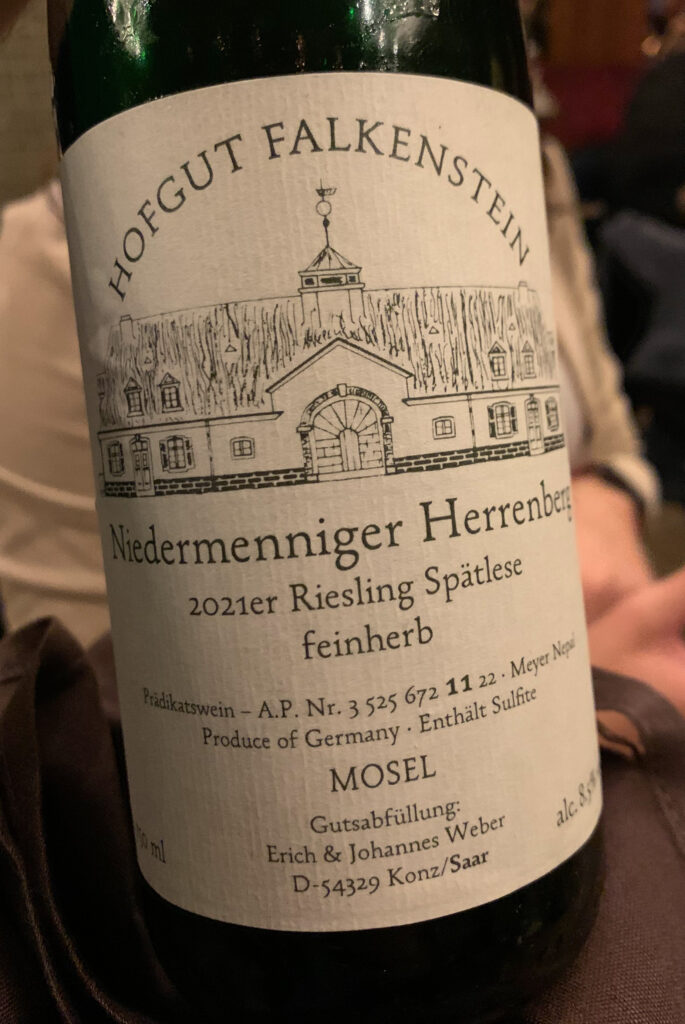
With the right restaurateur behind him and a carefully nurtured collection supporting him, Ring is just the kind of sommelier that excites you to go back—week after week or month after to month—for another tipple. He ranks as one in a short list of wine professionals in Chicago who manage programs with a real sense of personality while also preserving value (that is, as much as they can relative to outside forces). This list, at present, includes: Nick Berggren (The Purple Pig), Kevin Bratt (Joe’s), Louis Fabbrini (Smyth), Richard Hanauer (RPM), Thibaut Idenn (Boka), Nicolas Poilevey (Obélix), Jelena Prodan (Valhalla), Emily Rosenfeld (Oriole), Michael Seward (Pops for Champagne), Christian Shaum (Bazaar Meat), and Emily Sher (Elske).
As at any restaurant, Ring’s aptitude for leadership is best judged by seeing how effectively he deputizes the rest of the team to conduct wine service. One evening, while he was away (at the opera, you were told, which seems rather fitting for a sophisticated sommelier), your bottles were placed under the care of the captain. The selections you made off of Sepia’s list were quickly retrieved and confidently presented. Your Champagne arrived well chilled and was served, without prompting, in the kind of all-purpose glass you prefer over flutes. The captain also made sure to ask how (temperature, decanting) and when you would like your second bottle served.
As to the magnum you brought along as corkage, the captain received it confidently (asking, once more, if you would like it decanted) and kept it on top of ice until later as requested. Once again, without prompting, they then made sure you had the proper glassware in front of you to drink it before the entrées arrived. All in all, the captain did an expert job of facilitating wine service in Ring’s absence—with any lack of the same geeky enthusiasm (something you would only expect from a trained sommelier) more than made up for by a sense of anticipation and fluidity. These estimable traits extend, rather naturally, to the kind of service offered throughout the entire meal.
Some fine dining restaurants—principally at the multi-Michelin-star level—work to build a sense of tension that amplifies diners’ latent expectations and reaches its crescendo in that first magnificent bite. It’s a sensible strategy: guests get dressed up to take in a stiff, rehearsed show in a cold, dark setting that culminates in the cathartic release of some incomparable flavor. When this works, it really works, and certain consumers (at best due to inexperience or at worst for reasons of status insecurity) are predisposed to feeling that magic without fail. For others, the spell eventually lifts and the cold reality hits: there are few living chefs capable of resolving that contrived tension in a rewarding way, and those who can typically do not hide behind such a serious mask to begin with.
Sepia has lived through Alinea’s heyday and, it should be remembered, consciously made its experience a bit more serious in the wake of earning its Michelin star. As the “smoke and mirrors” molecular gastronomy style has, along with the traditional French tasting menu, waned, what Nony and Zimmerman offer has just about remained the same: refined “contemporary American” food in a familiar, comfortable setting with an exceptional beverage program and a level of service that has consistently been praised. Compared to Boka (with its greenhouse) and North Pond (with its total immersion in nature), Sepia—now surrounded by countless other concepts—does not seem like an obvious “destination restaurant.” However, with Chicago’s dining landscape having shifted over the past two decades, it now stands as something of a rare bird.
To you, the unassuming character of Sepia’s exterior and interior design aligns with cult favorites like Oriole and Smyth: “contemporary American” concepts that eschew heavy-handed branding and a suffocating mystique in favor of a quiet, customer-focused approach. While Oriole “2.0” has certainly (and effectively) expanded how it expresses itself at a visual level, you think all three restaurants still share a certain fundamental restraint. They are content to let each singular interaction, sip, and nibble tell their story rather than building an elaborate scaffolding of expectations management through the cultivation of a celebrity chef figure, influencer bait presentations, and other associated media manipulation.
Oriole and Smyth, with their two Michelin stars and premium price points, still form natural destinations: fancy fine dining restaurants (in theory) that are surprisingly disarming in practice. Sepia, compared to its one-Michelin-star peers (many pigeonholed into more easily digestible genres), stands—apart from a proud history—as more of an unknown quantity. And, as Fulton Market and Randolph become playgrounds for calculated, big-budget openings, the restaurant’s appeal—however legitimate or lasting—is increasingly drowned out.
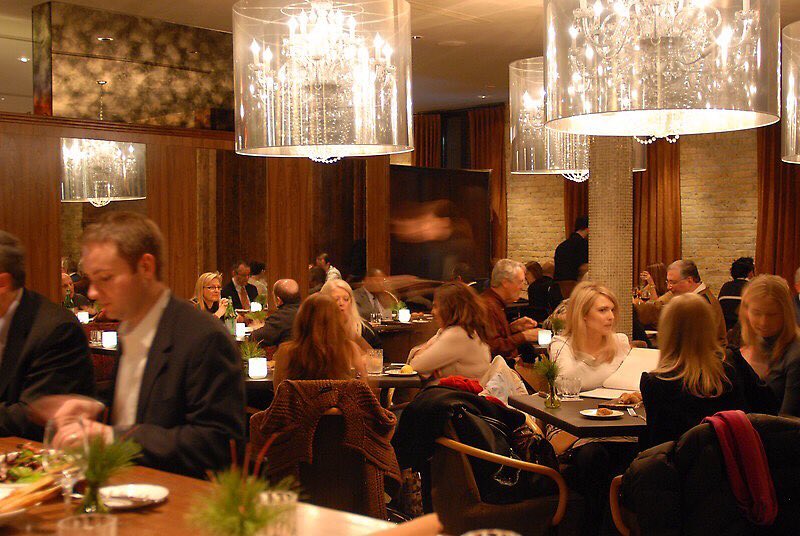
This is the context in which you must appreciate Sepia’s service, the foundation of an experience that cannot rely on any kind of trends or viral appeal to help soften up the guests. It also cannot, as you have stated, draw on the wider environment to make the evening memorable.
Every instinct would say that, in order to compensate, Sepia’s front-of-house team must come to the table armed with unfailing deference, streamlined spiels, perfect synchronization, and everything short of actual prestidigitation. The thought is: if the restaurant doesn’t look the part of the imagined “one Michelin star” concept, it should at least communicate that grandeur at the level of interaction. Uncanny or not, the staff should clearly exhibit something that suggests what the premium price patrons are paying goes toward.
Instead, Sepia’s captains and bussers are not painstakingly programmed. They do not speak of “the chef” as a hallowed figure or draw upon the restaurant’s reputation as an “institution” to enforce a certain way of doing things around here. No, they exhibit a tableside manner that lands somewhere between the (somewhat corporate-tinged) polish of Boka and the raw charm of North Pond’s young team with an extra dash of conscientiousness.
Sepia’s front of house reflects a high degree of experience and fluency (befitting the restaurant’s maturity). However, what strikes you most is the team’s sensing quality: an ability to read and meet each table’s energy level, to engage genuinely whatever that may be, rather than trying to proselytize or prod the party toward some concocted ideal. Enthusiasm, humor, and a heartfelt appreciation for your patronage all flow effortlessly here. The sensation, to bring the comparison to Oriole and Smyth back around, transcends “fine dining” and lands more in the realm of “beloved neighborhood restaurant.”
Though you haven’t seen Nony working the floor himself across your visits, his managers lead by example and personify the same friendly, fully-in-the-moment disposition you see reflected in the captains and bussers. Understandably, this kind of attitude can only flow from the top: a reality that empowers every member of the team to bring their true self to the table and make a meaningful connection with their guests. At the very least, they enable diners—unconstrained by the pressures of how to act in a “fine dining setting”—to forge deeper social bonds with each other.
To that point, the degree of ease Sepia’s front of house exhibits in their work actually fuels—rather than inhibits—a level of technical excellence that is ironically (poetically?) harder to achieve when workers are constrained by oppressive, micro-managed systems that consciously chase plaudits.
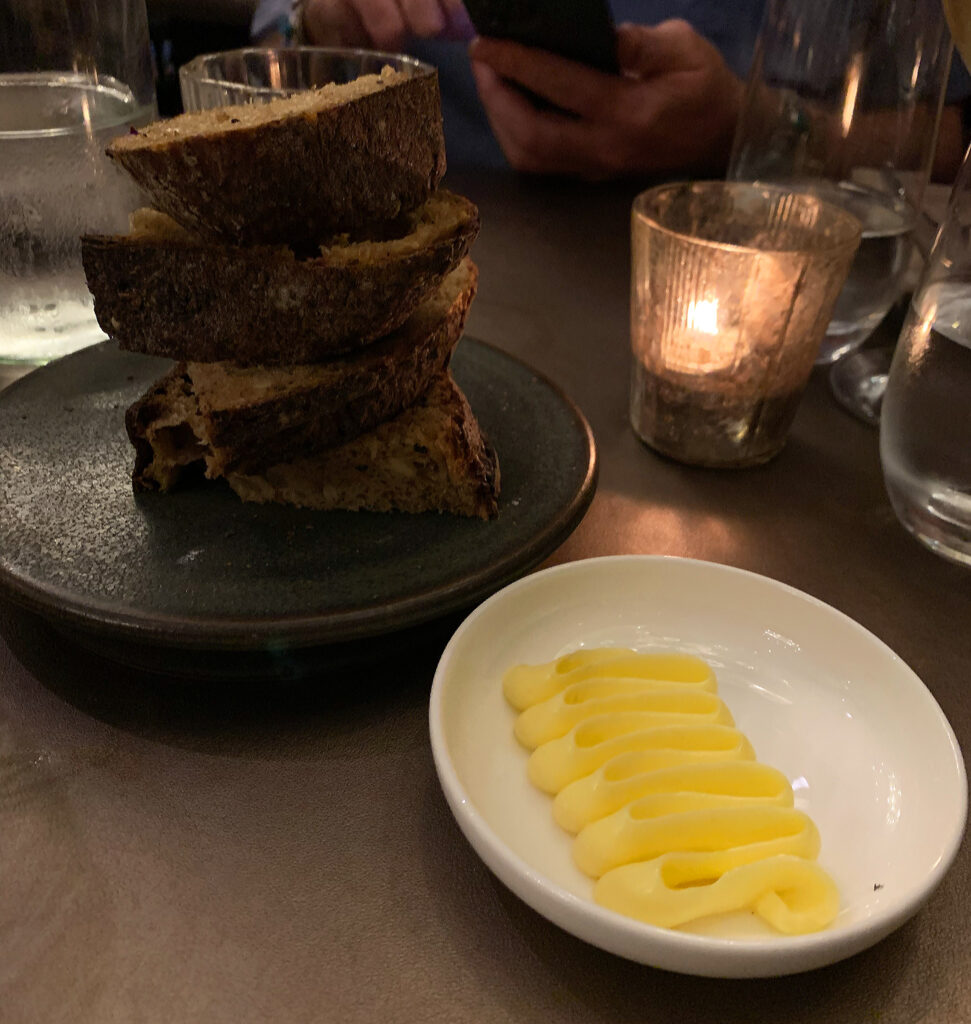
One illustrative example has to do with the restaurant’s bread service, one you will analyze in more detail later on. Suffice it to say, your party enjoyed this offering during your first visit and requested a second helping, which was happily indulged (something you cannot take for granted these days). On the occasion of your second visit, the bussers were ready to ask you if you wanted a second and then a third serving of bread (both gratefully accepted). Finally, on your last visit, second and third helpings arrived at the table without any prompting necessary. Surely, this is a small touch, but one that reminds you of the three-Michelin-star restaurants of yore that produced overflowing bread baskets and were never shy about providing as many pieces, as many times, as desired. This gesture not only speaks to a kitchen that produces an excess for the sake of spoiling guests, but of a front-of-house team that learns its customers’ preferences and anticipates them all together.
Other moments—like the lightning speed with which your espresso was made or the prompt phone call you received when walking out of the restaurant without your wine tote—shine in your memory as testaments to a restaurant that is totally plugged in, totally aware and dedicated to the craft of hospitality. In all fairness, the staff failed to notice the left-handed guests at your table, but it’s hard to get stuck on such a trifle when they bend over backwards to satisfy every other desire.
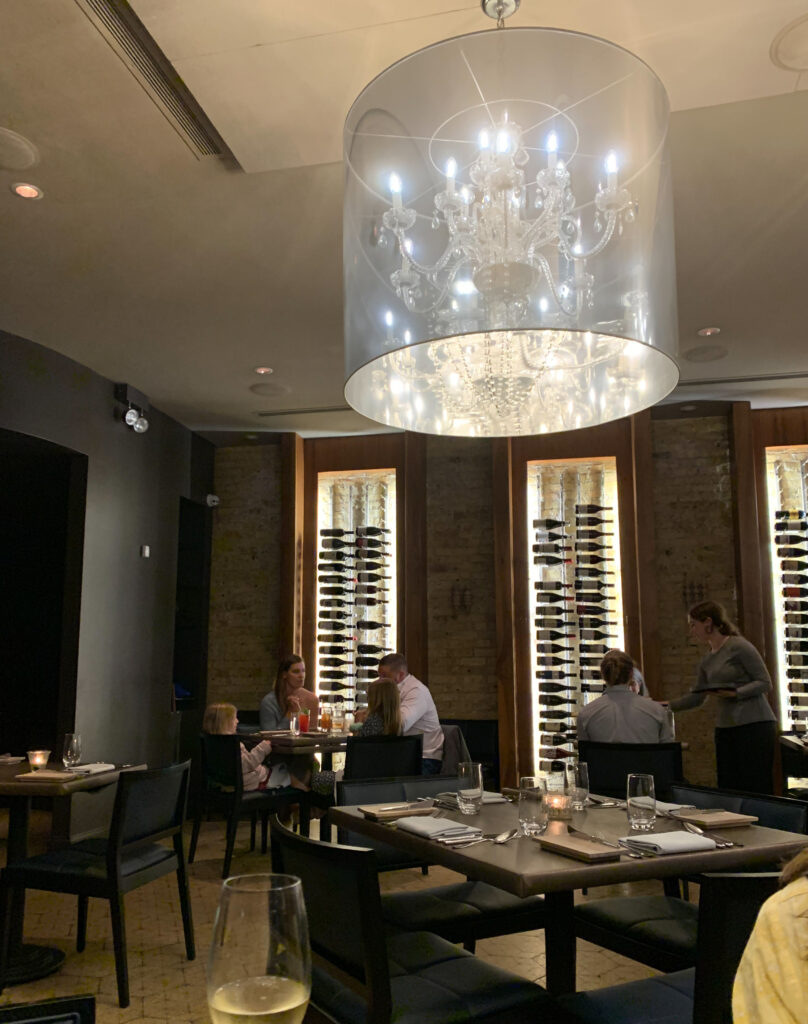
With this kind of front-of-house team to rely on, it is unsurprising—as you sit and scan the dining room—to note a guest demographic that is primarily middle-aged (and, moreover, white). Some of this surely has to do with that approachable “contemporary American” label, but you suspect Sepia’s longstanding reputation as a business lunch destination and the relationships formed with the staff (whether at lunch or dinner) over the years play a big part.
Likewise, while you might not have discerned this personally, the restaurant can claim a “decent size gay following” drawn not only to its “style and sophistication,” but to Nony’s hiring of “personalities that really resonate with [an] LGBTQ audience” and “who have the ability to connect with a wide variety of people.” This aspect of hospitality, in which “patrons are truly treated more like friends,” rings true to your experience and shines even more beautifully when it extends to everyone, of any identity, that walks through those doors.
To that point, you have also noted young families eating at Sepia with children as young as seven or eight years old in tow (well-behaved and quite polite in their interaction with the captain based on your observations). There are also, certainly, some older patrons in the fray along with the occasional single diner (comfortably ensconced in a prime banquette). Conspicuously absent (though you did spy one lone set) are those younger Michelin star chasers: bedecked in designer labels and glued to their phones. The restaurant, as you have already discussed, does not offer any easily discernible thrill for this kind of consumer beyond being a value choice. Likewise, you think a lack of broader racial diversity ties into the same idea: there are more exciting genres and environments to consider for a splurge meal relative to Sepia’s familiarity and restraint.
Of course, that notion of “excitement” is completely relative, for some might not care at all for a trendy scene or fashionable culinary theme so long as fireworks are delivered on the plate. Still, the kind of scantily clad woman that Phil Vettel creepily ogled in his review has, many years later, moved on to other venues. The result is that Sepia, these days, preselects for a slightly more austere crowd. That means the din of the dining room is fairly subdued (you can make out the restaurant’s jazz soundtrack playing over the speakers), and conversation with your guests is easily conducted. When you, again, consider how well the front of house facilitates the experience, this may be exactly what certain consumers are after from what already feels like a “neighborhood place.”
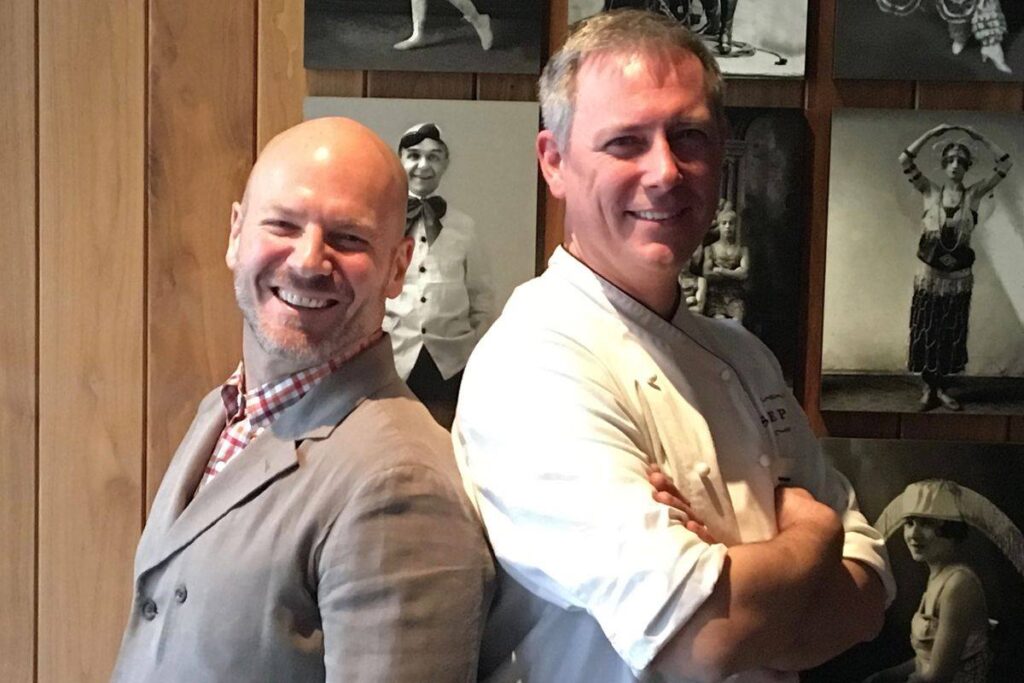
Lastly, it is worth addressing the idea of “chef presence” as it relates to Sepia. Frankly, you did not see Zimmerman or anyone from the kitchen come into the dining room across your visits (though the executive chef’s recounting of how he’s often confused for Andrew Zimmern when asked to come to the table suggests he’s amenable to making an appearance). This lack of any presence seems like a practical consideration given the relative seclusion of the kitchen and the streamlined nature of the menu. (Proxi, by contrast, features an open kitchen, and you have indeed seen Zimmerman in the flesh over there.)
Still, considering how harshly you have judged other restaurants when it comes to this aspect of the experience, you should not simply let Sepia off the hook. At North Pond, César Murillo made a fleeting but warm and well-received appearance at your table despite the concept also not really seeming to facilitate this kind of gesture. At Boka, Lee Wolen’s interactions with your party were more pronounced (welcoming you at the host stand, presenting a preparation of duck) but ultimately felt contrived and awkward. While the former example felt like a pleasant surprise, the latter revealed that it may sometimes be better to make no impression than to stumble through the motions and come off as insincere.
Ultimately, it all comes down to expectations: to what degree is a given restaurant trading on the chef’s reputation, and how much are customers paying for cuisine they believe comes from the hands of a master craftsman. North Pond, you think, sells itself based on that singular natural setting, a celebratory feeling, and a sense of value—“chef presence” is a bonus. Boka, instead, is the crown jewel of a restaurant group that increasing invokes its Michelin-starred chef’s status to hawk soulless Italian food and rotisserie chicken. Its wine list is priced in a predatory fashion, and the tasting menu ($175) ranks among the most expensive in its category. Whether or not other diners find Wolen’s cuisine as boring as you do, it seems fair to expect some degree of engagement. Mind you, Boka’s front-of-house team is excellent, but a successful interaction with the chef has real power to make underwhelming food at least feel emotionally enriching.
16 years on, Sepia is undeniably synonymous with Zimmerman. However, he’s the kind man that avoids the limelight. He’s a mentor that has made sure his chefs de cuisine receive ample credit for their work, and he and Nony have been careful not to overextend or cheapen their brand. Their restaurant, though understated at an aesthetic level, boasts superlative hospitality and offers top value when it comes to both wine and food. Just how good the cuisine actually is works to modulate this equation, but you think Sepia does a good job of managing expectations. Thus, as at North Pond, “chef presence” becomes something more of a bonus rather than a decisive factor in overcoming fundamental weaknesses. Yes, a good “neighborhood place” may often involve interacting with a friendly toque or proprietor, but it may also shine in the manner that these figures fully recede into the background and allow the guests to take center stage. There’s a certain level of gamesmanship involved in getting the chef’s attention after all, one whose associated jealousies do not, in fact, always make for a good environment.
With your beverage order settled, you now turn toward the food. As previously mentioned, Sepia has ditched the à la carte and, later, tasting menu formats it once offered in the wake of the pandemic. Instead, the restaurant presents guests with a four-course prix fixe selection (priced at $95) with four options in each category and the option to add up to two additional courses (with the entire table’s participation). A $59 wine pairing, which you have neglected to sample (but would put faith in given Ring’s talent and its accessible price), is offered as a turnkey accompaniment.
Expectedly, the captain explains how this format works with patience and enthusiasm. Two or three dishes in each category are given rousing recommendations with plenty of added detail, but you do not get the sense that there are any wrong choices. Even better, when you broach the subject of adding additional items à la carte, the request is graciously received and heartily encouraged.
Now, at last, the menus are taken away, and the meal begins.
To start things off, Zimmerman serves a rather simple amuse-bouche that tips its hat toward Sepia’s longstanding Italian influence. The “Brioche” comprises a thick crust of the titular bread that has been lightly toasted, liberally dressed with balsamic vinegar, coated with a layer of olive oil jam, and draped with a slice of prosciutto.
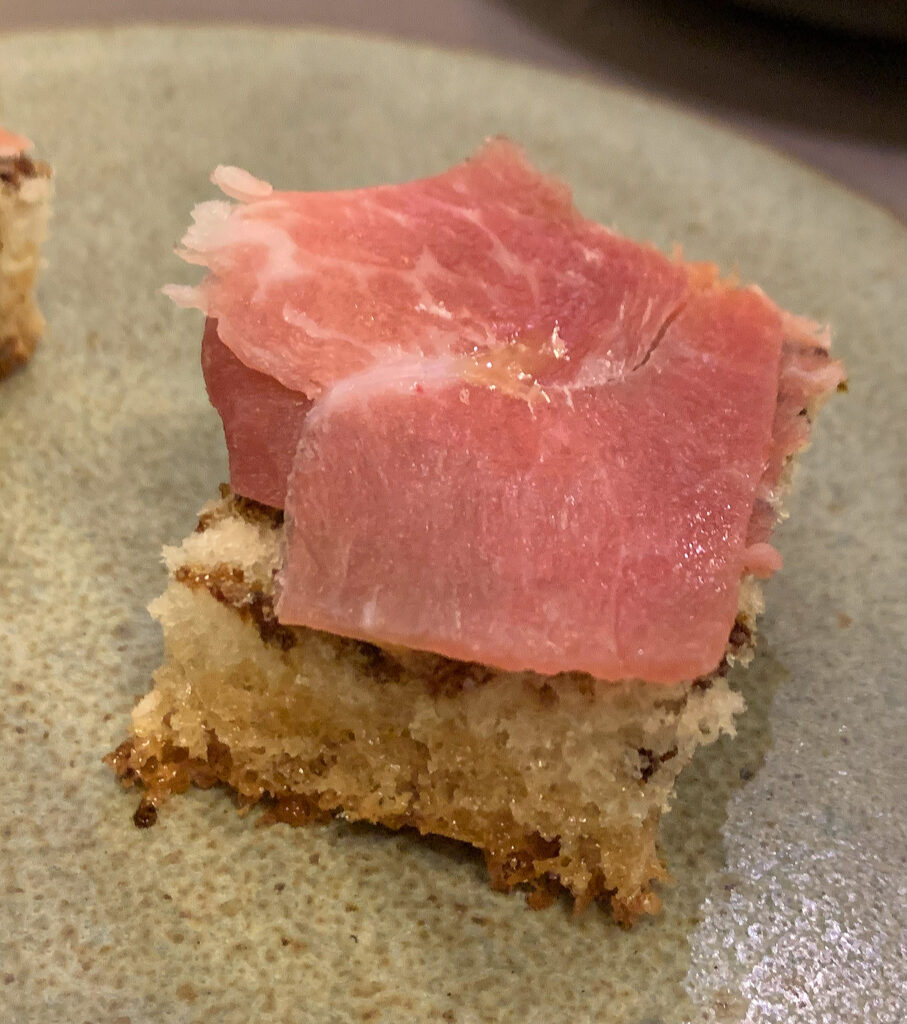
Approaching the bite, you appreciate that the cured meat has had some of its fattier segments removed (ones that often make for an unpleasant, stringy texture). When it hits your palate, the toasted brioche crunches cleanly before yielding to a lightly moistened crumb, a gooey trace of the jam, and the melting, only faintly chewy prosciutto. In terms of flavor, the bite is buttery, tangy, richly fruity, and crowned by a burst of salty pork. When this all comes together, the final sensation is beautifully balanced between sweet and savory. As classic as this amuse-bouche is, it is also so precisely executed. It not only ranks as one of the best opening morsels at this level, but puts all sorts of crostini Italian restaurants charge good money for to shame. A great start.
Around this time, either preceding the first course or arriving right around the time of its arrival, Sepia serves its bread course. Yes, bread on top of bread might seem a bit overwhelming (you can always keep it off to the side in anticipation of the right moment), but, when fine wine is flowing, who can resist?
The presentation is made up of thick slices of Publican Quality Bread seeded rye, piping hot throughout the crumb with a shatter-crisp crust. They are joined by a small serving of spreadably tempered cultured butter rendered in a ribbon pattern. There’s certainly nothing revolutionary going on here, but this combination aims purely at pleasure and achieves it: crunchy, fluffy bread dripping with melted milkfat and resonating with deeply nutty, earthy, and tangy flavors. Sepia’s seeded rye easily surpasses what is served at Boka or North Pond (though they deserve some credit for baking their own buns) and really makes it all look so simple too. In truth, a bread course need not always be about showing off but, rather, satisfying some eternal, visceral desire by nailing the fundamentals. Sepia accomplishes that, and you might draw a comparison to the “Oat Porridge Sourdough and Cultured Koji Butter” served at Elske, another superlative entry in this category that also, ironically, comes sourced from PQB.
It should be mentioned that, on one occasion, your second helping of bread displayed a strangely sticky almost plasticky texture to its crust that felt unpleasant as it shattered against your teeth. However, across every other instance (that is, very many servings), this offering has been unerringly enjoyable. So, you will chalk it up to a one-off issue with reheating or perhaps even at the level of production (with PQB itself).
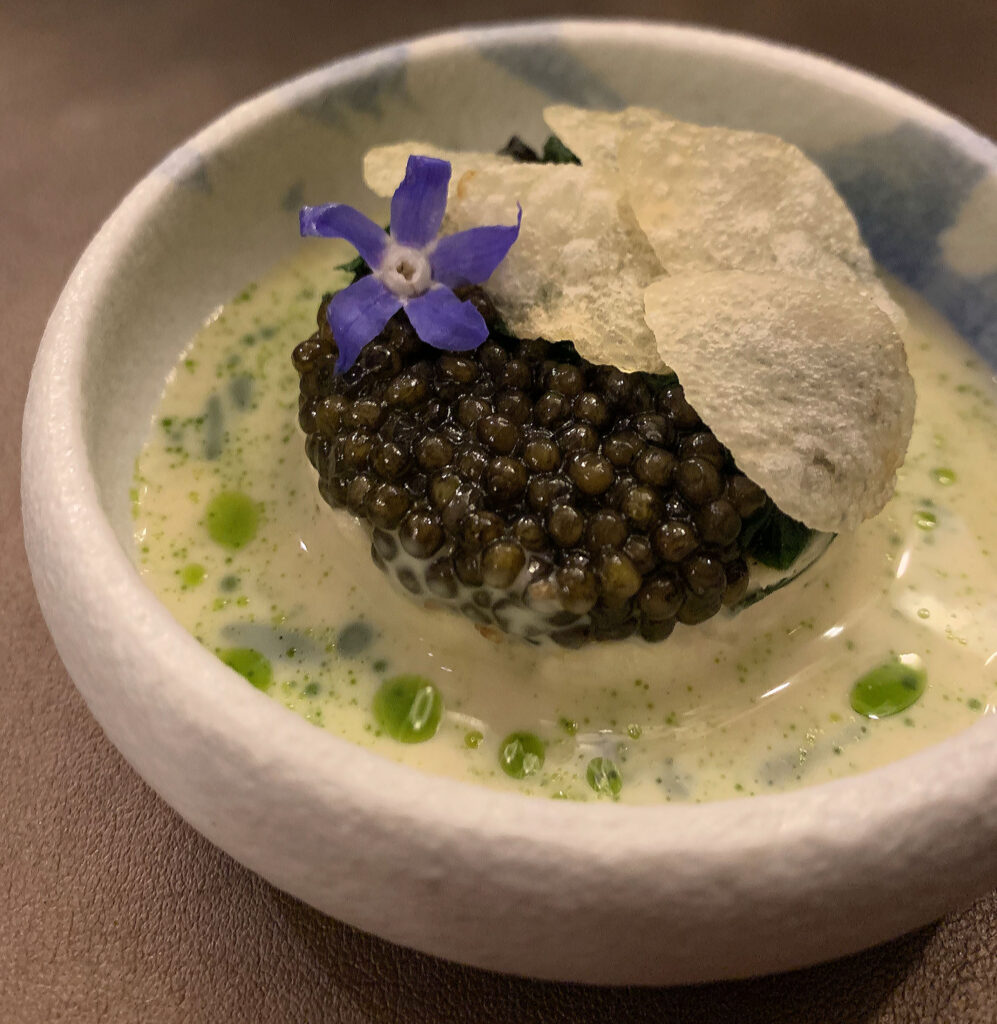
Next, also preceding the first course (should you choose to order it), arrives the supplemental dish of “Golden Kaluga Caviar” ($25). The preparation, which arrives is a neat ceramic bowl, comprises a base of smoked halibut that has been processed into what resembles a dip. It is then laced with grilled spinach and topped with an eye-catching layer of the titular roe. The final touch comes by way of some potato chips—nestled against each other like a set of scales—and a shiro dashi (white soup stock made from kelp and preserved tuna) butter dotted with dill oil that is poured tableside.
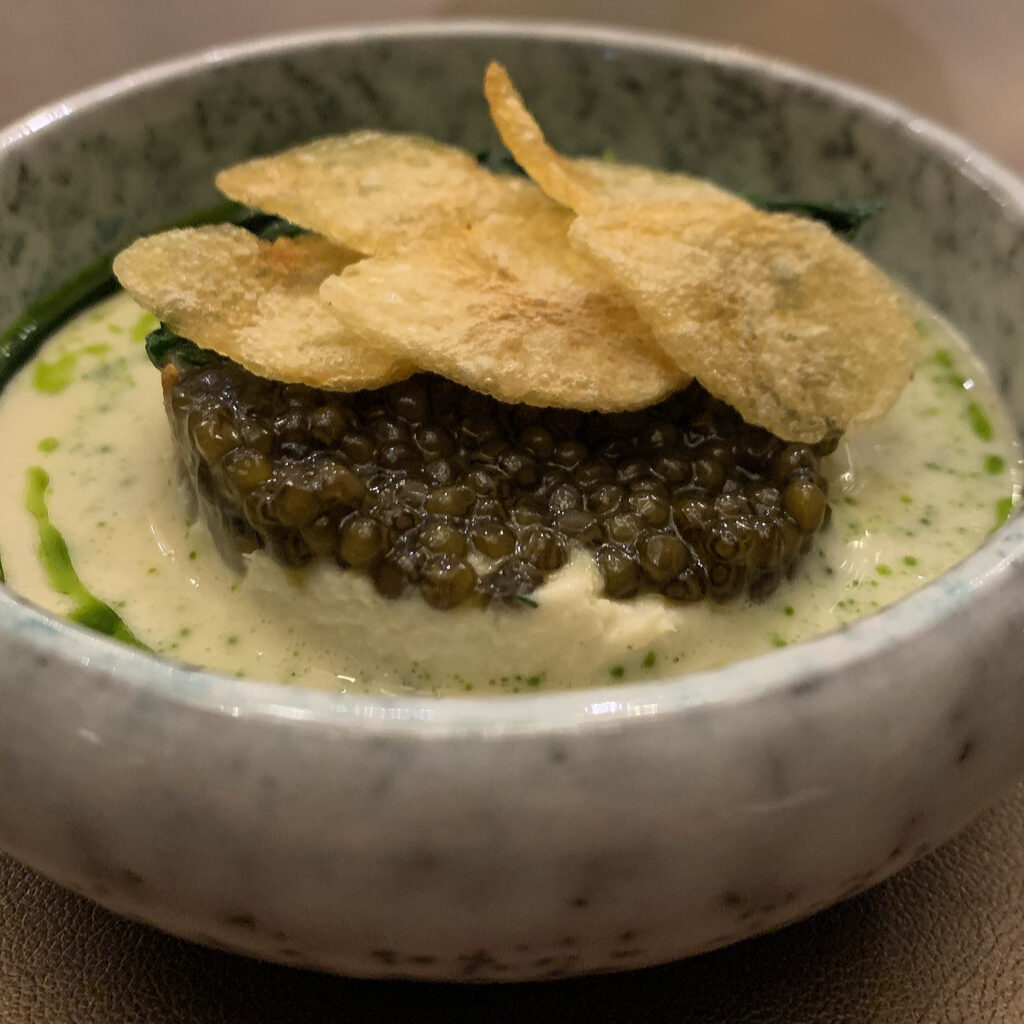
Diving in with the accompanying wooden spoon, you find the fish dip, texturally, to be pleasantly smooth. The leaves of the grilled spinach, likewise, are well moistened and melt on the tongue. Framed by an encompassing coating of butter, these elements recede into the background and allow the subtle pop of the caviar and pronounced crunch of the chips to fully assert themselves. However, when it comes to flavor, the supporting elements show their class. The combination of halibut and spinach offers an undercurrent of sweetness that is distinguished further by slightly bitter and smoky qualities. Given the intensity of umami that the shiro dashi provides, these contrasting notes are crucial. They join with the anisey dill to accentuate the golden kaluga’s inherent nuttiness and leave you with a finish that feels creamy, salty, and satisfying but still bright.
At the end of the day, this is a good—maybe even a very good—preparation that is only limited by the quality of the roe. You think that is a compliment, for the combination of halibut, spinach, and shiro dashi really does boost the star ingredient expertly. A finer caviar would provide more textural nuance and greater depth of flavor to play off of this base, but you also find the supplement’s $25 price to be commendable. It serves to democratize this kind of luxury, with the accompanying serving still feeling generous too. Subsequent versions of this supplement have even seen the smaller chips replaced by one whole, larger crisp, a clever touch that encourages guests to actually treat the presentation like a proper “dip” before utilizing their spoon.
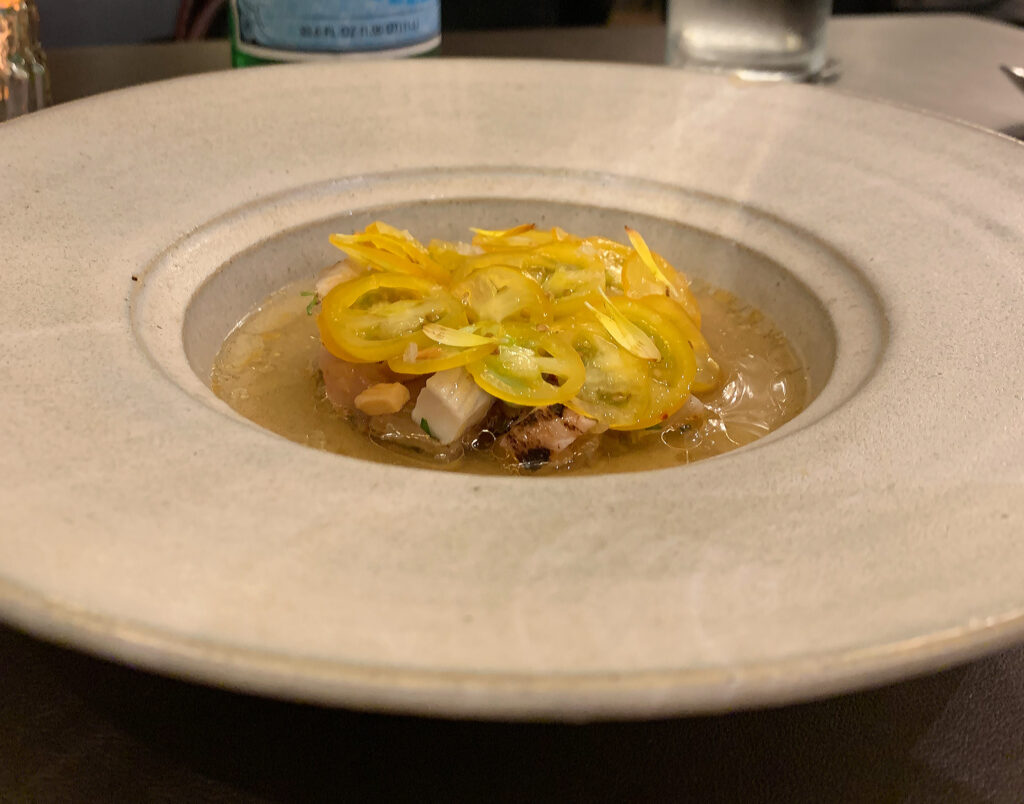
Moving, now, to the first course, you will proceed sequentially. Zimmerman’s “Hiramasa Crudo” has featured on the menu in one way or another since as far back as 2021, with the titular fish sometimes being substituted for kampachi (as is also done, ironically, at Boka). However, the terms hiramasa and kampachi each refer to different species of amberjack and, thus, represent kindred fish. More specifically, “hiramasa” refers to the yellowtail amberjack, and “kampachi” refers to the longfin yellowtail.
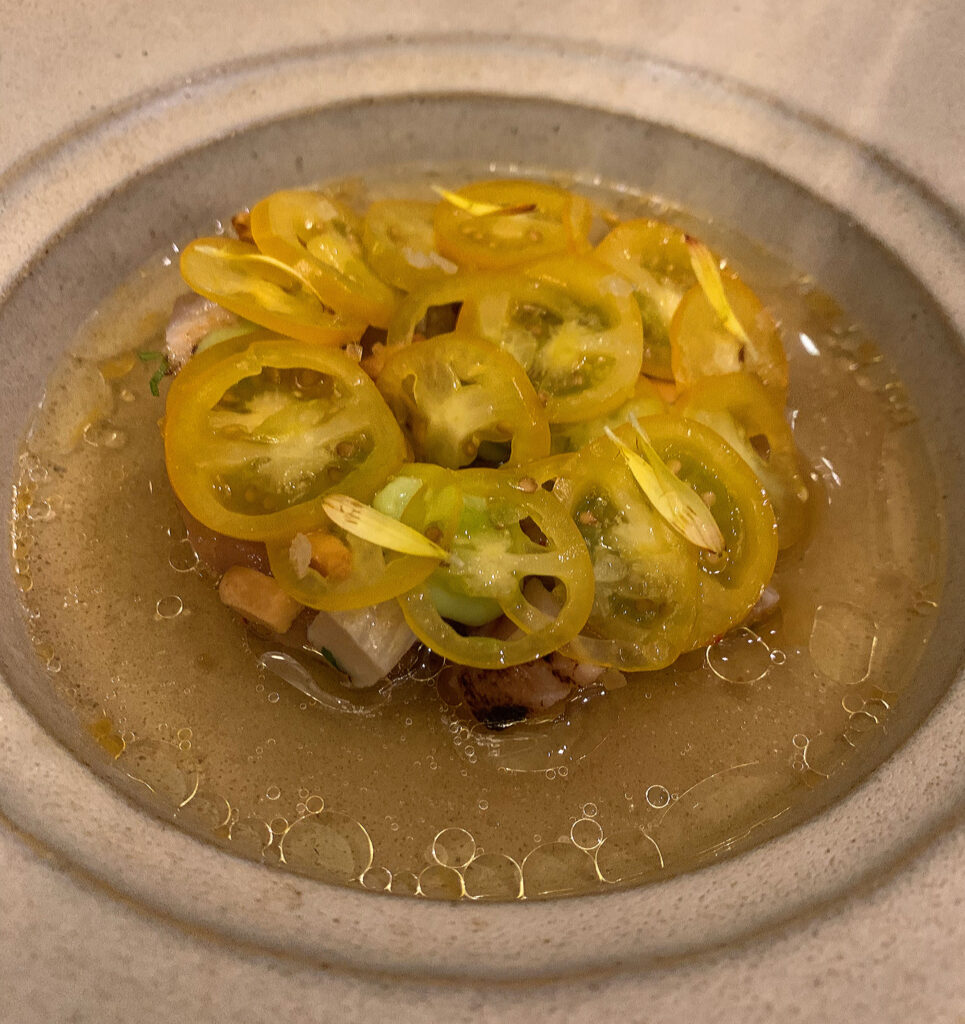
Nomenclature aside, the preparation—in its dual guises—is defined by small chunks of fish interlaced with slivers of almonds, topped with thin slices of tomato, and soaked in a tikka masala consommé. Yes, barring that Italian-accented amuse-bouche (a conceit that, nonetheless, connects to Sepia’s earliest history), this crudo offers the first suggestion of just how broadly the restaurant’s “contemporary American” cuisine looks for inspiration.
The dish, at core, is defined by the soft chew of the hiramasa, the fine crunch of the almonds, and the crisp—then gushing—quality of the tomatoes. This combination is artfully executed and feels totally cohesive. However, the preparation’s distinguishing factor is undoubtedly the flavor. With the sweet, rich fish and nutty slivers as a base, the tomatoes offer an invigorating punch of acid. Yet it is the tikka masala consommé, backed by onion, garlic, ginger, and a blend of aromatic spices, that provides a transfixing savory dimension to the crudo. It all amounts to a lip-smacking, tangy quality that amplifies the hiramasa’s latent umami and makes those small chunks feel surprisingly satisfying. This is another good item that, if anything, you would like to see done on an even bigger scale: that is, larger chunks of fish and an even more assertive expression of that consommé. Nonetheless, you appreciate how measured and approachable the use of spice is.
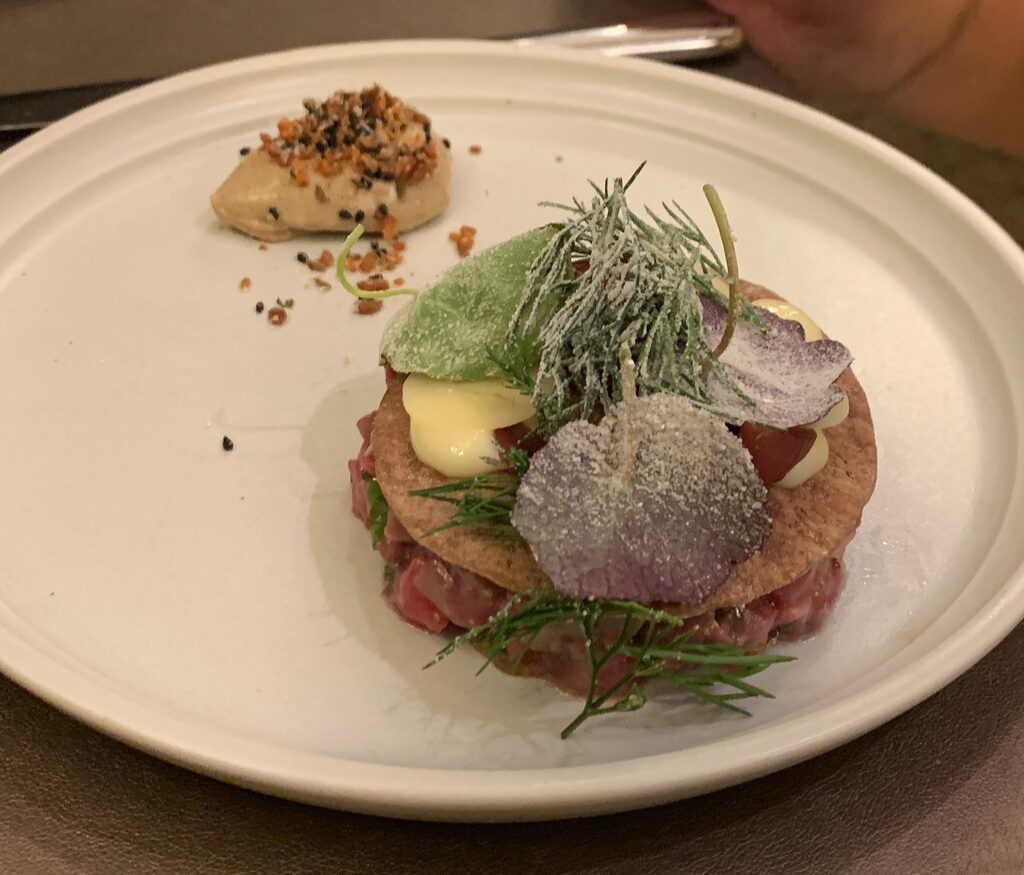
One of the other first-course options that centers on a raw (or nearly raw) ingredient is the “Steak Tartare,” a preparation that has featured in various forms over the years (going all the way back to Duque’s opening menu). The current set, rather attractively presented, comprises chunks of wagyu beef dressed in sherry vinaigrette and crowned with a caraway cracker. Atop the cracker, you find dollops of melted gruyère, some caramelized onion, and a few nasturtium leaves while, off to the side, sits a grilled sourdough cream strewn with nigella seeds.
Attacking the dish, the caraway cracker emits a satisfying crunch as you break it apart into more manageable pieces. Doing so also serves to mix the various ingredients perched across its surface in with the meat. Taking a bite, you are impressed by the wagyu’s slick, melting texture and the added creaminess provided by the gruyère (a sensation also echoed by the accompanying sourdough cream). The cracker itself offers an expected crunch, but one that is moderated by a certain thinness that prevents the topper from obscuring the tender chunks of steak. In terms of flavor, the beef’s pristine character is charged with the tang of the vinaigrette and enriched by the savory notes drawn from the cheese, caraway, and caramelized onion. The peppery nasturtium and bitter (also a bit nutty) nigella seeds offer an alleviating contrast while the grilled sourdough cream is equal parts sour and toasty.
The end result is a tartare of familiar textures (tender, creamy, crunchy) but uncommon flavor intensity. Still, the dish’s power is not drawn from excess so much as a careful layering of complementary (as well as competing) elements. This works to ensure the overriding sensation, when everything comes together, is not of dainty luxury beef but of a real, rather satisfying “steak.” Well done.
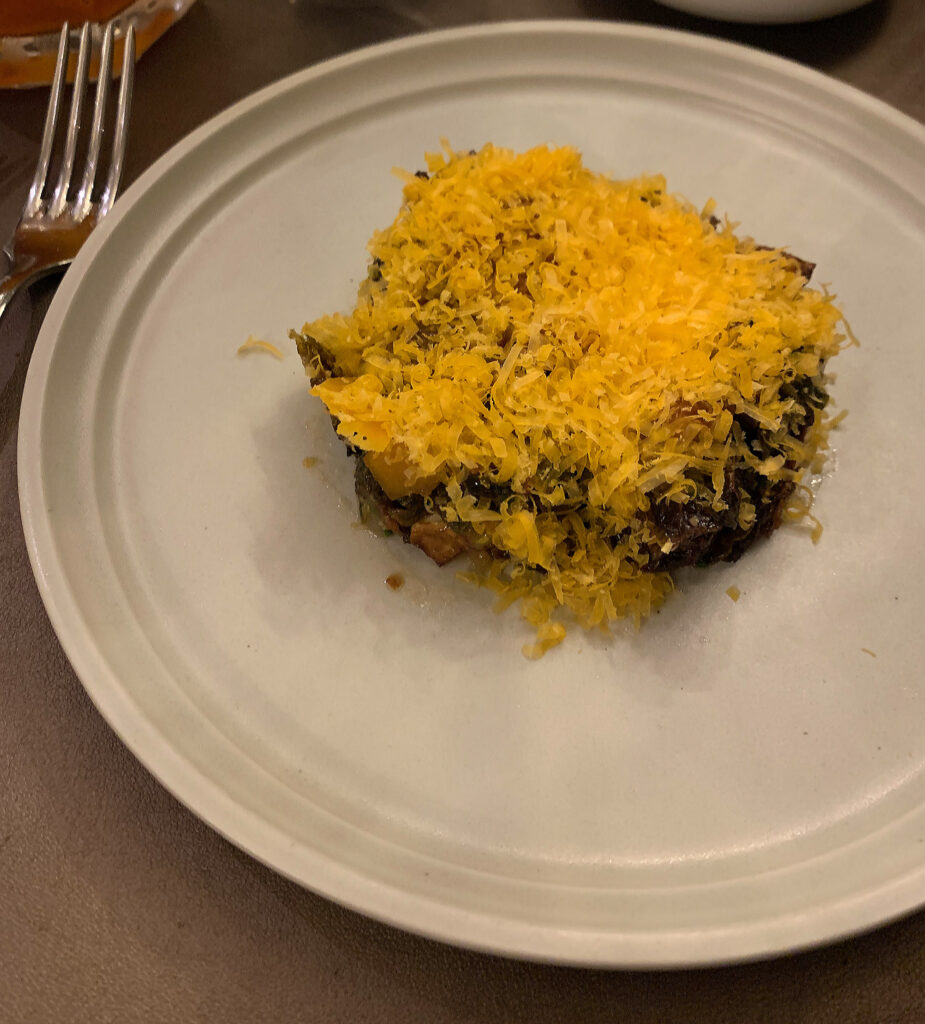
Turning toward the vegetarian end of the spectrum, you find one of the menu’s newest additions: “Crispy Brussels Sprouts.” Now, to be fair, customers who are free of any dietary restrictions may view this offering as more of side dish—something that would accompany a meal at a steakhouse (destined to be passed around the table once and then forgotten) rather than what really gets your juices flowing when spending Michelin star money. However, Zimmerman wields the ingredient with a degree of finesse that would impress even the most partisan carnivore.
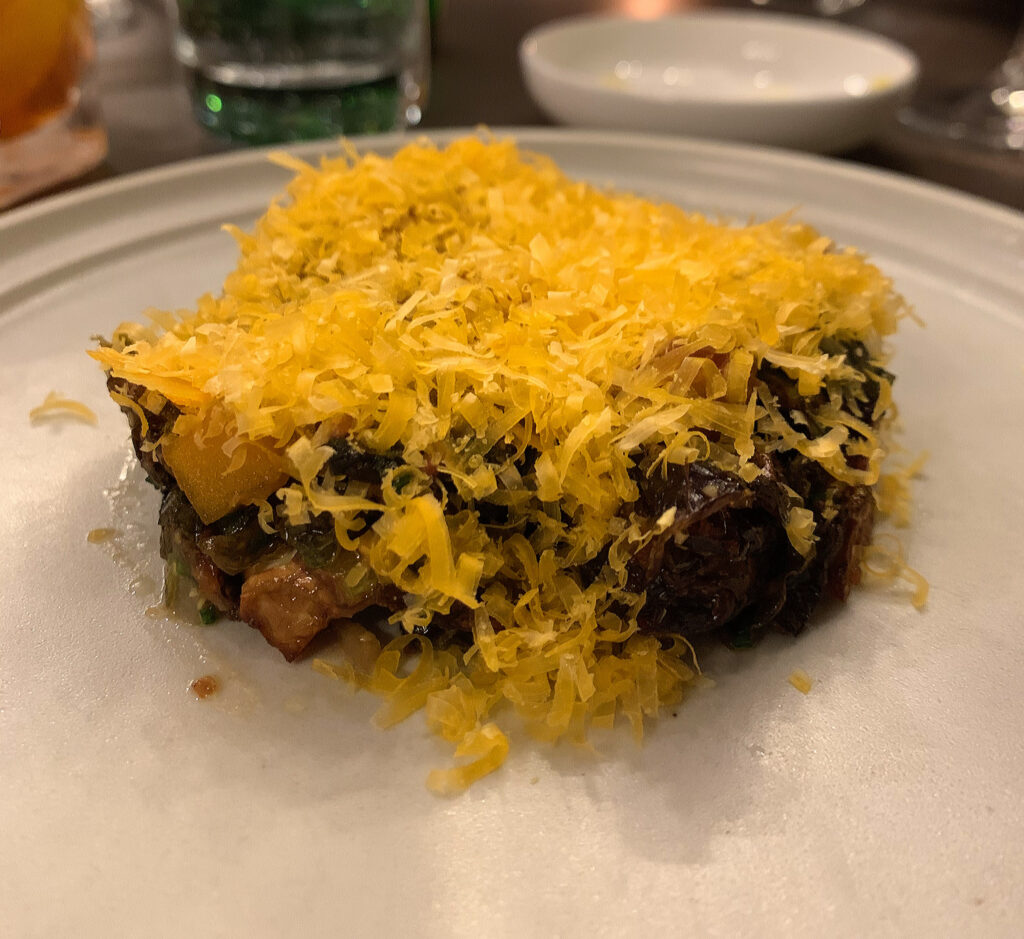
When it comes to composition, the preparation immediately catches your eye with the fluffy mound of gold-orange mimolette (a cantaloupe-shaped cow’s milk cheese first produced in 17th century France to compete with the Dutch edam) that sits at the center of the plate. Underneath it, you find the titular sprouts: leaves charred black then mixed with chunks of smoked apple and sprigs of dill.
Using your fork, you plunge beneath the cheese and retrieve a bit of everything. The sprouts, as expected, crunch and crackle pleasingly, yet their resounding crispness is nicely complemented by the soft, moist fruit and melting, mouth-coating ribbons of mimolette. In terms of flavor, the brassica’s outer char and hint of bitterness works well with the smoky quality of the apple. This synergy allows the bright sweetness of the fruit to meld seamlessly with the sprouts, which are subtly sweet and a bit nutty in their own right. As the mimolette makes its presence felt, the whole dish is capped off with a wonderful caramelly, butterscotch note that, tinged by a bit of the anisey dill, carries through a long, rich finish. Ultimately, the “Crispy Brussels Sprouts” is as much a cheese course as it is a “vegetarian option,” and, in that role, it surprisingly shines.
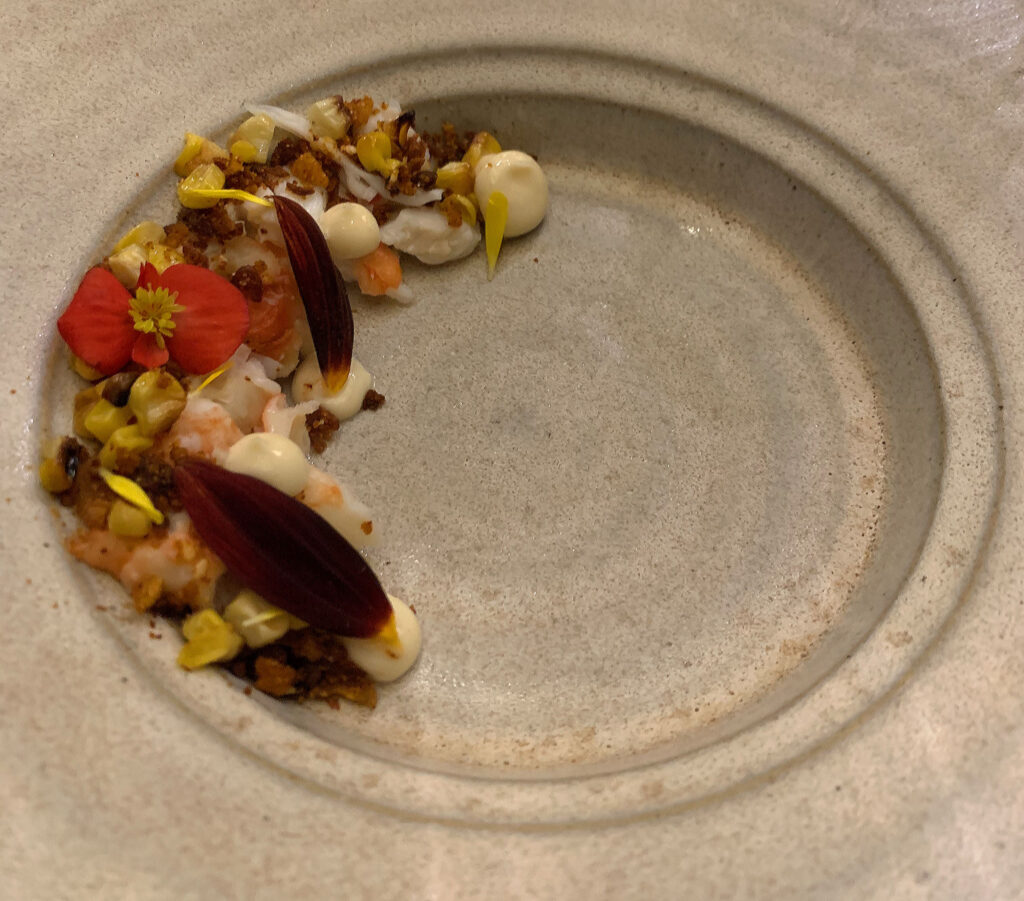
One of the more decadent first-course offerings is, undoubtedly, a “Chilled King Crab Chowder.” Alongside the supplemental “Golden Kaluga Caviar” and wagyu “Steak Tartare,” this dish also represents yet another totemic luxury ingredient Sepia is able to offer its guests despite the prix fixe’s friendly $95 price tag.
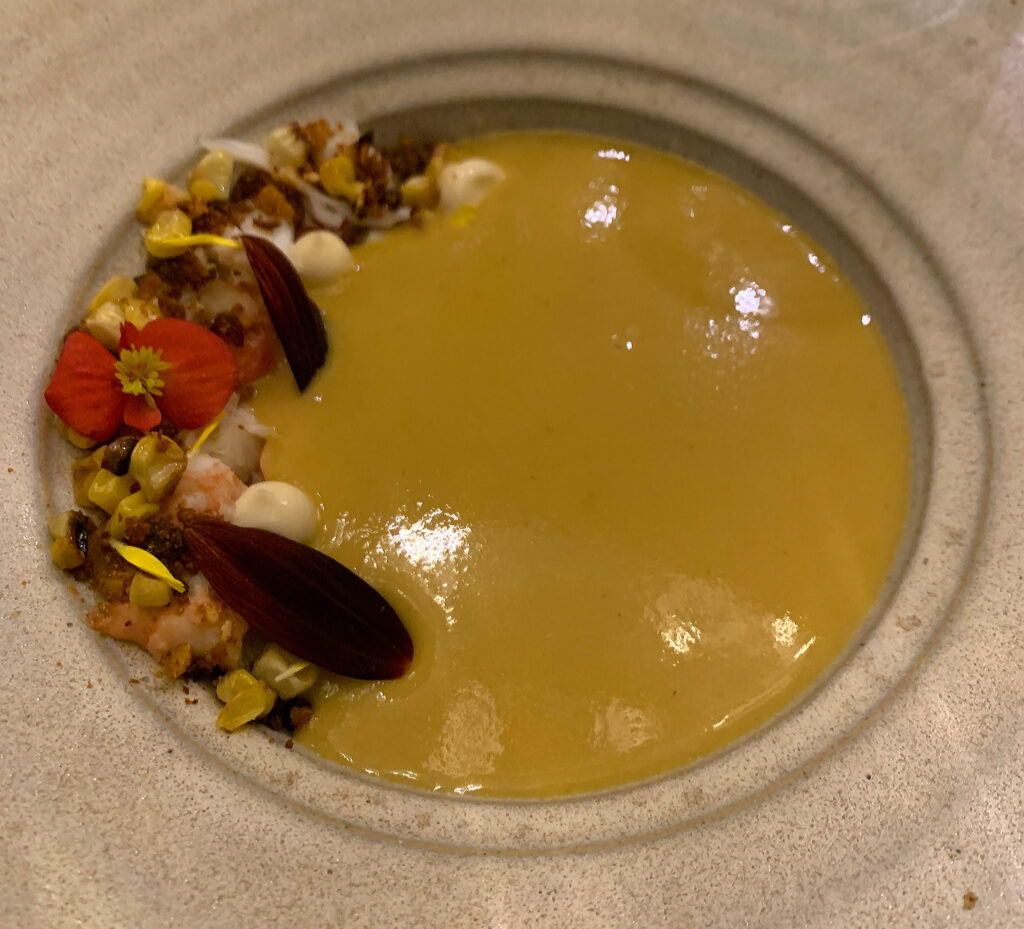
When it arrives, the presentation boasts an assemblage of ingredients, tucked in something of a crescent shape, hugging the side of a shallow bowl. There are small morsels of the titular crustacean, nibs of smoked corn, various flower petals, pearls of finger lime, and tiny grains of chili crunch. To finish, a cool, creamy broth is poured tableside. It serves to only partially submerge the various other ingredients. Moreover, it is neither white (as in a New England chowder) nor red (as in the Manhattan version) but actually takes on more of a tannish tone.
Diving in, the broth strikes you with its lusciousness and sense of weight. Against this texture, the plump chunks of crab, bursting bits of corn, popping finger lime pearls, and fine grains of chili crunch all shine. However, it is the soup’s deeply savory smoked corn quality, enhanced by the cold serving temperature, that proves decisive. This richly flavored broth allows the king crab’s latent sweetness, charged by the accompanying notes of citrus and hot pepper, to really assert itself. Still, this sweet sensation (echoed by the actual kernels of corn) is carefully managed. There is just enough to bring the soup’s base into balance, yet the finish remains unmistakably smoky and robust. In the end, this makes for an unconventional but uncommonly satisfying chowder that totally subverts what you might expect from a chilled broth. The expression of corn here is just sublime.
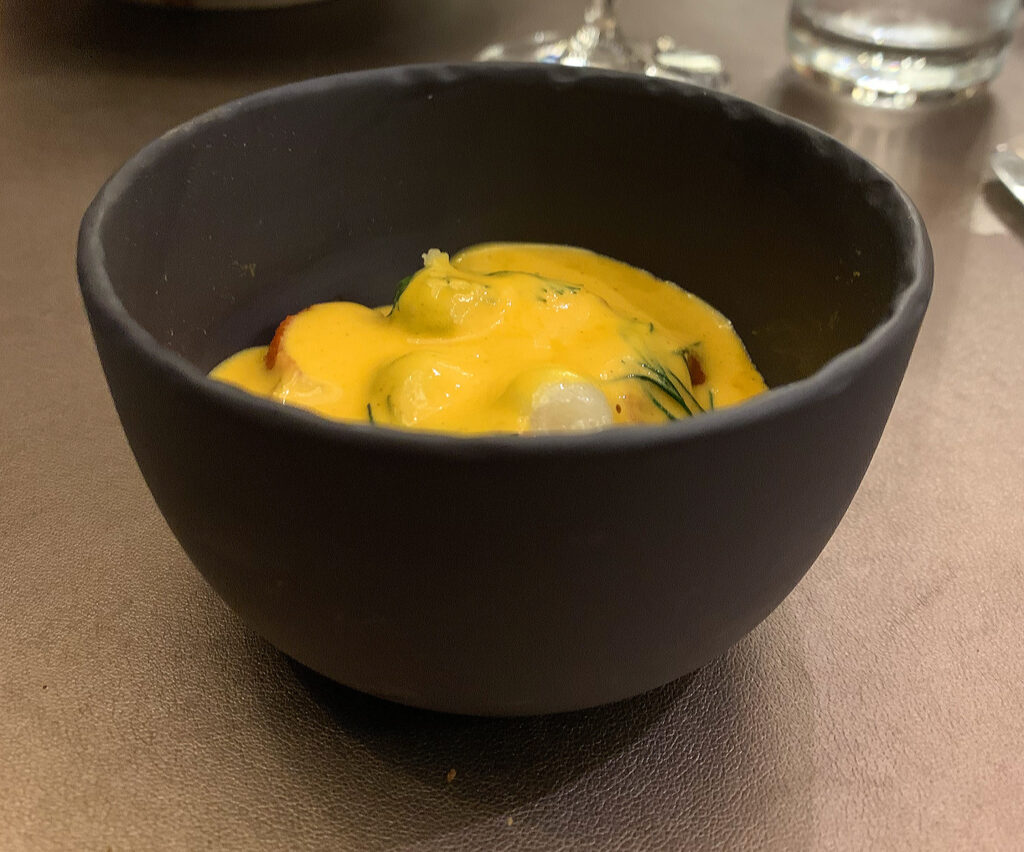
The last of the dishes you have sampled in the first course category reflects something of the same idea: that is, it centers on a totemic piece of luxury seafood that is joined by an array of contrasting textures and richly cushioned by an encompassing base. However, rather than taking the form of a soup, the “Sea Urchin Chawanmushi” draws on the Japanese egg custard Zimmerman first started experimenting with in 2016 and subsequently sought to master with the opening of Proxi.
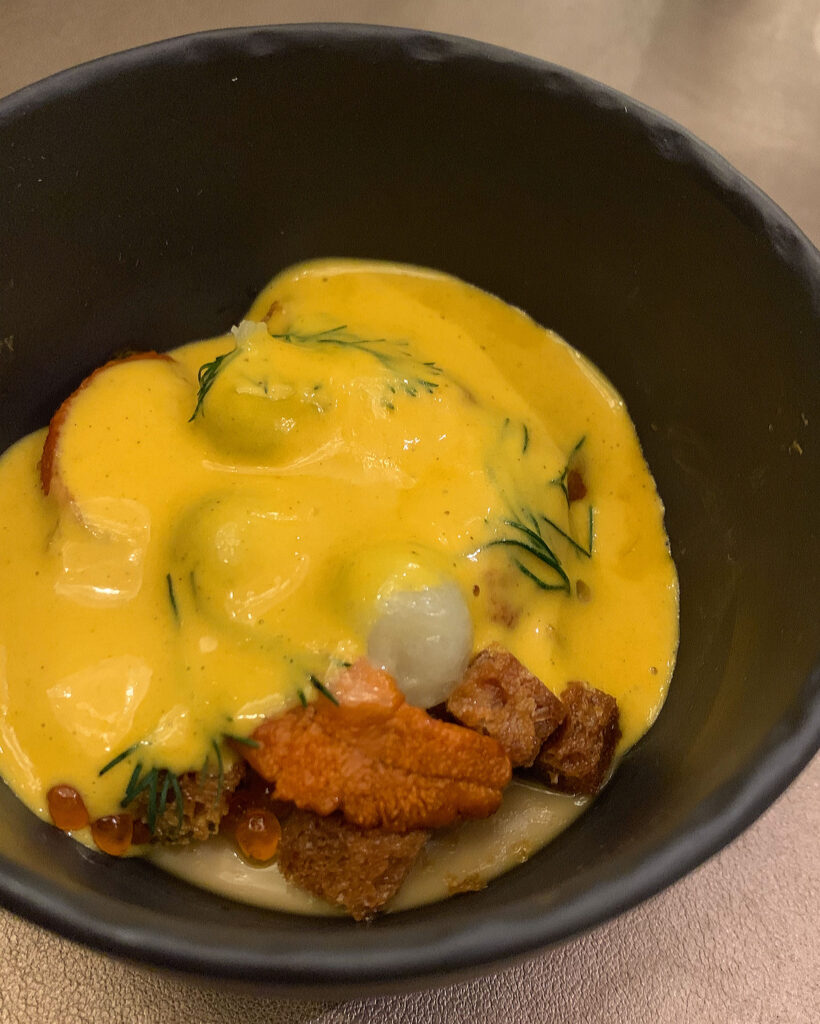
Using the chawanmushi as a base, the preparation comprises chunks of potato, some croutons, orbs of trout roe, dill, and bits of pickled pepper all layered within a small bowl. You can just barely make out a sizable lobe of the sea urchin—its deep orange color suggesting it is sourced from Maine—from beneath of a generous pour of hollandaise. Yes, at a visual level, the dish is a study in various shades of brown and orange buried under a big enlivening burst of yellow.
Diving into the bowl with your spoon, you find the egg custard itself to be a bit wet and slightly loose. To be fair, it still breaks off into cohesive chunks, yet purists expecting a firmer, more intensely steamed chawanmushi may be surprised. As you capture some of the other elements and they hit your tongue, the textures range from smooth to creamy (the potatoes), popping (the trout roe), crunching (the croutons), and mouth-coating (the hollandaise). Yes, there’s a wonderful comforting quality to the composition even if it somewhat subverts expectations. The sea urchin, likewise, does not feel assertive at first; however, it offers a soft, sweet flavor of the sea that slowly builds with each bite. Combined with the tang of the pickled peppers and the subtle umami of the egg custard, this sensation is quite nice. It all makes for an unorthodox—but engaging and surprising—take on the recipe that affirms “contemporary American” cuisine need not simply replicate, but can meaningfully deviate from the traditions it takes inspiration from.
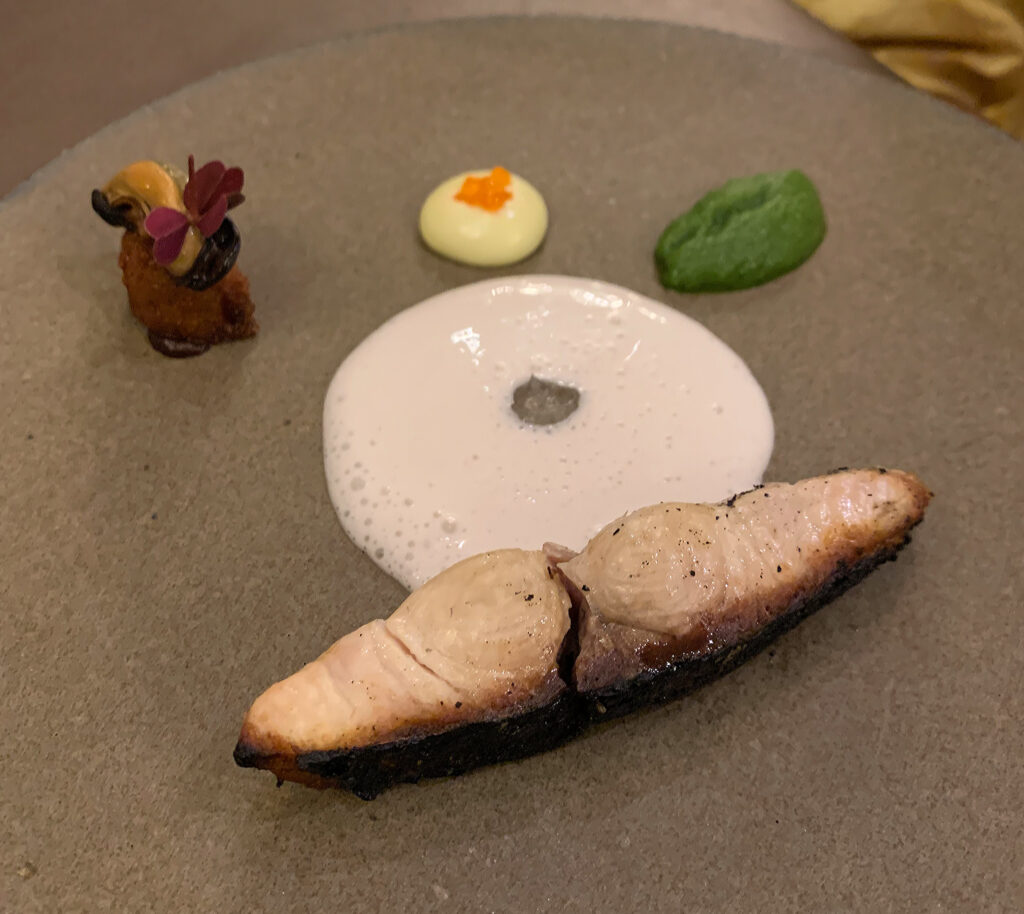
Moving, now, to the second course, you begin with yet another preparation of seafood: the “Crispy Skin Kanpachi.” Also known as the greater amberjack, this fish is a relative of the hiramasa utilized in the earlier crudo. However, owing to its position in the middle of the meal, the kanpachi arrives fully cooked with that titular charred outer later. Otherwise, the amberjack is joined by a lone mussel, rendered in an escabeche style and perched atop a fried croquette, as well as a set of sauces made from coconut and cilantro.
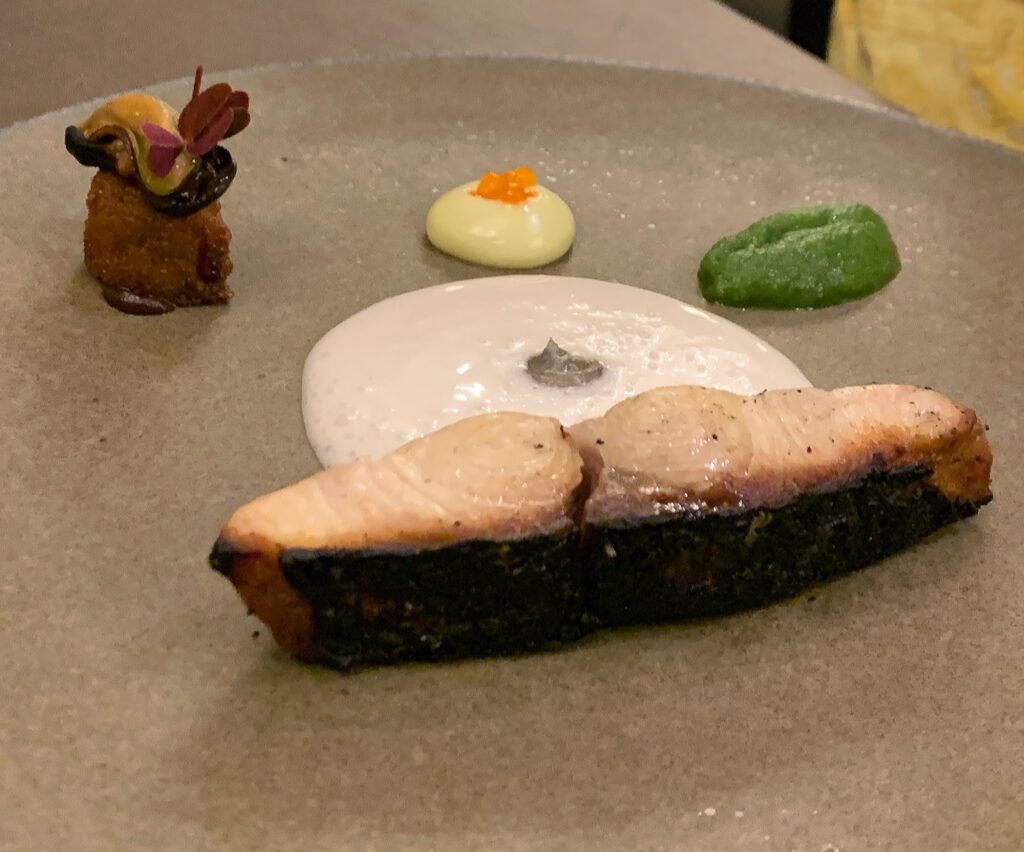
Visually, the resulting plate looks sparse, with that unadorned fillet of fish seeming so harshly Japanese and demanding nothing short of technical perfection. Nonetheless, as you take your knife to the kanpachi’s flesh, it becomes immediately apparent that Zimmerman has delivered. The crispy skin crackles pleasingly and yields to the large, gentle flake of the amberjack’s interior. On the palate, the shattering outer layer of char is matched by soft, juicy meat with a faint nutty-sweet character. When you incorporate the coconut and cilantro elements, the fish’s latent flavor is further distinguished by tropically sweet and bright, peppery tones respectively. Meanwhile, that mussel escabeche and crisp accompanying croquette provide a more pungent, warming, and moderately spicy counterpoint to the centerpiece fillet.
Overall, the quality of the “Crispy Skin Kanpachi” rests on the precision with which the fish is cooked. However, you appreciate the manner in which the dish’s Japanese minimalism comes to incorporate bold, eclectic flavors that span Spain, Latin American, and Southeast Asia. Again, Sepia does not fall into the trap of cooking in a way that is bound to tradition but, rather, uses that inspiration as a jumping off point toward crafting textures and flavors that please American palates in a singular way. You have enjoyed this dish, which seemed a bit boring on paper, much more than expected.
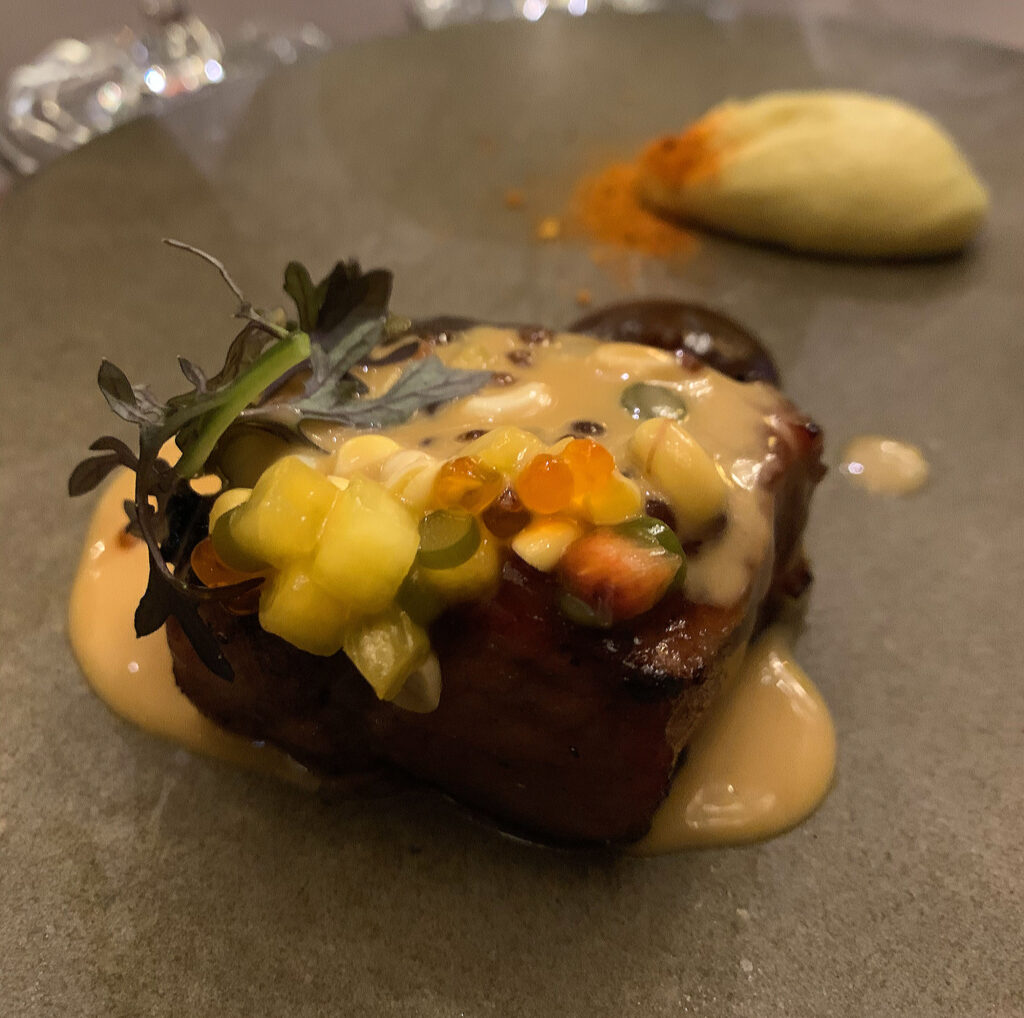
By comparison, the “Barbeque Pork Collar” promises a whole lot of pleasure for patrons of a more carnivorous bent. You may even do a double take when you see it listed among the second courses, wondering (to yourself) if you really get to savor what sounds like an additional meat entrée. In practice, the dish looks the part: comprising a sizable square of the crispy, browned collar topped with bits of corn, peach, caper, and a couple orbs of trout roe for good measure. A thick sweet corn cream sits off to the side while, as a finishing touch, a sauce made of smoked peach jam is poured tableside.
Attacking the collar with fork and knife, you are surprised that, despite looking so unctuous, it offers a bit of resistance. This is mirrored on the palate, where the pork offers an appreciable amount of chew rather than totally melting in your mouth. You do not, however, find the sensation unpleasant, for it serves to amplify the presence of the meat and enhance a feeling of satiation. Besides, the real driving force behind the preparation undoubtedly comes from the accompanying sauce: smoky-sweet peach that joins with the (surprisingly) savory corn cream and salty caper to imbue the pork with a delightful sense of decadence. Upon further reflection, you are not quite sure the collar’s texture has been totally mastered, yet you like this dish a lot and think it lives up to the hedonistic expectation set by the description. At the very least, it represents a gracious concession to those diners who feel they might leave feeling hungry or shortchanged by stereotypically meager fine dining portions.
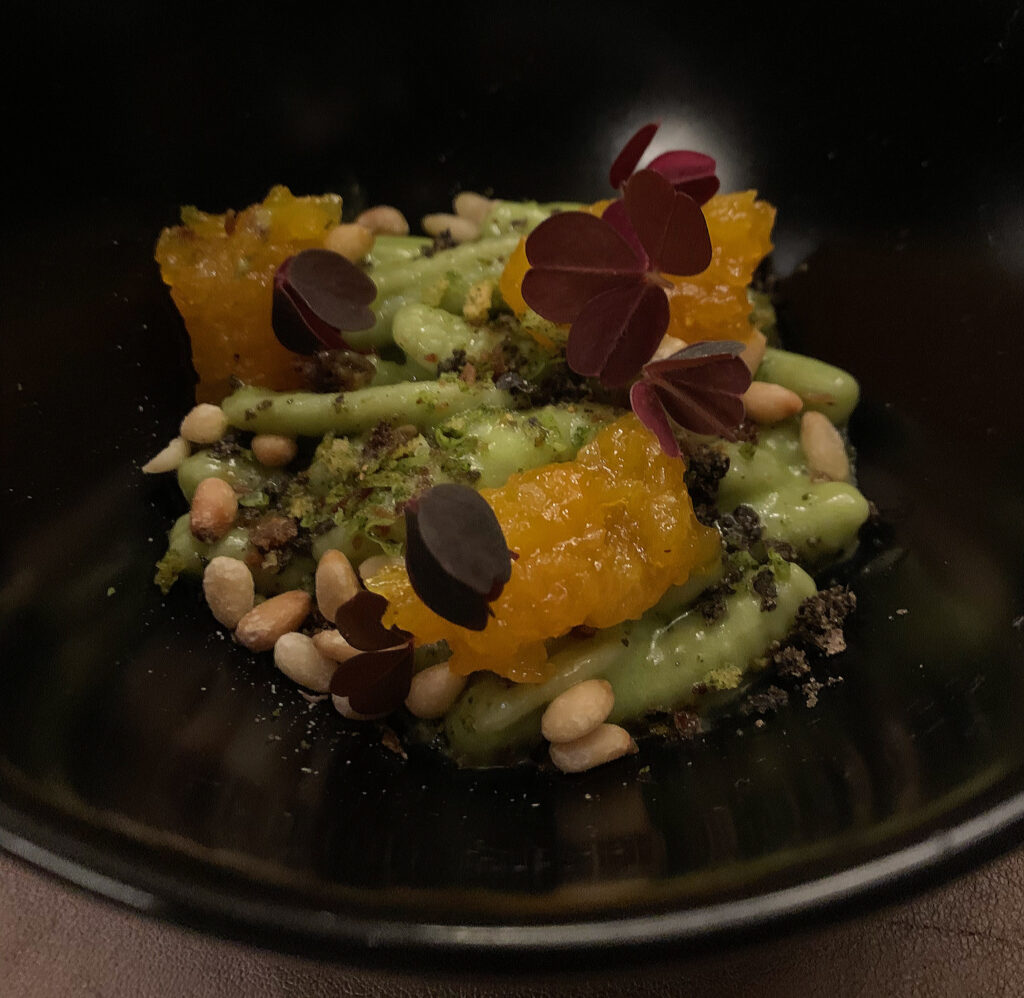
Next, with the “Sourdough Cavatelli,” you engage with one of countless pasta forms that have helped to define Sepia’s identity from the very beginning. In this case, the preparation centers on small, shell-shaped “hollows” typically made from semolina dough (but, here, enlivened with sourdough starter). Served in a sizable black bowl, the pasta is joined by lamb bacon, parmesan, pine nuts, za’atar (an herb blend accented by sesame seeds and sumac) paired with a rather curious finishing touch of apricot jam.
Diving in, the cavatelli impress you with their perfect al dente chew. Coated with nothing more than the parmesan, which has been emulsified in pasta water, the tiny shells are further distinguished by the fatty lamb bacon, soft pine nuts, and gooey jam. The resulting textural sensation feels creamy and decadent without any rough edges. This allows a delightful depth of flavor to slowly build: nicely savory, a little tangy (from the sourdough influence), and a bit nutty on entry but, with time, tart-sweet (via the apricot) leading to a long, pronouncedly spiced finish. The combination does not seem like it should work on paper, but the balance here—despite such boldness—is impeccable. Zimmerman has crafted a pasta of singular style that still, somehow, remains true to the deep satisfaction that characterizes the form. The “Sourdough Cavatelli” ranks as one of the best dishes on the menu and the sort of preparation that can go toe to toe with any pasta recipe, traditional or modern, in town. Bravo!
The last of the second course options you have sampled invokes, in the wake of the earlier caviar, crab, uni, and wagyu, yet another totemic luxury ingredient. The “Roasted Foie Gras” sounds simple enough—prized duck liver simply prepared—but actually takes a novel form. The star ingredient, rendered as small segments of the lobe, is joined by slivers of radish and honeycrisp apple at the center of a shallow bowl. The combination is dressed with a pho consommé tableside, and guests are provided with a bundle of herbs to use as a final garnish. (Though your instinct may be to tear this latter element over the bowl’s contents, a video posted on social media demonstrates that you should drag it throughout the broth—something you failed to discern at the time.)
No matter how you approach the “Roasted Foie Gras” (tearing the herbs had no negative effect for what it’s worth), this dish is a stunner. The duck liver displays a supreme degree of smoothness free of the small bits of sinew that sometimes appear even at the finest restaurants. Yes, this is the kind of texture that can make a believer out of foie gras’s fiercest critics, and the contrasting crunch of the apple and radish only help to provide it with added definition. In terms of flavor, the effortless blend of richness and sweetness drawn from the combination of liver and fruit is taken to stratospheric heights when it comes into contact with the consommé. The pho broth’s character, bolstered by the accompanying aromatic herbs, is deeply meaty and savory with an astute application of spice that makes the dish’s sweeter notes sing. The overall length and concentration here is simply immense, making for another one of the menu’s highlights and a foie gras dish that, again, ranks positively against any preparation in the city. Very well done.
You now come to the third course—the closers that are meant to anchor a meal that may (on the surface if not in actuality) seems short by Michelin-starred standards. Of these entrées, you will first contend with the vegetarian options. As it happens, that also means engaging with two more pasta preparations.
During your inaugural visit to Sepia, the vegetarian option took the form of a “Pickled Artichoke Lasagna.” Boasting more than a dozen layers (with both top and bottom beautifully crisped), the sheets of pasta are additionally stuffed with spinach and ricotta, dressed with tomato sauce, then topped with slices of gordal olive, a thicket of lettuce, and a feather-shaped cracker crisp flourish.
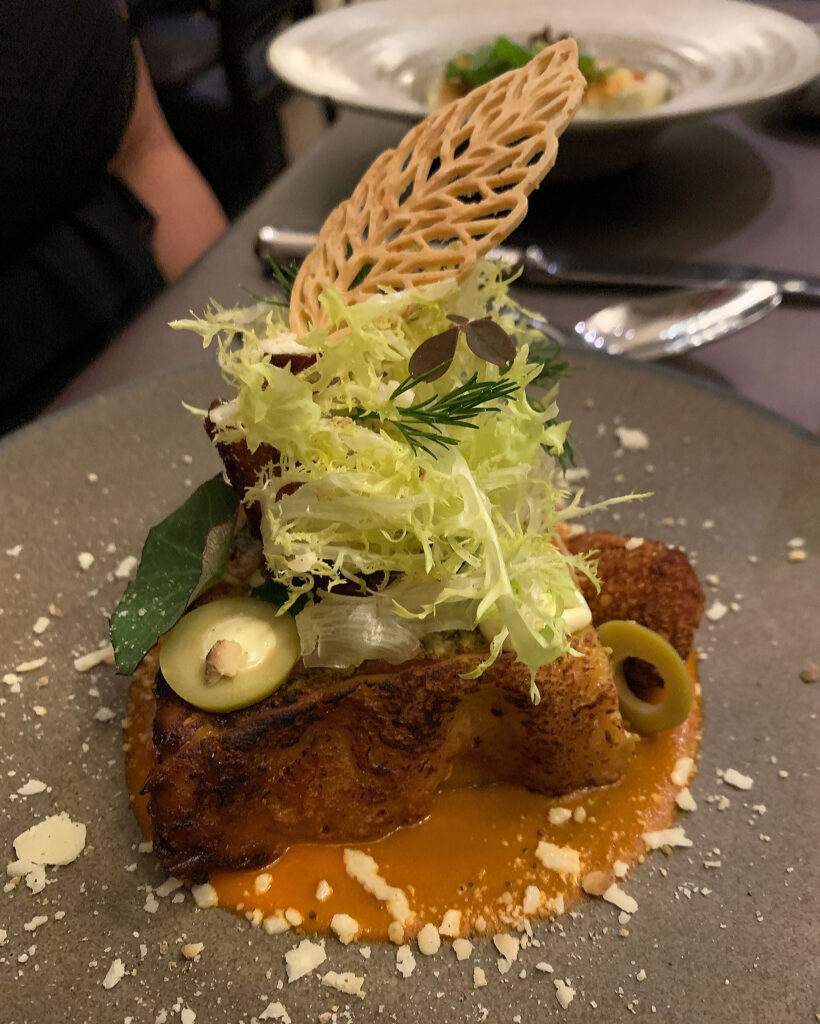
Visually, this hulking slice more than looks the part for patrons seeking to close the meal on a carb-forward note. Approaching the lasagna with fork and knife, the outer layer shatters to reveal a moist and melty interior. Upon reaching your palate, the sheets of pasta display a subtly chewy structure that blends well with the faintly crisp leaves of pickled artichoke and the smooth, creamy combination of spinach and ricotta. The crunching topper of lettuce, olives, and cracker, too, offers a bit of textural intrigue without interfering with the lasagna’s seamless layering.
When it comes to flavor, the preparation is defined by an engaging sweet and tangy quality drawn from the lasagna’s fillings and the accompanying tomato sauce. To your taste, the nutty quality of the artichokes does not come to the fore as much as you want. You also, perhaps, desire a bit more salt to help better amplify the pasta’s savory character. That being said, your enjoyment of the dish grew with each bite, and, without recourse to any meat, the recipe does impress as a pure expression of cheese and vegetables. To that point, the “Pickled Artichoke Lasagna” may have struggled to assert itself as an à la carte accompaniment to dry-aged duck. However, it represents a thoughtful offering for vegetarians by balancing vibrant flavors with a nostalgic, comforting form in such a way as to never feel heavy.
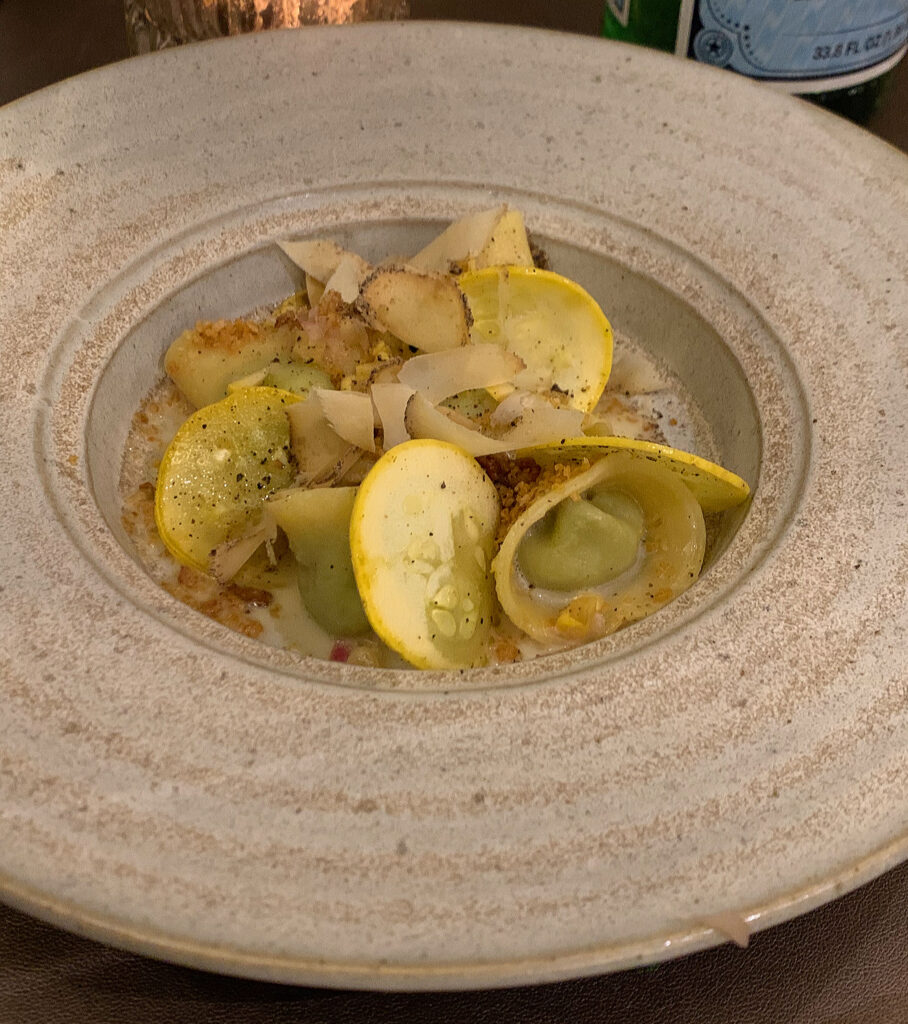
On subsequent visits, the lasagna has been replaced by a “Ricotta Cappelletti” that has quickly proven itself to be the superior vegetarian pasta. These “little hats” are stuffed with the titular cheese and come topped with thin slices of summer squash, shavings of belper knolle (a fresh lactic cheese originating from Switzerland), and a sunflower seed “conserva.” Like the earlier “Sourdough Cavatelli,” any actual saucing is relatively minor (you only note traces of what seems to be melted butter).
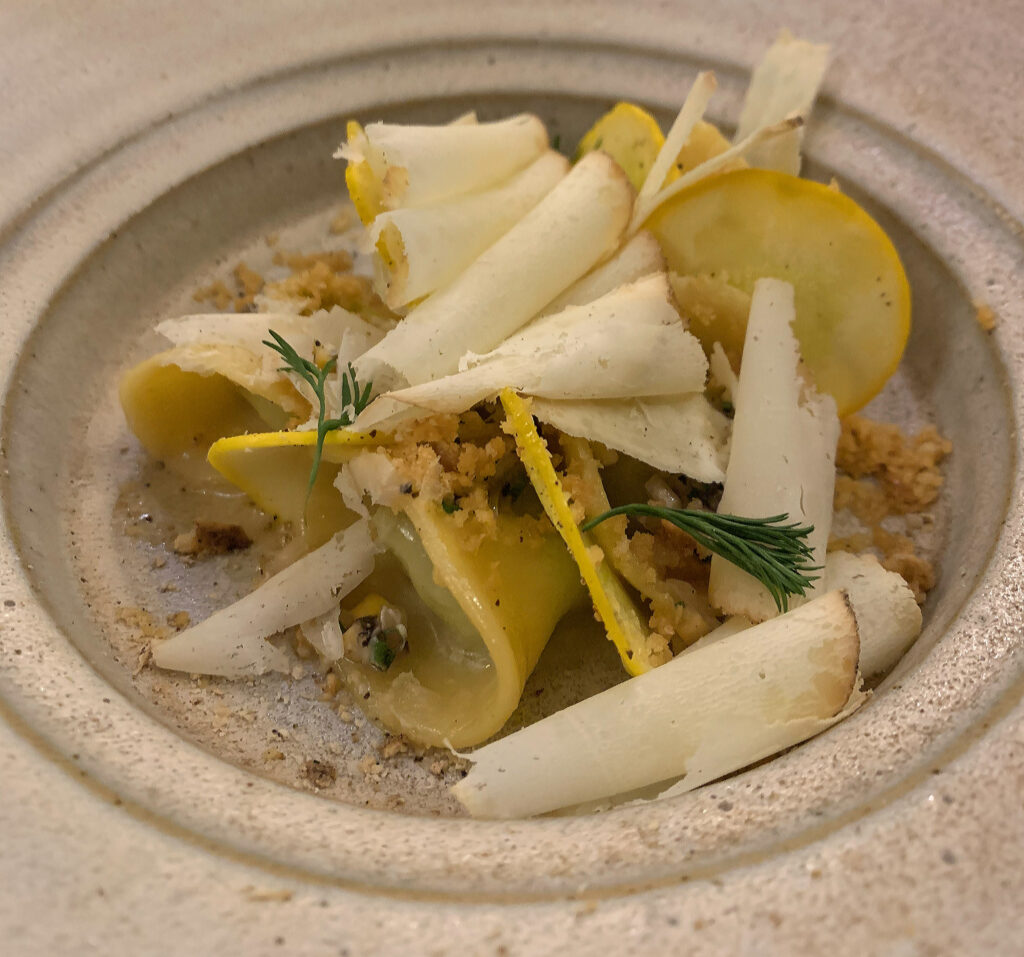
This light touch ensures that the pristine, al dente texture of the cappelletti takes center stage, with the ricotta-filled hats bouncing enticingly against your teeth before oozing cheese across your tongue. The segments of summer squash and belper knolle are rendered so thinly that, slick with butter, they become disguised by the pasta’s texture. Thus, only that sunflower seed “conserva”—fine and brittle like breadcrumbs—offers a contrasting mouthfeel. Upon this cohesive, comforting foundation, the flavors take hold: mildly sweet ricotta, peppery-garlicky belper knolle, and nutty-sweet squash combined with the even more intensely nutty sunflower seeds.
If you missed a bit of savory power from the ““Pickled Artichoke Lasagna,” then you must admit you want for nothing here. The cappelletti are charged with an array of complementary sweet, nutty, and savory tones that build and build toward a sublime (but still adeptly balanced) concentration. There’s even a slight “cacio e pepe” sensation that comes through here (and that is quite enticing). This is another great pasta from Zimmerman that is only a hair behind the “Sourdough Cavatelli” in terms of greatness.
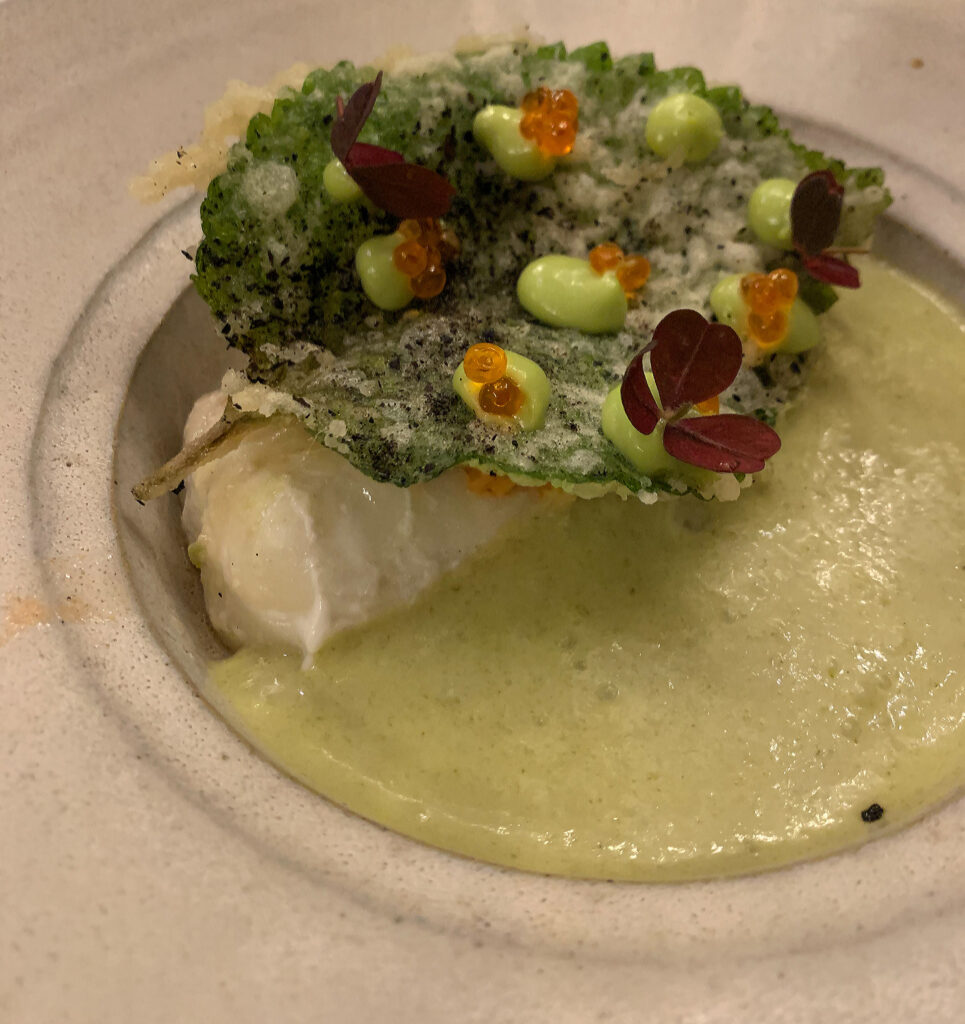
Moving on, you come to Sepia’s headlining seafood dish: the humble “Halibut.” However, rather than preparing this fish in a straightlaced grilled or sautéed style, the kitchen once more embraces a wider range of influences for its “contemporary American” fare. In this case, the halibut is poached in a rich green curry and topped with a tempura-fried perilla leaf. That latter element, almost serving to obscure the entirety of the fillet, is dotted with avocado cream and a few orbs of trout roe before being dusted with black lime. The finishing touch, situated in an accompanying bowl, is a so-called “baby naan.”
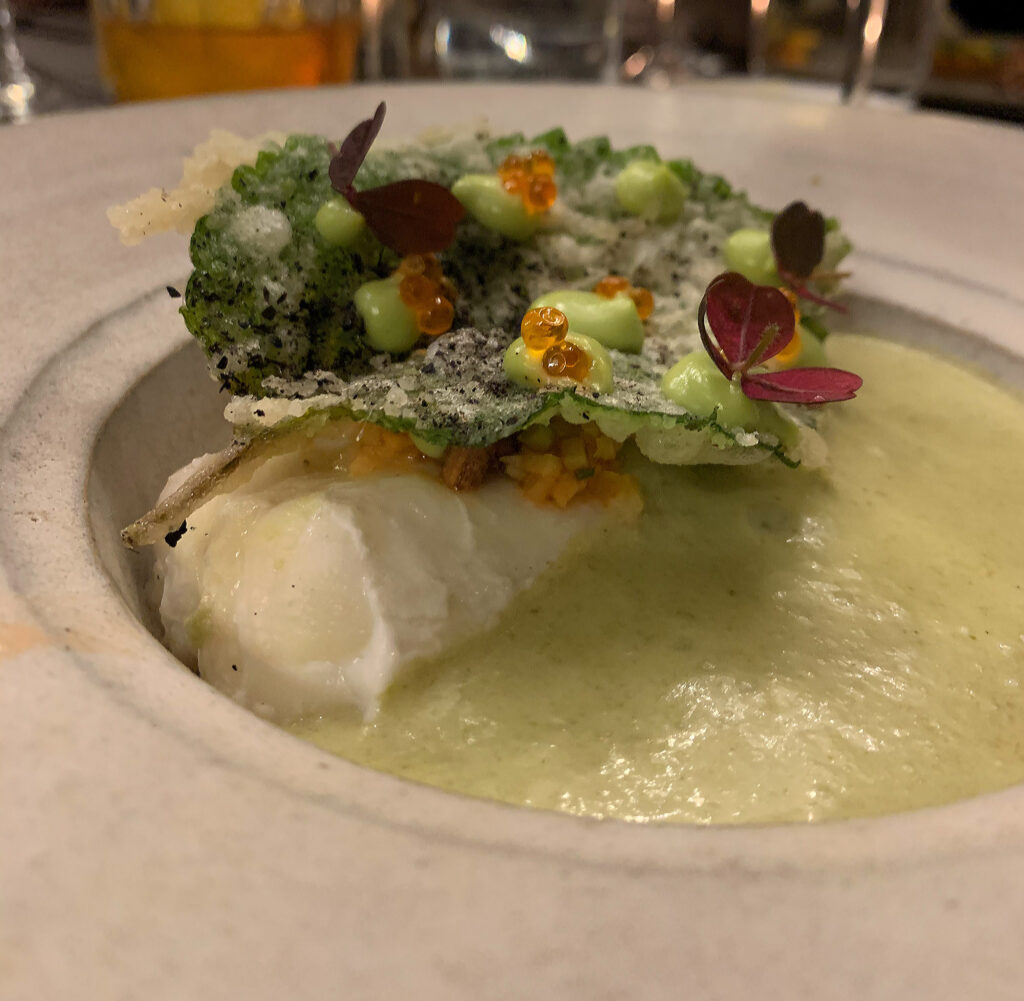
Diving in, the perilla leaf crackles pleasingly and disperses its contents throughout the dish. Upon meeting your fork, the halibut’s flesh yields and exhibits a large, slightly firm flake. However, studded by those crispy bits of tempura and surrounded by its creamy sauce, the fish feels soft and moist on your palate. In terms of flavor, the green curry imbues the mildly sweet fillet with an even deeper sweetness—drawn from lemongrass and coconut milk—that is, nonetheless, balanced by a blend of herbal notes, fish sauce, and carefully judged spice. While the dots of avocado offer a dose of nutty richness, the combination of anisey perilla and salty-sour black lime underscore the notes of the sauce.
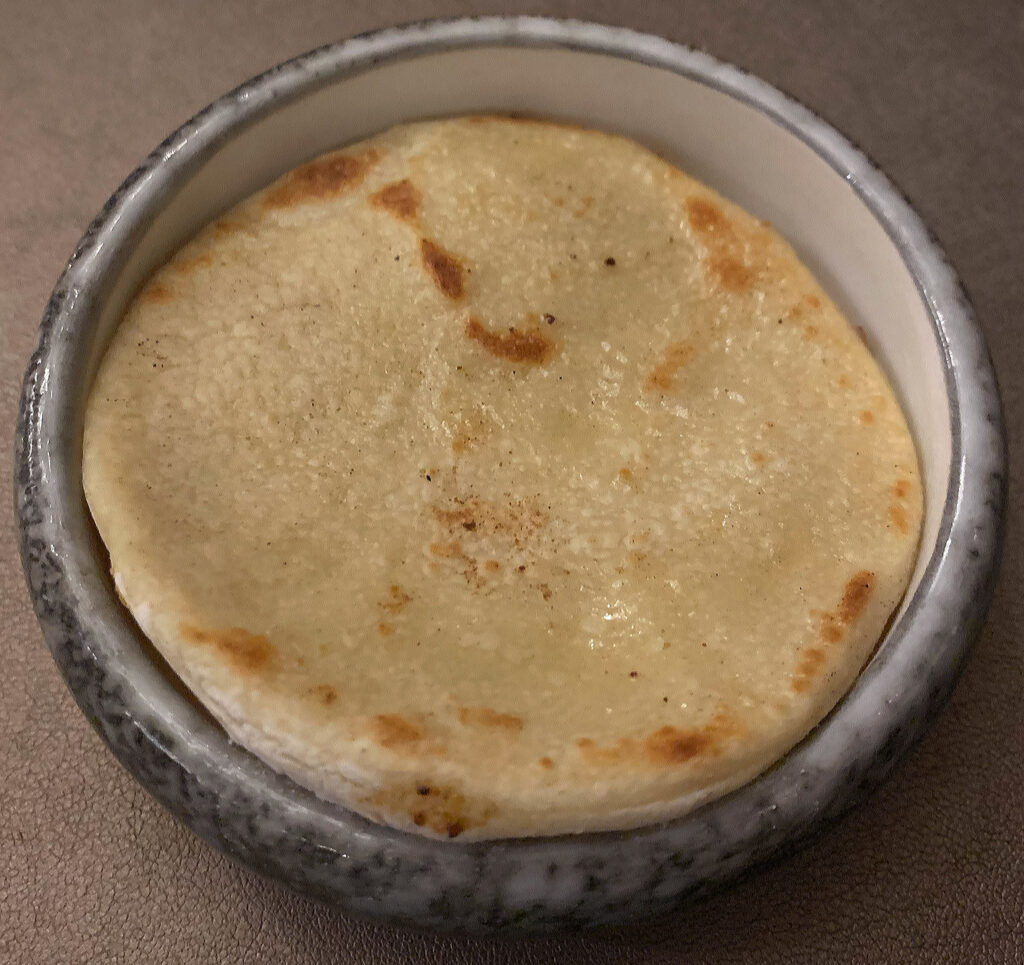
For what it’s worth, the naan seems just a bit underdone and bland when eaten alone. Yet, combined with the curry, the flatbread makes for a soft, deliciously soaked sidecar to the principal protein. Overall, the “Halibut” succeeds on account of its fillet’s texture and the curry’s pronounced (but still approachable) flavor. The resulting combination of tenderness and intensity will even impress those who are not otherwise inclined to opt for fish. However, the preparation also stands as an example of how much Sepia subverts the expectations of guests who come expecting comparably plain cuisine. (Would a “Proxi version” of this same dish simply opt for more pronounced spice?) Either way, this is good work.
Next, in the “Grilled Short Rib,” you find a third course option that seems set to attract the carnivores, the fine dining skeptics, the bold red wine drinkers, and all manner of customers who might want to play things a little safe. Of course, you cannot fault that logic. If a guest is already outside of their comfort zone, they should do everything they can to find pleasure in the dining experience. And beef, with (sweet) potatoes, mushrooms, and a brown butter jus sounds like a sure thing. Not only that, it carries all the promise of a Michelin-caliber grill out.
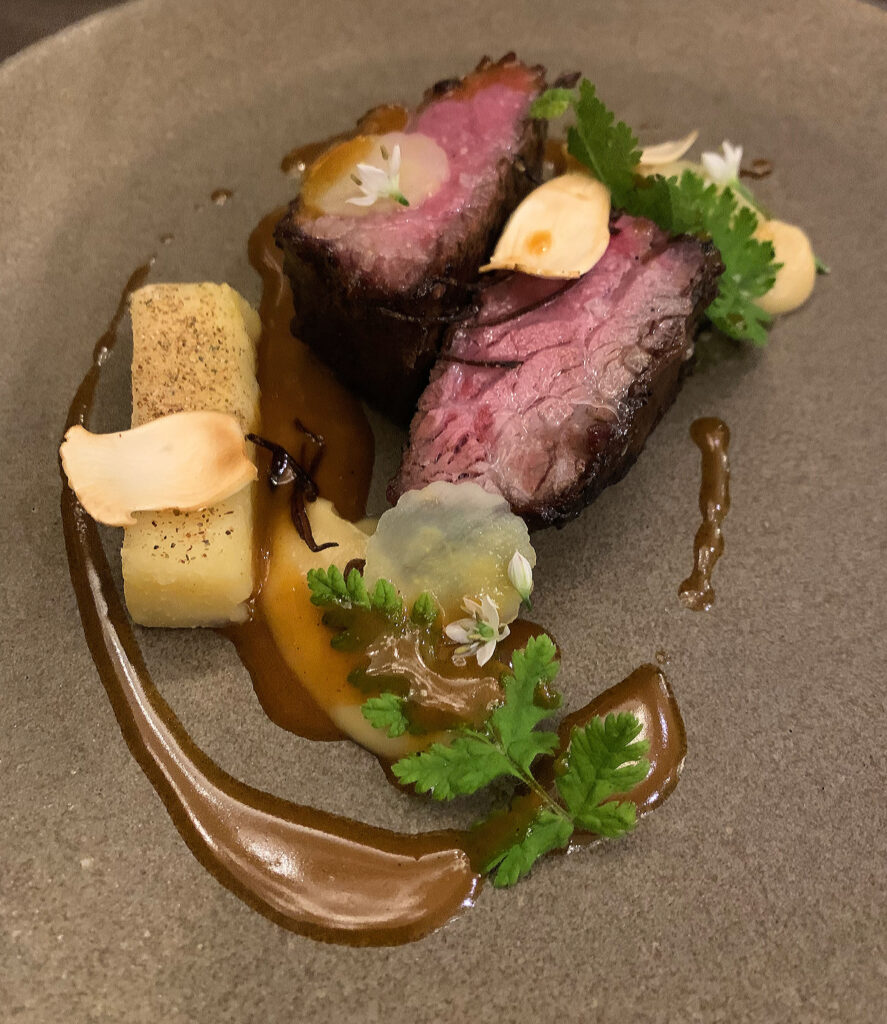
The dish comprises two large chunks of short rib that have been freed from the bone and boast a deeply browned, bordering on charred crust with a greyish-pink interior. The meat is topped with thin slices of matsutake mushroom and flanked by dollops of sweet potato purée. There is also, off to one side, what looks like more of a pavé (also made from sweet potato). Finally, the brown butter jus is strewn across the plate and joined by a couple sprigs of parsley.
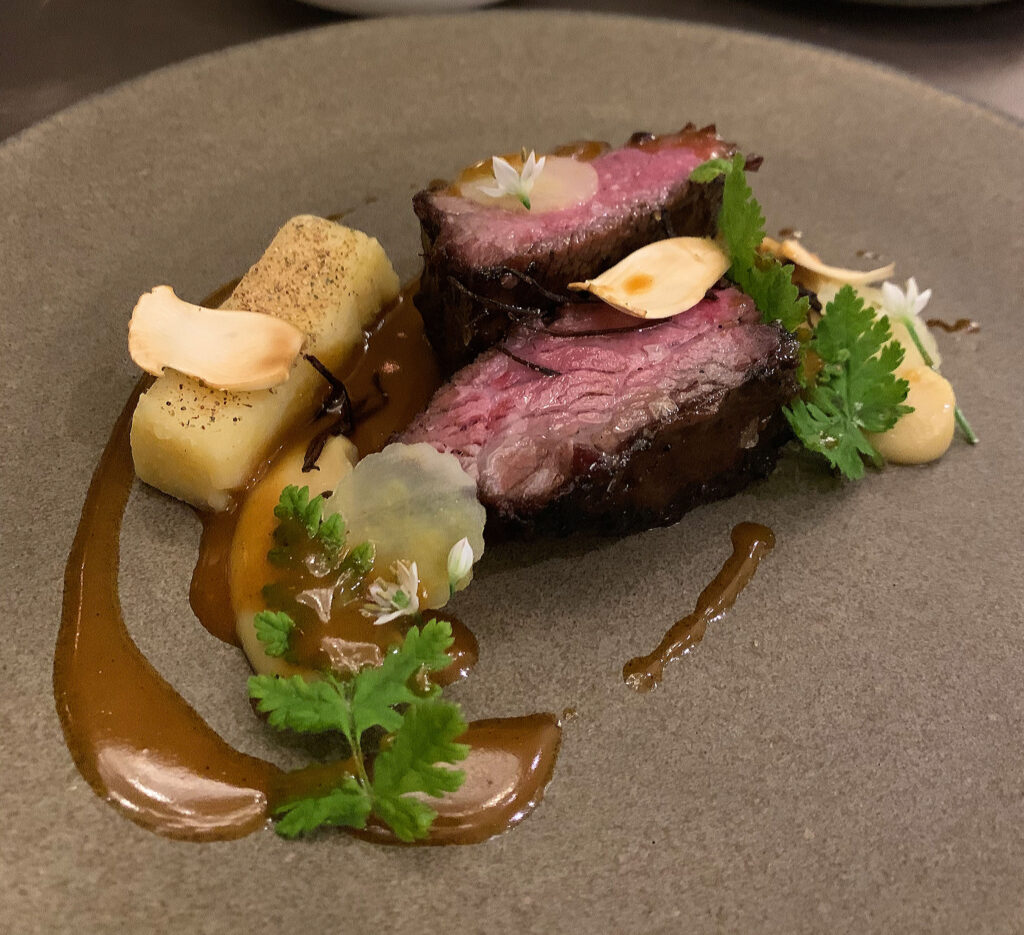
Attacking the beef with fork and knife, you find the flesh to be rather dense. You hesitate to use the word “dry,” but, as it reaches your palate, this short rib is undoubtedly more about chew than melt-in-your-mouth decadence. For dedicated steak eaters, this sensation may be attractive. Otherwise, the mushrooms are faintly crisp and the expressions of sweet potato rather smooth. The focus, texturally, remains on meat while the brown butter jus—not too bold but pleasantly savory—provides the bulk of the flavoring. Ultimately, this is not a bad dish by any means; however, it is the only one throughout all three of your meals that has failed to measure up to the high standard set by the kitchen. Maybe, with the right wine (or for someone who is wary of the other entrée options), this kind of substantial mouthful may be appealing.
Thankfully, the last of the third course items you have sampled represents a return to form. The “Dry Aged Rohan Duck,” offered across your three visits in two different forms, focuses on a piece of game that naturally carries all kind of French fine dining associations. To that point, the bird may not quite appeal to the same carnivores drawn to that short rib; however, any gourmand knows that this dish promises the highest expression of the kitchen’s technique.
In its first guise, the duck has comprised one long strip of reddish-pink breast complete with a crispy layer of skin and a sprinkle of flaky salt. It has been joined by a pool of “root beer jus” and accompanied by a cherry-duck jam “corndog.”
Wielding your knife, the duck’s skin crackles cleanly and yields to an interior that, on the palate, displays just the right amount of chew with a wonderful, meaty persistence (the sprinkling of salt here is so effective). While the root beer jus coats the flesh with subtle notes of sassafras, vanilla, and caramel, the “corndog” is a real surprise. In effect, it is more like a croquette with its crisp crumb coating and shredded meat interior. The filling’s combination of intensely flavored duck jam and cherry echoes the notes of the breast and jus. Doing so, it drives the dish’s sense of decadence ever higher. In sum, this is a playful, technically precise preparation that reveals just how masterfully Zimmerman can riff on an otherwise stuffy ingredient.
In its second iteration, the bird takes the form of two larger, thicker segments of breast drowned in a salsa matcha. Off to the side, butternut squash is rendered both as a purée and a pavé while, in an accompanying bowl, sits a duck adobo empanada.
When it reaches your mouth, the meat is once more tender. The crispness of its skin is a little less pronounced; however, the varied seeds studded within the salsa matcha help to provide their own layer of crunch. Likewise, the sauce—relative to that root beer jus—offers a bit more intensity thanks to its nutty, spicy tones. At the same time, the servings of butternut squash serve to cool everything down and accentuate an earthy sweetness. While that empanada boasts a nice golden-brown crust, its duck adobo filling has sadly been dry on two occasions. Thankfully, the breast meat and salsa matcha do enough ensure the dish is generally enjoyable. With a bit more precision (when it comes to the empanada), this dish could be a worthy successor to the root beer/corndog version that preceded it.
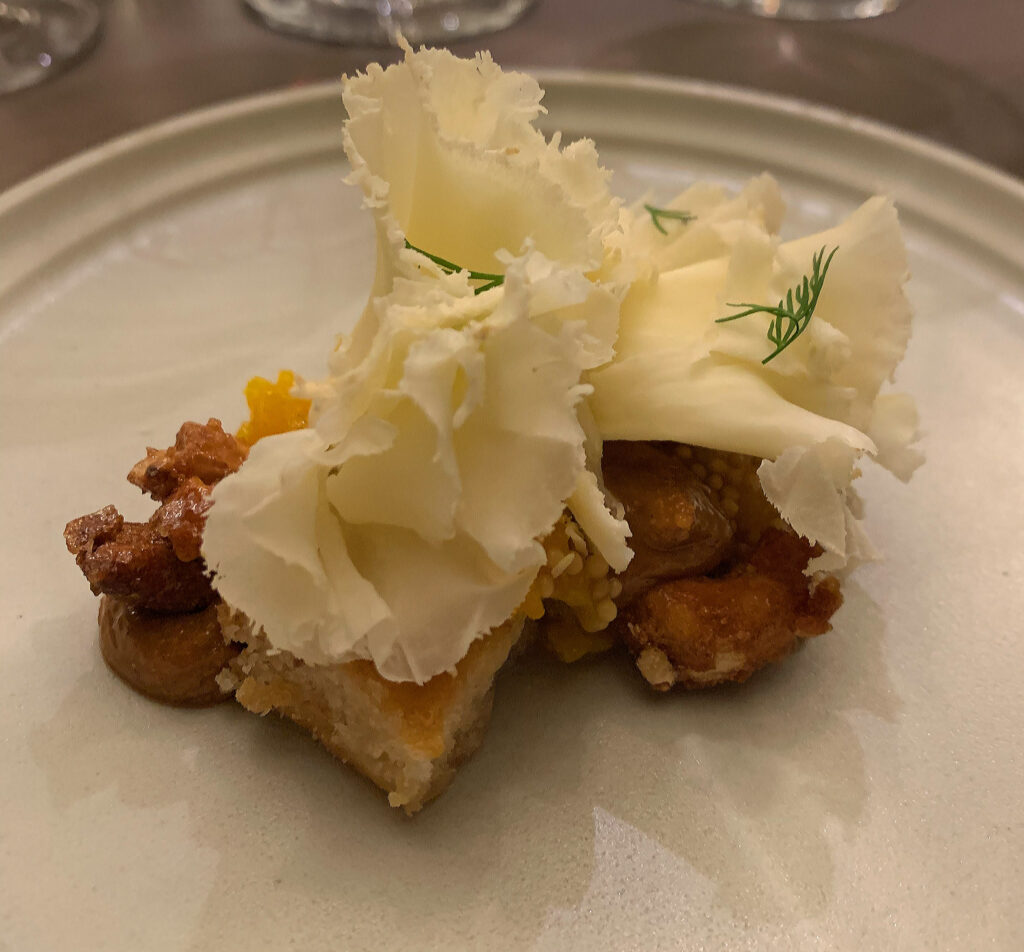
Leaving the savory side of the menu behind, you come to the second supplementary course offered by Sepia: a presentation of cheese. The “Tête de Moine” ($16) centers on thin ribbons of the unpasteurized, raw cow’s milk cheese sourced from the Swiss Jura. Garnished with a couple sprigs of dill, they sit atop a cashew financier alongside some candied cashews, mustard seeds, and an apricot chutney.
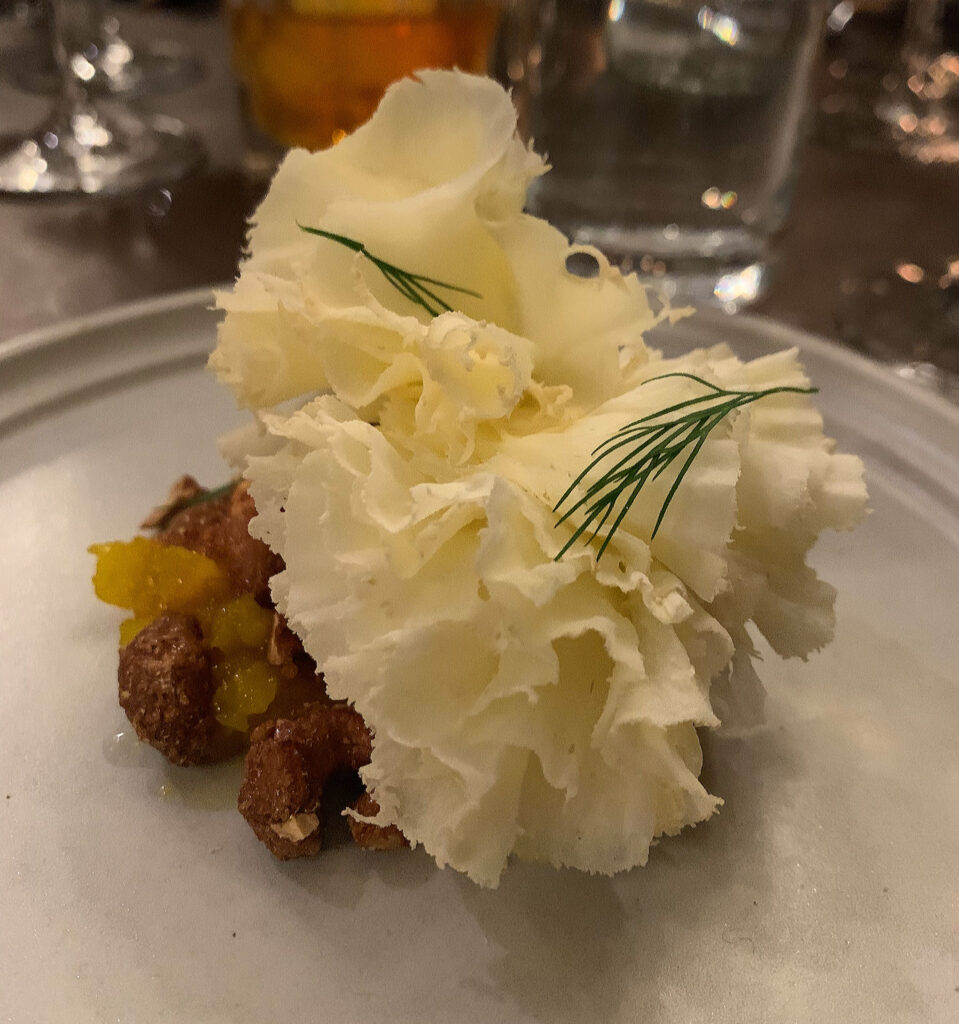
Retrieving a complete bite, the thin segments of tête de moine melt into the fluffy financier and combine with the gooey coating of chutney. When the candied cashew pieces arrive, they expectedly offer a pronounced, brittle crunch. However, as these elements meld on your palate, the most superlative flavor takes hold: creamy, fruity, and nutty on entry, then sweet and nutty, then tangy-sweet, and—finally—caramelized (and also nutty). Though this all almost sounds like too much of a good thing, the dill and mustard seed (strange bedfellows on paper) provide alleviating notes of anise and pungency that help to balance the dish’s pure hedonism.
Quite simply, the level of concentration the “Tête de Moine” achieves is immense and remains perceivable over a two-minute-long finish. The composition does not only form a dream pairing with Ring’s dessert wines (to say nothing of that vin jaune) but ranks as one of the best things you have eaten all year. Receiving consistent tasting notes across all three visits, this dish is superlative (and, it goes without saying, well worth the added fee).
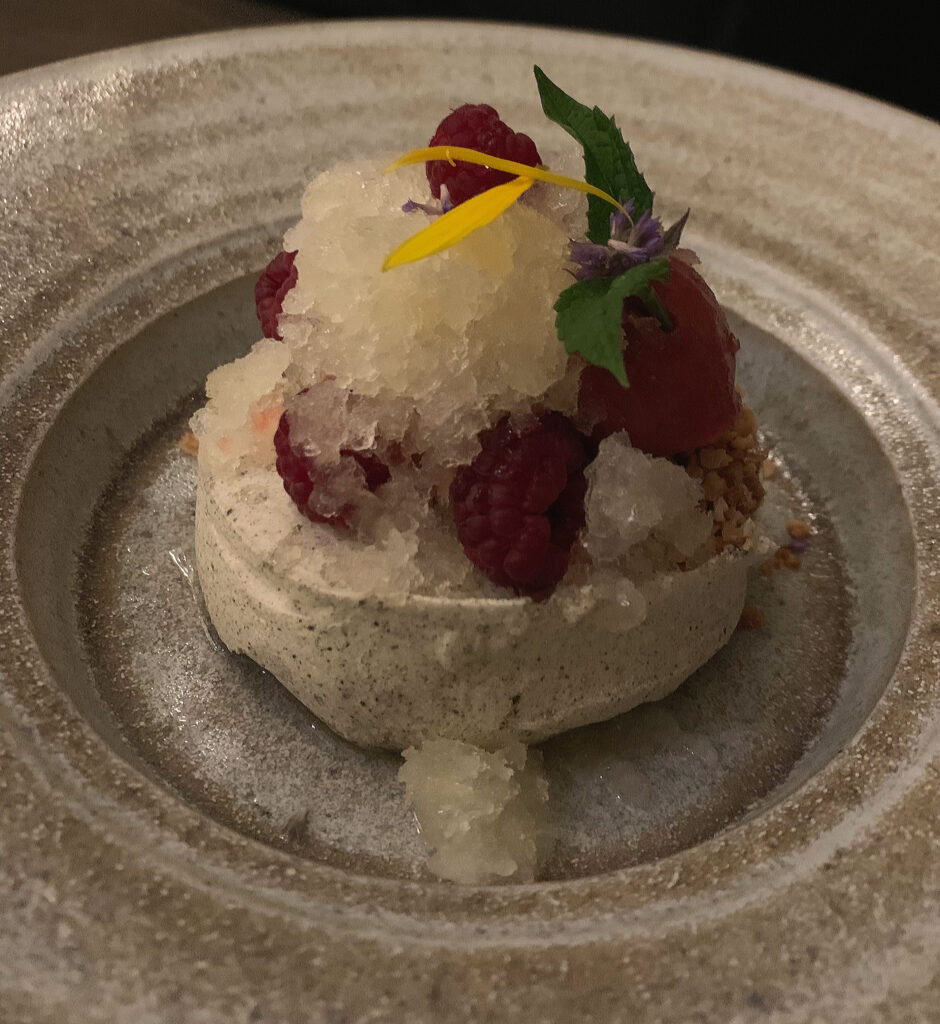
Though you suspect Kobler has something to do with that cashew financier, you now—at last—find yourself firmly in the pastry chef’s territory. The first dessert you have sampled, a “Black Licorice Pavlova,” marries crisp meringue with coconut Bavarian cream, a handful of black raspberries, a quenelle of black raspberry sorbet, and a topping of anise hyssop granita.
Using your spoon, the pavlova shatters with a clean, satisfying crunch. This allows the inner cream to mix with the fruit and frozen elements to form a complete bite. On the palate, everything seems to melt until you hit the crisp meringue and the plump, gushing raspberries. The Bavarian, too, shows some weight and staying power on the tongue. In terms of flavor, the sweet-tart fruit displays an intriguing carbonic, “bubble gum” quality that works surprisingly well with the double dose of anise. Meanwhile, the coconut cream does just enough to ensure the dish feels rich and satisfying (rather than more of palate cleanser). You are not all that partial to pavlova, but this is nice!
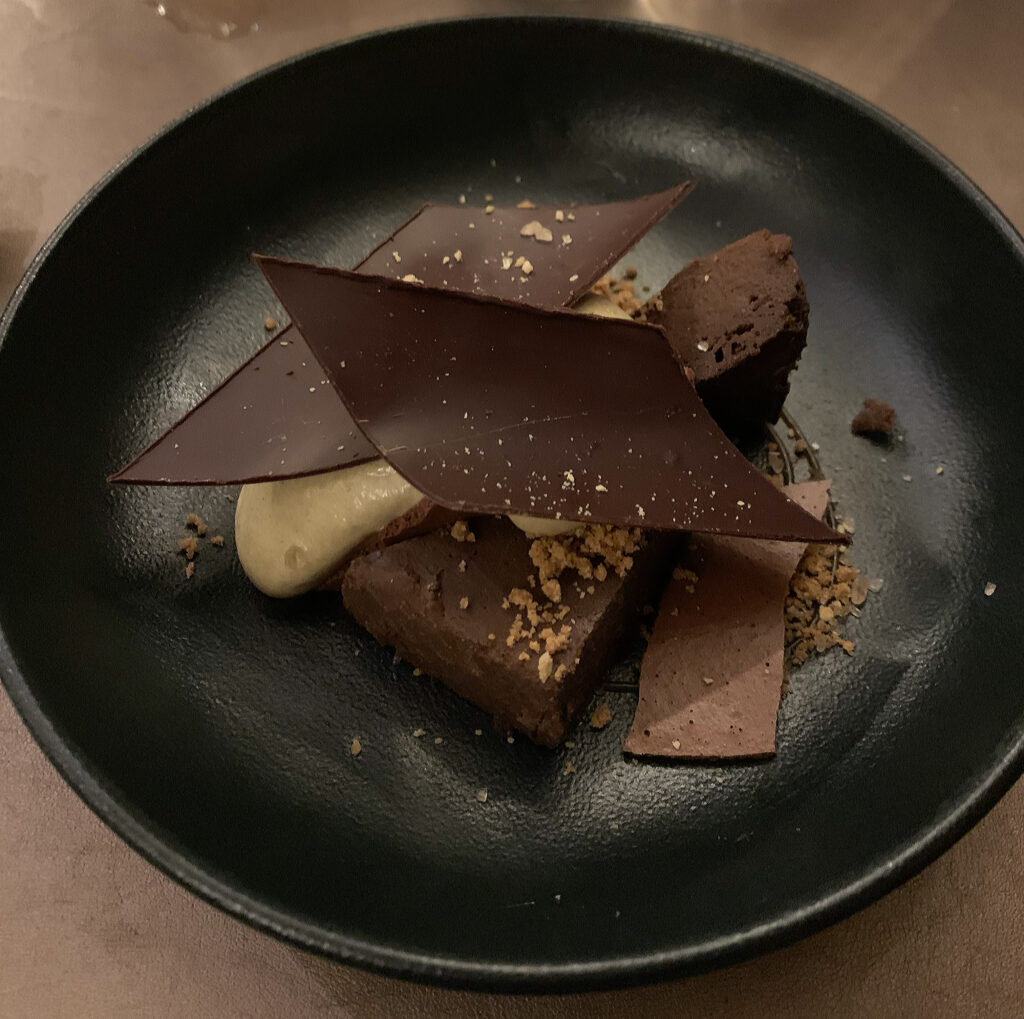
Turning toward the more decadent side, you next encounter a “Dark Chocolate Marquise.” The dessert centers on a couple pieces of rich fondant paired with crème fraîche ice cream (dressed with smoked caramel sauce) and a hōjicha (or roasted green tea) sabayon. A maple crumble sits at the bottom of the bowl while, atop the marquise, you find a couple thick shavings of the same Komuntu 80% blend used to make it (sprinkled with flaky salt).
While this dish seems like an easy choice for chocolate lovers, it pulls off an interesting balancing act. Texturally, the preparation is simple enough: thick, creamy fondant being paired with melting ice cream, airy sabayon, crisp maple crumble, and the snap of the Komuntu shard topping. However, in terms of flavor, the recipe wholeheartedly embraces bitter, toasted notes of chocolate (and tea) that are only rescued by a bit of sweetness, tang, and buttery caramel on the finish. Diners expecting a pure expression of pleasure may want to beware, but the juxtaposition works. This is an intelligent—and still quite enjoyable—expression of truly dark chocolate.
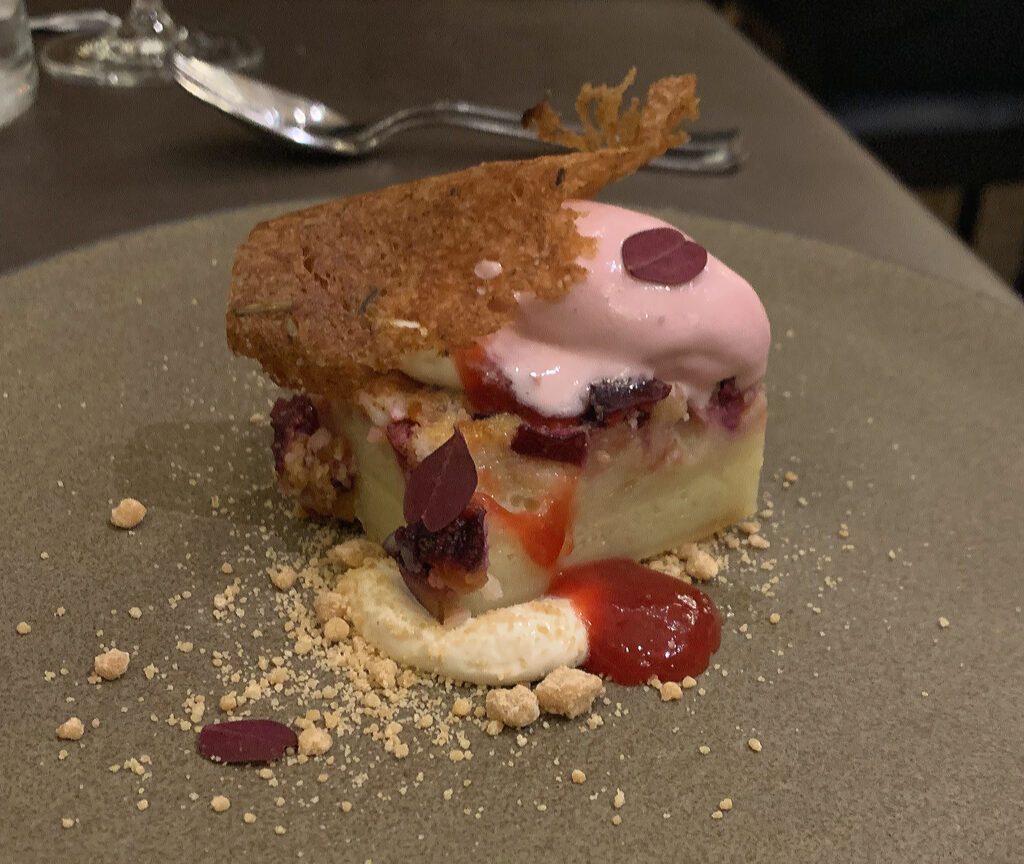
With the “Mick Klug Plum Clafoutis,” you return to another expression of fruit. The dish centers on a base of a crustless, custardy tart (the clafoutis) that is flavored with cardamom. Chunks of the titular plum are interlaced throughout the preparation and also serve to flavor an accompanying frozen yogurt. An almond milk sorbet forms the finishing touch along with a crispy tuile topper and some Dulcey 35% crumble.
Approaching the dish with fork and spoon, you are impressed by the soft, rich mouthfeel of the clafoutis. The crustless tart serves to cushion the melting froyo and sorbet elements while also withstanding the crunchier elements. As the delicately sweetened custard spreads across your tongue, the sweet-tart flavor of the plum comes to the fore. The fruit, nonetheless, does not overwhelm the other ingredients. Rather, the nutty note of almond milk, warming cardamom, and biscuity Dulcey chocolate served to moderate the plum and build to a pleasing richness. Yes, the clafoutis may ultimately be the star of the recipe, embodying the subtle (but deep) sweetness you so enjoy from cheesecakes, crème brûlée, and the like. This is beautifully done by Kobler and ranks as one her best creations.
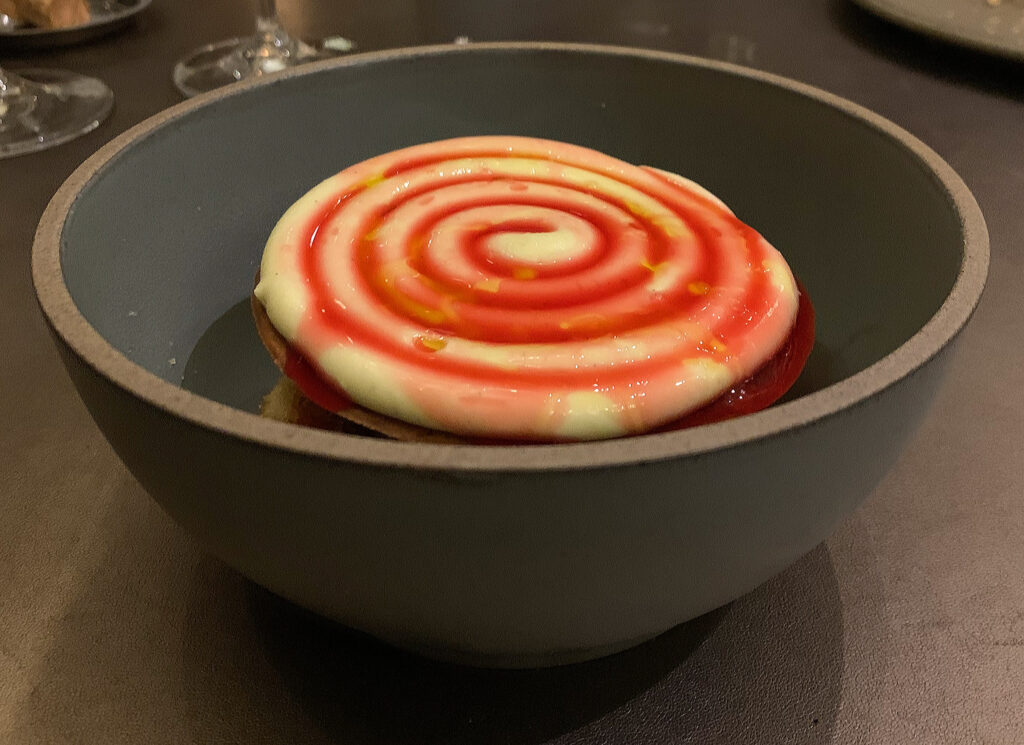
Competing for that top spot, undoubtedly, is the “Local Melon Parfait”—another deceptively simple dessert. Here, layers of crispy olive oil cake are joined by melon sorbet, some melon jam, and pieces of candied ginger at the bottom of a bowl. The combination is topped by a circular wafer on which has been piped a spiral of olive oil and lime leaf crémeux. After being drizzled with more olive oil and dusted with flaky salt, a melon consommé is poured tableside to complete the presentation.
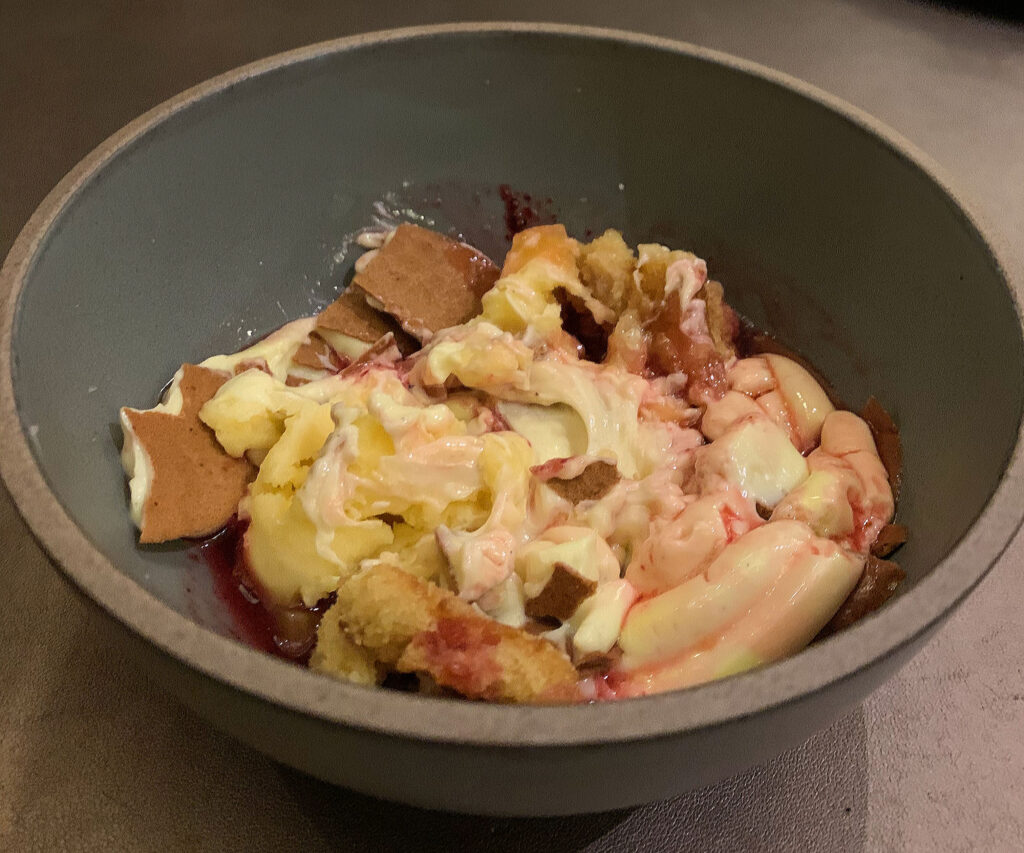
Using your spoon, you break through the parfait’s top layer and combine the luscious crémeux with the crumbled wafer, bits of olive oil cake, and sorbet. The resulting bites are cool and slick on the tongue—sometimes offset by gooey jam or chewy ginger—but buttressed by the foundation provided by the drier layers. When it comes to flavor, the melon is surprisingly rich and deep in its expression with barely any hint of acid. This helps it to meld with the buttery fruit tones of the olive oil and leaves only the spicy candied ginger and citric lime leaf as the major contrasting elements. Overall, this dish is far more mellow and satisfying than you would ever expect. It honors the local melons by incorporating them into what amounts to a frosted olive oil cake, leaving you with a memorable musky-sweet finish. This is another hit from the pastry chef.
The “Local Melon Parfait” would, subsequently, be replaced by a “Butter Braised Pineapple Parfait” that largely takes the same form apart from also introducing notes of passionfruit. This iteration displays a kindred richness with pleasing honeycomb note added to the mix. Nonetheless, despite your deep love of pineapple, the fruit’s more pronounced tang robs the preparation of a bit of the predecessor’s depth and length. It is still a good dessert—just one that suffers a bit by comparison.
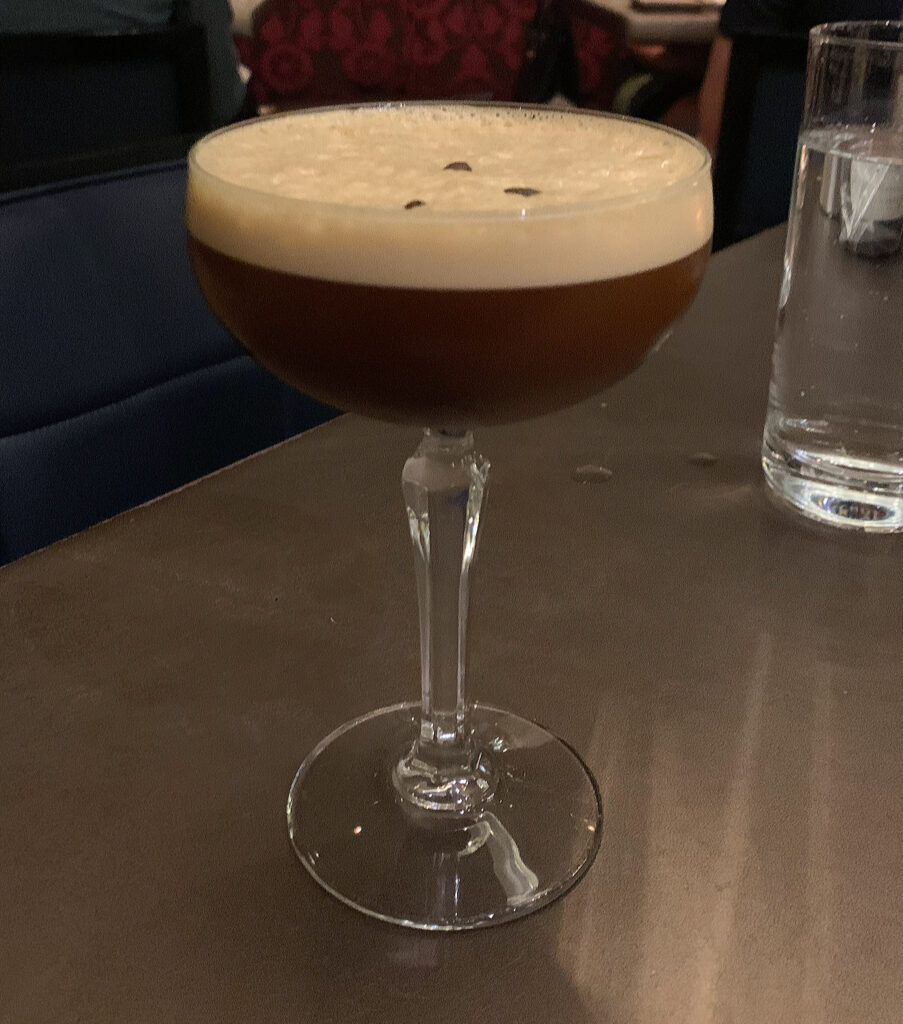
With that, you have worked your way through the fourth course and careen toward the end of the evening. Along the way, you might enjoy an “Espresso Martini” prepared by Meicher (deep with coffee flavor and not a trace of bitterness).
Otherwise, along with the check, Kobler offers a couple final mignardises/petit fours. Of these, a miso-chocolate truffle was great, a rhubarb marshmallow good, a chocolate cheesecake profiterole also good (though you expected more), and an espresso nougat just a bit too bitter.
With these final, fleeting sweets and a heartfelt goodbye from your server, you settle the bill. There’s no service charge nonsense to speak of (apart from a more traditional 20% assessed for parties of six or more), but a 3% surcharge is added “to assist in covering the costs of health insurance” for Sepia’s employees. When you consider how many restaurants tack on a similar fee for “rising costs associated with the restaurant (food, beverage, labor, benefits, supplies),” this narrower focus—more specifically attuned to supporting the staff’s quality of life—feels easier to stomach. Such fees were already being included before the pandemic, and, here, you retain full discretion for the rest of the gratuity. Fair enough, you say.
At last, you take leave of the table and trace a path through the dining room, past the bar, the host stand (where you are met with one more farewell), then out through the door. Under cover of darkness, you walk north toward Randolph and feel the neighborhood’s pulsating energy. Proxi, Alla Vita, and CH Distillery are humming along with their respective crowds of young urban professional patrons. To the west, over the crest of the highway overpass, you can just about make out the real heart of the action.
But—well fed, well lubricated, and well taken care of—you turn back around. Sauntering again down Jefferson, you gaze knowingly at Sepia’s timeworn edifice: a fine dining temple hiding in plain sight, the most unassuming—yet enduring—of Chicago’s refined “contemporary American” restaurants. With deep contentment (and secure in the fact you will meet again), you leave West Loop’s frivolity behind and disappear into the night.
In the final analysis, as you cap off this series of articles on the city’s Michelin-starred “contemporary American” stalwarts, you find yourself dwelling on the influence ownership has. Maybe such a realization seems obvious: who else really has skin in the game and must, as a consequence, rise to the occasion of steering the ship? Yet, as restaurateurs increasingly become celebrity figures in their own right, it is easy to take Bibendum’s plaudits as a bulletproof indicator of success.
Yes, earning that Michelin star is a ticket to the big leagues, to building a personal brand, to taking the stage as a renowned “hospitalitarian” who is ready to share their secrets with leaders of other industries. Somewhere along the way, these owners get grandfathered into a certain status that no longer has any relation to the quality of their establishments on the ground. Bibendum, after all, is loath to take away stars so long as you do the bare minimum to glorify his brand. So the consumer, as always, is left to discern through their own painful (and expensive) experience if they are dealing with a real luminary or a wolf in sheep’s clothing.
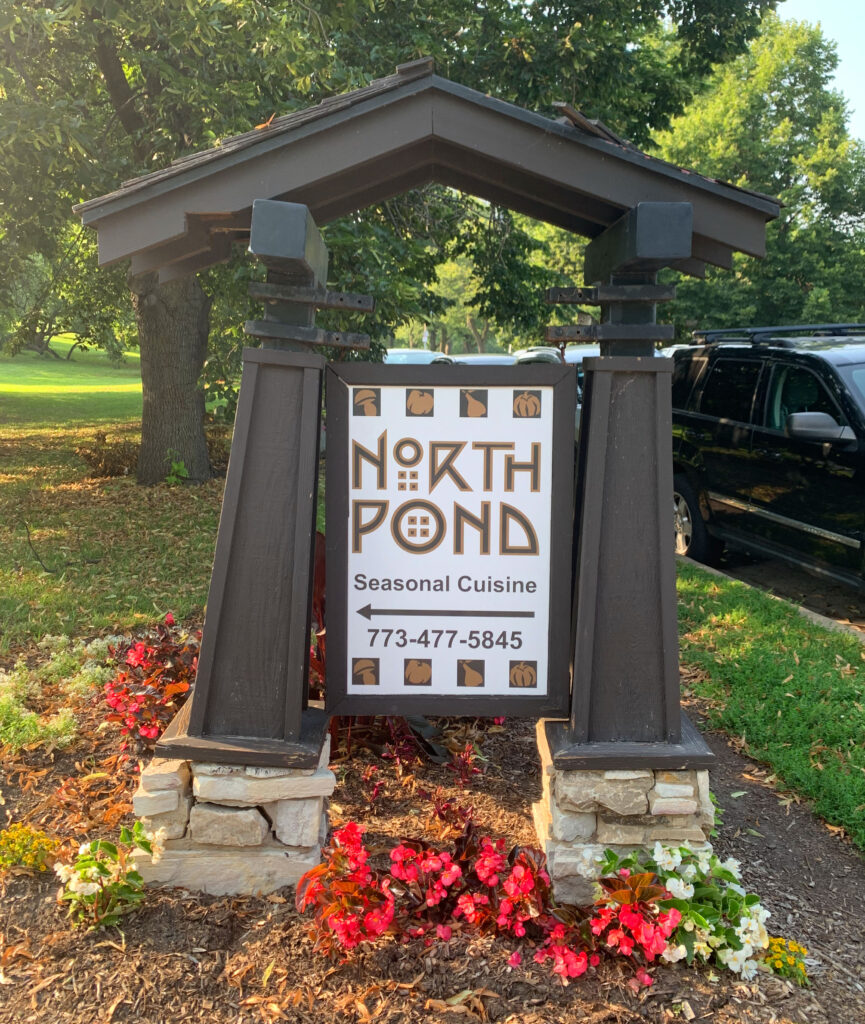
To be more specific, you think back to North Pond: opened in 1998 by Richard Mott, a college concessions mogul and “hearty eater but not a foodie,” who sought to expand into a higher expression of dining. Though he also opened Jackson Harbor Grill around the same time, North Pond would prove to be the lone, longstanding crown jewel. Mott invested in the old warming shelter’s renovation and provided chef Bruce Sherman (who responded to a “blind ad” in the Tribune) with the time and space to develop his forward-thinking, locally-sourced, hyperseasonal cuisine. Along the way, they built a small but mighty cellar of wines offered at the most minimal markups. It would take four editions of the Guide before Michelin finally came calling, but, by then, Mott and Sherman had already turned North Pond into one of the city’s premier spots to celebrate. Now, on the other side of the pandemic, the restaurant continues to chart a bold course under chef César Murillo. He needs time to grow in this role, but the philosophy and overall value proposition remain the same.
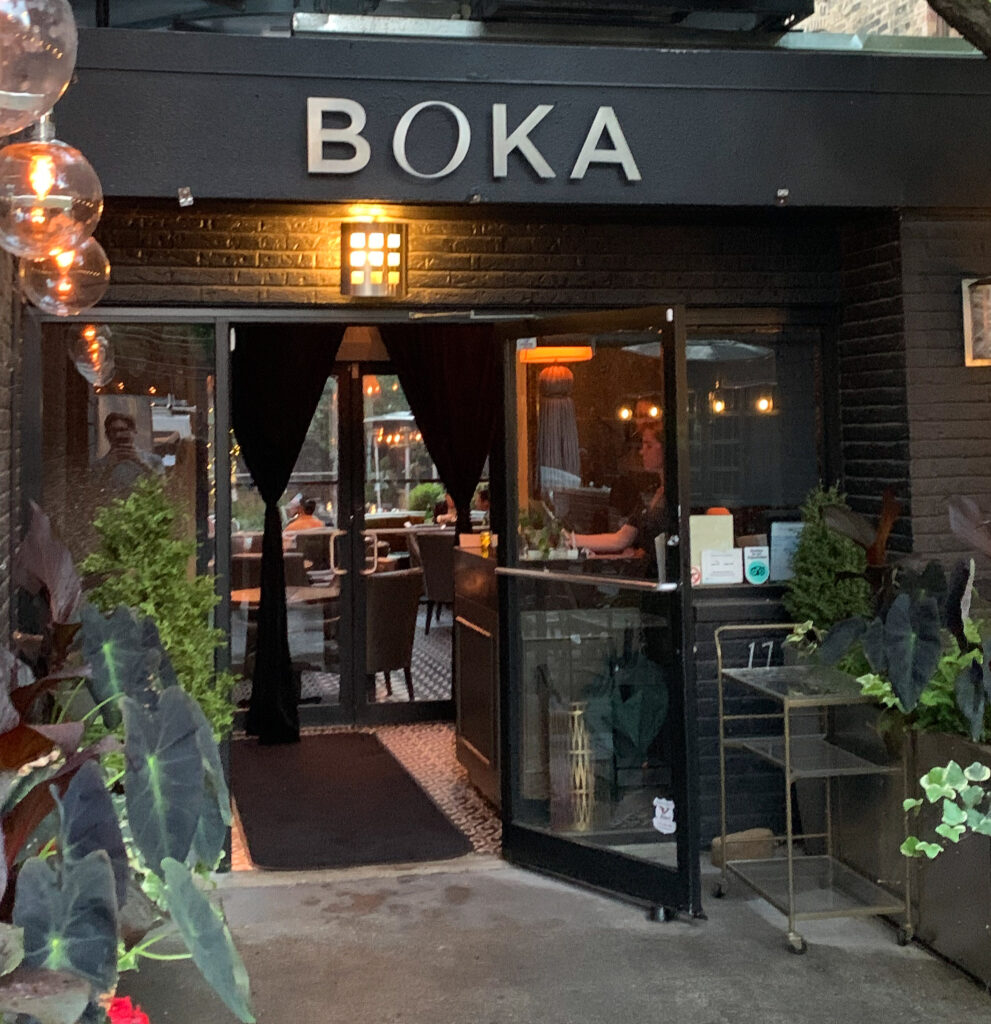
By comparison, Boka (opened in 2003) was hatched by restaurateurs who had each cut their teeth operating multiple bars. Joining forces, Kevin Boehm and Rob Katz developed the property that would become their group’s namesake as a “hip counterpart” to the nearby Steppenwolf Theatre that landed somewhere between the “ultra fine dining” and “ultra casual” concepts in the area. Taking inspiration from Gramercy Tavern, they hired chef Giuseppe Scurato (having posted an ad in the Chicago Reader) to launch the restaurant with “ambitious but tastefully restrained” fare. After three-and-a-half years, Boka’s “pivotal moment” would arrive as Boehm and Katz stole Charlie Trotter’s chef de cuisine away. Giuseppe Tentori would make the concept’s name with “progressive American cuisine” and menu changes “every two weeks or so.” The chef earned a Michelin star in Bibendum’s inaugural guide and would stay on for six years. By the time Tentori left (in 2014), BRG had other hits like Girl & the Goat on their hands. In hiring Lee Wolen, Boehm and Katz sought to transition Boka away from being a “special occasion restaurant” toward becoming a simpler neighborhood spot. This, no doubt, would facilitate BRG’s further growth as their flagship began serving the same recipes, year after year, and raising markups on wine. On the other side of the pandemic (having sold off much of its cellar), Boka is but a husk of itself. Boehm and Katz have sold out to Levy while haphazardly pursuing personal projects and even further expansion. They trade on the fame that Michelin star entails while leaving consumers increasingly disappointed.
With Sepia—and Emmanuel Nony—you find the culmination of a long career in hospitality that started in France, made its way to Disney World, and distinguished itself at Park Hyatt properties in New York, Hong Kong, Seoul, Fukuoka, and Tokyo. The restaurateur got to know Chicago via the city’s own Park Hyatt and its restaurant NoMI before setting down roots. Under opening chef Kendal Duque, Sepia was already a success; however, with the arrival Andrew Zimmerman, the concept hit its stride. Nony earned his Michelin star in the inaugural Chicago guide and built one of the city’s greatest wine lists by fostering a succession of top sommeliers. Bibendum’s honor spurred some minor changes, but Sepia’s core identity remined the same. Zimmerman became a partner, yet the team was careful not to expand too quickly. A private event space and, later, Proxi were natural spin-offs on the same block. The chef continued to evolve his style, redefining just what “contemporary American” cuisine meant over more than a decade, and empowered chefs de cuisine and pastry chefs to explore their own perspectives. While the pandemic led to the demise of lunch service and the à la carte menu, much of the core staff was—along with the wine cellar—preserved.
At 16 years of age, Sepia is the best it has ever been. You can call the restaurant’s interior dated (others might say “timeless”) and the concept’s wider identity too undefined or unfashionable. It may be thought of, in the most cynical terms, as one of the city’s entry-level, (relative) bargain examples of fine dining. But Nony demonstrates his pedigree by how steadfastly he has preserved the foundations of a great gastronomic experience. Yes, beneath any surface-level absence of viral appeal or molecular “smoke and mirrors,” you find an unerring mastery of the real fundamentals.
Sepia is defined by an approachable, functional space that facilitates conversation and connection with your guests. That environment is matched by sharp, deferential service that rewards repeat patronage through a reflexive, responsive approach to the craft that has become all too rare. Your admiration for the beverage program has already been exhaustively stated, but, now under Ring (and maintaining some of the lowest markups in the city), it is second to none at the one-Michelin-star level.
These elements carry Sepia quite a long way toward greatness, but what distinguishes the restaurant from North Pond, which can claim many of the same strengths while also boasting an incomparable setting?
Zimmerman’s cuisine is simply more wide-ranging and truly “contemporary” than nearly all of his peers (you only think Oriole and Smyth delve even further into developing a singular vision of American cuisine). The continual growth of the chef’s style is clear when looking across those many years of menus, and you come to view him—like Sherman—as a craftsman who has led the public toward new frontiers rather than sitting back and “playing the hits” over and over. In some sense, the beauty of Sepia’s “ordinary” setting and lack of obvious frills is that they disarm the mainstream consumer and induce them to take a chance on a dish drawing on some cultural influence (Indian, Japanese, Mexican, Vietnamese) they would otherwise never gravitate toward. Just the same, Zimmerman often opts purely for comfort and nostalgia and delivers them in spades. This is the essence of what it means to trust the chef (and the overall establishment), and it stands as some of the most essential work in growing gastronomic appreciation within a dining scene.
More particularly, you must praise the work of chef de cuisine Kyle Cottle, who (your server revealed) is consciously inspired by the intensity of flavor found in fast food. Of course, he achieves this kind of concentration through careful balancing of fresh ingredients. However, as a stylistic choice, Cottle’s pursuit of hedonism strikes you as essential in an era when younger generations—many being more exposed to processed foods than their parents—are entering the world of fine dining at an earlier age. His food smacks of the kind of depth and power you typically only sense at places like Kyōten, Oriole, and Smyth, and the associated textures (crispy, crunchy, melty, tender) measure up too.
Just the same, you cannot neglect Erin Kobler’s work, which displays much of the same intensity and a consistent quality across all of the desserts the restaurant offers. (You think only Elske maintains such a high “batting average” in its pastry department.)
While, in particular, dishes like the “Barbeque Pork Collar,” “Roasted Foie Gras,” “Sourdough Cavatelli,” “Halibut,” “Dry Aged Rohan Duck” (the root beer/corndog version), “Tête de Moine,” “Mick Klug Plum Clafoutis,” and “Local Melon Parfait” impressed you most, the standard of work here is high across the board. (The “Grilled Short Rib,” as you noted, was the only slight disappointment.) Some of this, surely, has to do with the limited number of choices available in the prix-fixe format. However, Sepia does tend to add new dishes every few weeks (changing the menu more fully with the shift in seasons) and deserves credit for balancing overall strength with a certain degree of dynamism.
When you combine all of these attributes, you are left with a restaurant that sneakily manages expectations on the surface but blows you away in actuality. In that sense, Sepia really represents an inversion of the “style over substance” model adopted by so many operators today. However, in truth, Nony and Zimmerman are simply defending what has always made gastronomy great: bold, multidimensional cooking joined by a celebratory approach to wine and effortlessly warm service.
Sepia is a place—then, now, and forever—to make memories and forge the human connections that imbue hospitality with meaning. The restaurant, in its advanced age, transcends the quotidian concerns of a mere business. It stands as one of the greatest restaurants in Chicago’s history.


